Japan vs South Korea: which impressive East Asian destination should you visit?

Apr 28, 2023 • 6 min read
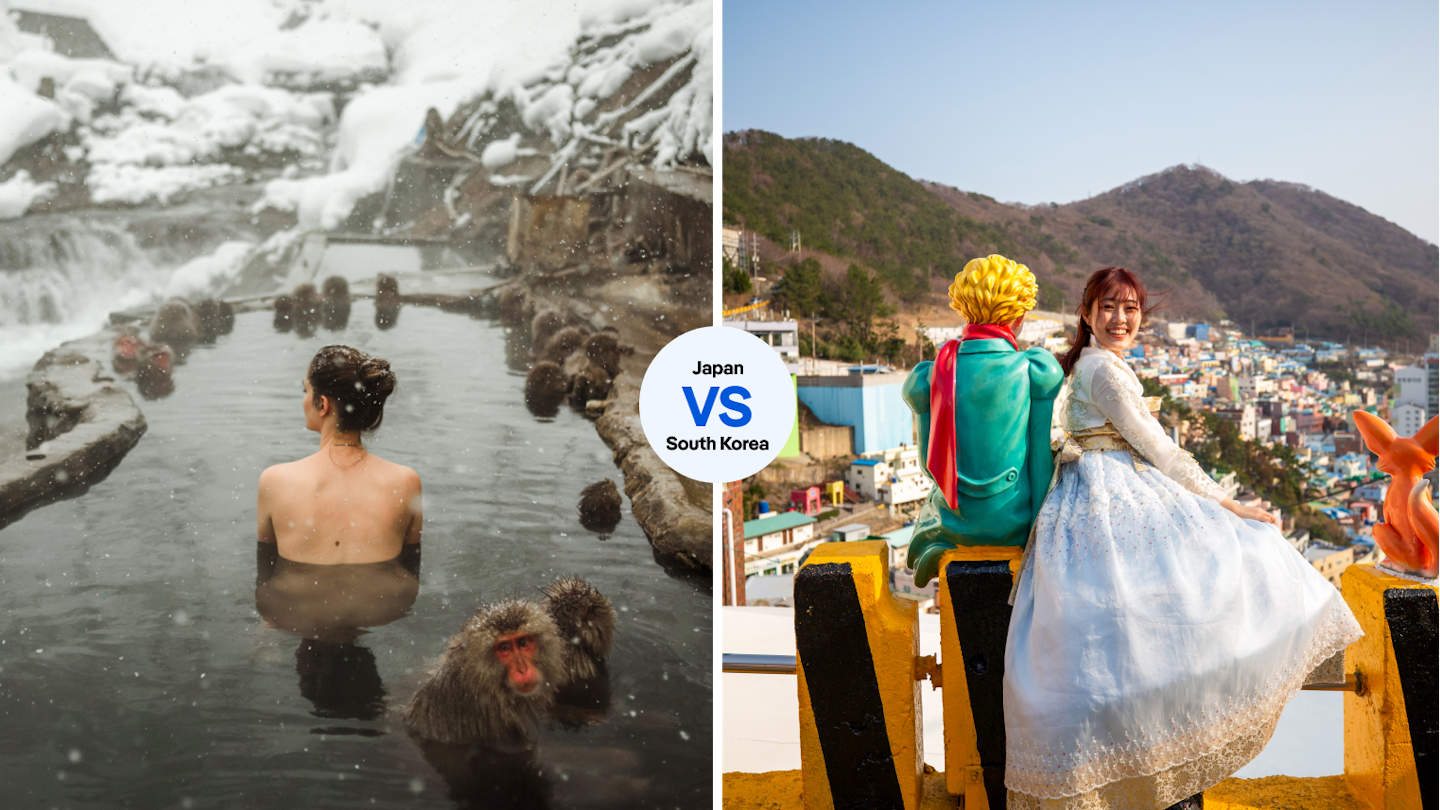
Take the plunge at a Japanese onsen, or join the hallyu (“Korean Wave”)? © Stocksy; Xinhua News Agency/Getty Images
At the easterly side of East Asia, Japan and South Korea are perennial favorites of savvy travelers – and for good reason.
But if you had to choose just one (we’re sorry), which one would get the nod? Below, two of our regular writers on the region make the case for their favorite.

It’s just Japan
Regular Japan visitor and rail expert John Walton expounds on the many ways – both fast and slow – to explore his favorite country to visit. His top Japanese journeys include following rural rail lines up to relaxing hot spring towns and exploring local foodways.
I’ve traveled in both Japan and South Korea, and both are wonderful. Yet the former is the country I return to again and again.

Japanese trains are irresistible
The incredible railway network that blankets all of Japan is one of the country’s top draws – and wins out over South Korea’s trains, which I’ve also taken. Even with its recent price hikes , the Japan Rail Pass offers a fabulous value for shuttling between cities at up to 200mph (320km/h), relaxing on a comfortable Limited Express, exploring tiny local branch lines or enjoying cultural experience on the special Joyful Train excursion services.
If I had to pick a few favorite train trips, I’d go with the Tohoku Shinkansen’s top-speed section north of Omiya, the single-car branch line between Abashiri and Kushiro in Hokkaido, the Limited Express Yakumo from Okayama to Matsue and the SL Ginga steam trains from Takasaki.

A country for all seasons
Japan is several times the size of South Korea, and crosses a lot more climatic zones – from tropical Okinawa to the northern island of Hokkaido , snowy in winter but delightfully cool in summer.
This means there’s not only simply more to do, but that there’s more variety, as well as a wider range of seasons of pleasant weather.
Since I’m no great fan of the rain and humidity of the tsuyu early-summer season, I’ll head north to Hokkaido then, where the temperatures are balmy but not muggy, to enjoy the freshest of fish in historical Hakodate. Come autumn, I love to head southwest to Kyūshū to extend short-sleeve weather: Kumamoto and Kagoshima are delightfully sunny and warm even into late November.

Relaxing ryokan and onsen culture
Formal appearances can be deceiving: Japanese people love to relax, and they’re great at it. They’re also excited to share their traditions with visitors. Traditional ryokan hotels, especially those with attached onsen hot-spring baths , provide the perfect way to build intensive relaxation time into your trip.
From the moment I arrive at a ryokan , my worries melt away and all I have to think about is what book I want to read sitting by the scenic window in my room. In a picturesque onsen town I fancy going for a little wander in a yukata robe as I ponder which of the often multiple onsen baths I want to slip into to soak away my cares (and relieve my sore traveler muscles). Gunma ’s Kusatsu-Onsen is famous for a reason, yet tiny Bessho Onsen near Ueda in Nagano – up the side of a mountain reached by a tiny private railway – is my favorite hidden gem.
Thousands of onsen can be found around Japan, from the famously beautiful one in Matsuyama that inspired Miyazaki’s Spirited Away to the one inside the railway station at Echigo-Yuzawa. I love dipping my tired toes into one of the stone public foot baths that you’ll find in many tourist areas.

Hiking, skiing and nature
An antidote to a very urbanized society, Japan’s outdoor activities are many and widespread. Once you get out of Japan’s cities, the natural beauty is a stunning surprise – accessible by both Shinkansen and local trains. Hiking is incredibly popular, while so many people love skiing that there is a special seasonal spur of a Shinkansen bullet train line that goes directly to the Gala Yuzawa ski resort .
Don’t miss the gorgeous Sanriku Coast in the Tohoku region, with its rugged yet human-scaled peninsulas and promontories. Rugby-loving Kamaishi or sleepy Miyako, with its stunning Jōdogahama Beach , are great starting points for exploring this region.
If you’re interested in it, Japan has it.
South Korea takes the crown
Tom O’Malley has ventured both north and south of Korea’s DMZ, and worked on the current editions of the Korea and Seoul Lonely Planet guidebooks. His favorite Korean dish is sundubu-jjigae (spicy tofu, pork and kimchi stew).
For this throw down of east versus slightly more east, I’m fighting in the K-corner – though in full disclosure I really love Japan, too. Still, in the spirit of partisanship, here’s my take on why South Korea deserves to be your next adventure destination.

The “It” culture
First, a question: how far would you have gotten in Squid Game ? I reckon I’d have made it past the terrifying giant doll and then died trying to nibble the dalgona (sugar candy biscuit) without it breaking. The fact that you almost certainly know what I’m on about illustrates something: Korean culture is crushing it right now. From Bong Joon-ho’s Parasite winning Best Picture at the Oscars to girl group Blackpink blowing up Coachella, the world can’t get enough of South Korea. It’s a phenomenon dubbed hallyu (the “Korean Wave”), and it’s been building for years.
If you had the chance to time travel back to Belle Époque Paris, say, or London in the swinging ’60s, you’d go, right? Japan peaked in the 1980s before the bubble burst, yet South Korea’s golden age is happening right now. Why not go and be a part of it?

I appreciate that’s all a bit abstract, so let’s go head-to-head, starting with size. Japan is almost four times bigger than South Korea. And while there’s arguably more to see in Japan overall, that’s part of the problem. Itinerary planning is a headache, and getting around is expensive.
No such worries apply in South Korea, however. You can travel the length of the country – from the electric capital Seoul to the bustling southern port city of Busan – in just a couple of hours by high-speed train, with side forays to any number of incredible places, like the ancient tombs and temples of Gyeongju , or the dreamy peaks and waterfalls of Seograksan National Park . Or why not venture right to the edge of North Korea with a trip to the DMZ ?

Fiery flavors
And then there’s the food, to my mind always one of travel’s chief pleasures. Japanese cuisine is elegant, subtle and often…well, raw. Are those really the best food adjectives? Personally, I want my meals to slap me around the face with flavor, heat and spice – and that’s exactly what you get from Korean cuisine.
Whether you’re cooking up galbi (beef short ribs) on a tabletop grill, going hard on chimaek (fried chicken and beer) or slurping down a fiery kimchi-and-pork stew, eating is a hearty, visceral pleasure in Korea. And a word about banchan , those little side dishes of delicious treats you get with most meals: they’re both free and refillable. What’s not to love?

Delightful people
A final word has to go to the true highlight of any trip to South Korea: the Korean people themselves. It’s as if hospitality, helpfulness and respect are hard-wired into their DNA. You can guarantee that as you travel through the country, you’ll have encounters with locals that will leave you feeling that little bit more positive about this planet we all share.
Sure, it could happen in Japan as well, but they’re probably too busy reading manga.
South Korea for the win.
Explore related stories
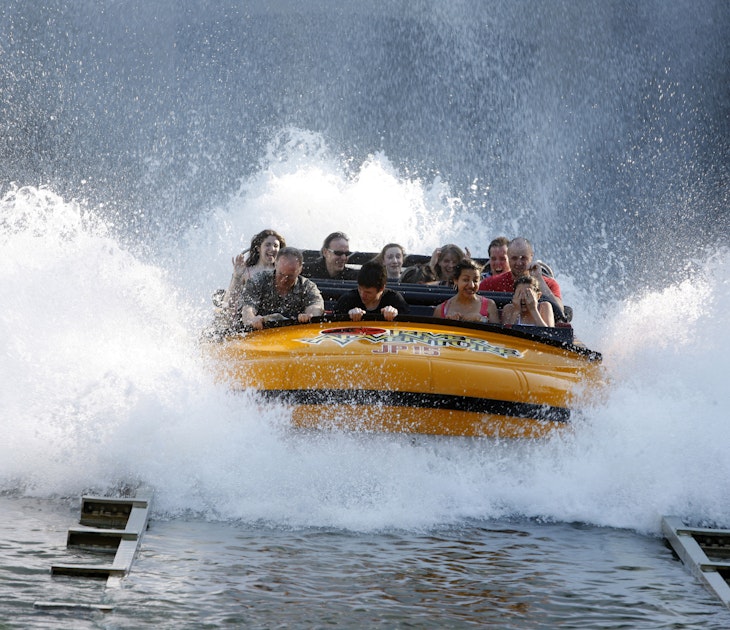
Apr 14, 2024 • 6 min read
Florida is famous for sun and sand, but for many families it's all about the theme parks. Here's our pick of the best theme parks in the Sunshine State.

Mar 31, 2024 • 7 min read

Mar 28, 2024 • 7 min read

Mar 28, 2024 • 6 min read

Mar 26, 2024 • 8 min read

Mar 25, 2024 • 6 min read

Feb 27, 2024 • 6 min read
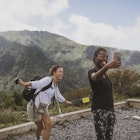
Feb 20, 2024 • 6 min read

Feb 19, 2024 • 8 min read

Japan vs. Korea: A Comprehensive Travel Guide to Help You Decide
- Post author: cuppa
- Post published: January 27, 2024
- Post category: Knowledge Base
Deciding between a trip to Japan or Korea can be quite a pickle! Both countries offer rich cultural experiences, delicious cuisine, and unique attractions. It’s like choosing between two equally tempting dishes on a menu.
Japan, known for its blend of tradition and tech, offers a journey into the future and the past all at once. On the other hand, Korea, with its K-pop culture and historic palaces, provides a vibrant and dynamic travel experience.
So, how do you choose? Well, I’m here to help you make that decision. Let’s delve into the unique aspects of both Japan and Korea, and see which one aligns with your travel aspirations.
Table of Contents
Japan: A Blend of Tradition and Tech
When it comes to the ‘Land of the Rising Sun’, it’s hard to overlook its reputation as a powerhouse of technology. While one might also associate Japan with its lush Shinto shrines, verdant tea gardens, and serene Zen temples, it’s equally recognized for its gleaming skyscrapers, bustling cityscapes, and high-speed Shinkansen or bullet trains.
A visit to Japan is practically a time travel adventure. You’ll walk amid centuries-old castle towns in the morning and witness futuristic robot restaurants at night. You’re constantly torn between the charms of the past and the allure of the future.
One of the prominent aspects of Japan is its advanced tech scene. Consider Akihabara in Tokyo, where I found electronics stores galore. One moment I was marvelling at the latest cutting-edge gadgets, the next I was lost in the colorful chaos of Manga and Anime. This blend of Japanese pop culture and technology is infectious, making you yearn for more.
Yet, Japan is not all about shiny new toys. There’s an undercurrent of tradition that binds even the glitziest cities. Take Kyoto , for instance. This former imperial capital perfectly marries the old and the new. From its ancient temples and traditional tea houses to avant-garde architecture and stylish boutiques, Kyoto simply captivates. It’s a testament to Japan’s ability to balance reverence for the past with an insatiable quest for the future.
Japanese cuisine is another area where tradition collides with innovation. It’s not just sushi and ramen. It’s also about using umami (savory taste) to its full potential. Michelin-star restaurants co-exist with quaint local food stalls, each pushing culinary boundaries while adhering to the age-old principles of Japanese gastronomy.
Lastly, I cannot overlook the role of technology in enhancing Japan’s tourism experience. There is no shortage of modern conveniences. From railways that always run on time to advanced tourist translation apps, Japan is at the cutting edge of travel convenience.
In short, a trip to Japan is a kaleidoscope of experiences. It’s a place where traditions and high-tech wonders are seamlessly woven into everyday life.
Korea: Vibrant and Dynamic Travel Experience
Another exciting destination to consider is Korea. Similar to Japan, Korea offers an interesting blend of modernity and tradition.
My first touchpoint with Korea was its fast-paced and vibrant capital city, Seoul. Walking through Seoul is like stepping into the future – bustling neighborhoods like Gangnam and Hongdae radiate with bright neon signs, skyscrapers, and people navigating their routine in the embrace of cutting-edge technology. Yet, nestled among these modern marvels, you’ll find places like Gyeongbokgung Palace and Insadong, where the rich scent of history and culture pervades. Tradition and modernity coexist flawlessly , much like in Japan, demonstrating Korea’s rich cultural tapestry.
Then, there’s Korean cuisine – a tantalizing roller coaster ride of flavors. From the fiery yet comforting Kimchi stew, to the savoury delight of Bibimbap, and down to the street-food haven, Korea is a gastronomic paradise. Food, in these parts, perfectly echoes the local culture – a unique mix of time-honoured recipes and today’s culinary innovation .
Korea’s tech scene is also a force to reckon with. Boasting big names like Samsung and LG, Korea stands out with its futuristic concept stores, robot cafes, and advanced tech showrooms. Tech enthusiasts are sure to appreciate sights such as the Samsung D’light Store or Starfield Library in Seoul.
Natural attractions are also aplenty in Korea. Jeju Island, for instance, offers serene landscapes, fetching waterfalls, and hiking trails that lead to awe-inspiring volcanic craters. The healing forests of PyeongChang and vibrant Cherry Blossom Festival in Jinhae further amplify Korea’s natural allure.
Weaving in Korea’s dynamic pop culture, such as K-pop and K-dramas, will enhance your travel experience, ensuring an immersive introduction to this fascinating country. To say that a trip to Korea offers a vibrant and dynamic travel experience would be an understatement.
So, as you weigh the merits of Japan and Korea, remember that each country offers a unique tapestry of experiences that’s as enriching as it is enlightening. It’s a tough choice, no doubt, but isn’t that what makes travel planning all the more exciting?
Cultural Experiences in Japan
Traveling opens up a windshield wiper-like perspective, where every sweep brings a fresh view right before your eyes. In Japan, a lot more than the usual awaits an eager explorer. Hold onto your hats because it will be a dizzying yet mesmerizing ride.
Every traveler, whether a history fanatic, a religious explorer, a pop culture addict, or even a foodie, will find something endearing in Japan.
Historic Sites and Heritage: There’s an overflow of historical sites in Japan with over 20 UNESCO World Heritage sites. From the ancient castles of Himeji and Matsumoto to the beautiful temples of Kyoto, it’s like stepping backwards into a time when samurai roamed and the shogunate ruled.
Japanese Cuisine: I’m not only talking about sushi here! Japan’s cuisine, or what they call washoku , goes far beyond sushi. Whether it’s slurping soba noodles in Tokyo, savoring Kaiseki in Kyoto, or relishing the tang of Okinawan sushi, your palate will enjoy this culinary journey.
Art and Crafts: In Japan you can’t evade art and craftsmanship. With inspiring rural landscapes and bustling urban centers, it’s a hotbed for artistic expressions ranging from ancient pottery and woodblock prints to contemporary forms like manga and 3D art.
Religious Practices: Japan’s Shinto and Buddhist practices are fascinating. Participation mandatory matsuri (festivals) held all year round, visit hallowed grounds like the Meiji Shrine, or witness the awe-inspiring O-Bon Festival.
Truly, Japan is not just a country—it’s an experience. Next, I’ll delve into how Korea’s culture offers equally vibrant and enriching experiences.
Cultural Experiences in Korea
As we explore further, let’s delve into the captivating realm of Korean culture. Like Japan, Korea has an intricate tapestry of time-honored traditions and innovative trends that weave together to provide a rich, full-bodied cultural experience for every visitor.
While you might’ve been introduced to Korea via the vibrant sounds of K-pop or the irresistible draws of K-dramas, the nation’s cultural depth extends far beyond these popular facets. Going from bustling Seoul to the serene countryside, you’ll come across a juxtaposition of modern marvels and storied spectacles that narrate Korea’s grand history.
You cannot discuss Korea without mentioning its opulent palaces and historic sites. For instance, Gyeongbokgung Palace is a significant fixture in Seoul that showcases the regal aura of past Korean dynasties. Or venture a little further afield to the historical city of Gyeongju – often referred to as “the museum without walls” – where relics and ruins of the storied Silla Kingdom lie.
Korean arts and crafts offer another layer of cultural intrigue. The mesmerizing art of crafting Hanji – traditional paper made from mulberry trees – to the detailed and delicate process of creating traditional Korean Hanbok will have you appreciating the skill and precision involved.
Lastly, but by no means least, we have Korean food. Korean cuisine is a roller coaster ride of flavors. From the fiery heat of Kimchi and unique taste of Bibimbap, to the soul-warming Stone Pot Rice and spicy Buckwheat Noodles. Each dish tells a story and offers a taste of the country’s cultural diversity.
No doubt, traveling to Korea will heap cultural enrichment upon your senses. From historic sites to traditional arts, every day spent here offers unique insights into this fascinating culture. It’s not a matter of if you should visit Korea, but when.
Remember, you’re not just sightseeing, you’re making memories for a lifetime! And with that, it’s time to head over to our next segment: Korean festivals. Buckle up, because we’re about to delve into the heart of Korea’s vibrant public celebrations.
Cuisine: Japanese Delicacies vs. Korean Delights
Many travelers plan their journeys around culinary explorations. If you’re among that league, both Japan and Korea offer a wide array of delectable treats.
Journeying through Japan unearths culinary gems such as sushi & sashimi, known internationally. Yet, there’s so much more to discover: sumptuous ramen noodles, expertly grilled yakitori, and sweet mochi. Meanwhile, the country’s extensive palette also offers diverse regional dishes and local specialties. Cold Hokkaido has its fresh and delectable seafood while Okinawa down south is famed for its goya champuru, a unique stir-fry using bitter gourd.
On the other “table,” Korea tantalizes your tastebuds with dishes like bulgogi, sweet marinated beef barbecue, and kimchi, the famous fermented vegetable dish. Yet perhaps, the real specialty lies in regional varieties of kimchi, ranging from refreshing, crisp water kimchi in the North to hot and fiery versions in the South. And let’s not forget Korea’s comfort food, bibimbap: a bowl of warm white rice topped with sautéed and seasoned vegetables, chili paste, and usually a raw or fried egg.
If street food is more your style, both cultures won’t disappoint. In Japan, there are yatai (food stalls) located in city street corners offering takoyaki (octopus balls) and okonomiyaki (savoury pancakes). Over in Korea, street food vendors sell everything from spicy tteokbokki (rice cake) to fluffy hotteok (sweet pancakes).
Importantly, it’s not just about the food. Both countries offer immersive dining experiences that focus on more than simply satiating your hunger; they incorporate elements of their ancient cultures and modern innovations.
Deep dive into Japanese cuisine with traditional customs: meticulous food arrangement speaks volumes of their aesthetics, while the tea ceremony articulates a story. In Korea, experience traditional dining called Hanjeongsik, a course meal with a spread of small side dishes or take a hands-on cooking class to learn the art of Korean cuisine.
Attractions in Japan
Venturing into Japan, one thing becomes immediately apparent: there is a harmonious blend of the old and the new. The country’s ability to maintain its ancient heritage while simultaneously pushing the boundaries of modernity is nothing short of awe-inspiring.
In both urban and rural settings, you’ll find temples drenched in history and enormous skyscrapers touching the clouds. This unique combination makes Japan an intriguing destination from a cultural and architectural standpoint.
The City of Tokyo offers an abundance of attractions that could keep you busy for weeks. The Tokyo Skytree – currently the tallest tower in the world – is an architectural marvel providing 360-degree views of the sprawling metropolis. The ancient Sensoji Temple , located in Tokyo’s traditional district of Asakusa, gives a glimpse into the nation’s spiritual heritage.
Away from the urban vibe, the scenic Mount Fuji stands high as a testament to Japan’s gorgeous landscapes. It’s not just a sight to behold but a popular hiking destination, with individuals from all around the world taking on the adventure to reach its summit.
The city of Kyoto , a former imperial capital, is another must-visit place in Japan. Here, one can immerse themselves in Japanese tradition by visiting Kinkakuji (Golden Pavilion) and Fushimi Inari Shrine , famous for its thousand red torii gates.
But Japan isn’t restricted to its temples, cities and nature alone. The country also offers unique experiences like Onsen Bathing at natural hot springs, and Bullet train rides – traveling at speeds that defy human comprehension.
A peek into the daily life of a Sumo wrestler at a morning practice session, a stroll through bustling authentic Fish Markets , and a visit to a traditional Geisha district also add to Japan’s allure.
Fascinating indeed, Japan is mach more than sushi and ramen. It’s an amalgamation of a distinct past, striking landscapes, and futuristic innovation that pulls everyone under its charm.
Attractions in Korea
Exploring South Korea unveils a panorama of dynamic cities, breathtaking natural landscapes, and impressive historic sites. Let’s delve in and discover South Korea’s must-visit attractions.
The capital city, Seoul , is an exhilarating blend of ancient traditions and cutting-edge technology. At the heart of the city is the Gyeongbokgung Palace , a striking symbol of Korea’s proud history. Surrounded by beautifully manicured gardens, this palace provides a serene respite from the bustling city life. Talking about gardens, don’t miss out on visiting Namsan Park , home to the iconic N Seoul Tower that offers stellar views of the cityscape.
Seoul’s Myeongdong district is a paradise for shoppers with an array of retail outlets from high-end designer boutiques to street markets. At night, the scene transforms into an open-air food market teeming with mouthwatering Korean delights.
History enthusiasts would find the coastal city Gyeongju fascinating. Known as the “Museum without Walls”, this city is studded with ancient temples and royal tombs that narrate the stories of the Silla Dynasty. Uncover the millennia-old history at Bulguksa Temple and the Seokguram Grotto , both UNESCO World Heritage Sites.
For breathtaking natural sights, head over to Jeju Island . Its outstanding natural beauty, featuring volcanic landscapes and pristine beaches, will leave you in awe. The sunrise view from the peak of Hallasan Mountain is truly a sight to behold. The Jeju Volcanic Island and Lava Tubes are recognized as UNESCO Natural Heritage Sites, magnifying the island’s idyllic charm.
Once in Korea, immersion into their local culture cannot be overlooked. Try out traditional kimchi making or the tea ceremony for an authentic Korean experience. Korea’s unique blend of culture, history, gastronomy, and stunning landscapes certainly ensures a fulfilling trip that caters to all interests.
Choosing Based on Your Travel Aspirations
Wondering whether to pick Japan or Korea for your next travel experience? Don’t fret! Your personal interests and travel aspirations should guide your choice. Considering these, let’s delve into the unique characteristics of both destinations to help you make an informed decision.
If you’re a history enthusiast, both Japan and Korea have a lot to offer. Japan’s historical sites like Tokyo’s Sensoji Temple or Kyoto’s golden Kinkaku-ji are renowned world over. Korea counters with sprawling palace complexes, such as the grand Gyeongbokgung in Seoul and antique royal tombs in Gyeongju. For those yearning for a taste of times gone by, you’ll be enthralled in both countries.
For the foodies among us, which country has superior cuisine is a hotly debated topic. Japan is famous for sushi, ramen, and yakitori while Korea stakes its culinary claim with bulgogi, kimchi, and bibimbap. Street food culture is vibrant in both nations, offering a smorgasbord of delights to tantalize your taste buds.
If technology and modernity excite you, then Tokyo’s neon glow and unmatched innovation will be irresistible. Contrastingly, Seoul is a city where tradition and technology intertwine seamlessly, offering a unique blend for the discerning traveler.
Natural beauty? Both countries shine! While Japan lays claim to iconic mountains like Mount Fuji and scenic onsen towns, Korea boasts of unparalleled beauty with volcanic landscapes in *Jeju Island and breathtaking panoramas in rural countryside.
There are endless opportunities for unique experiences. Be it onsen bathing in Japan or a traditional tea ceremony in Korea, there’s always something new to learn and immersive experiences to enjoy.
Choosing between Japan and Korea isn’t an easy task. Both offer a rich blend of history, culture, and cuisine that’s sure to delight any traveler. If immersing yourself in ancient temples, feasting on sushi and ramen, or taking in the breathtaking views of Mount Fuji appeals to you, Japan’s your spot. However, if you’re drawn to vibrant cities, mouthwatering street food like bulgogi and bibimbap, and the serene beauty of places like Jeju Island, then Korea’s calling your name. Both countries offer unique experiences, whether that’s soaking in an onsen in Japan or participating in a traditional tea ceremony in Korea. So, it’s not about choosing the ‘better’ destination. It’s about deciding which experiences you’d like to dive into. Remember, there’s no wrong choice here. Whether you choose Japan or Korea, you’re in for an unforgettable adventure.
Frequently Asked Questions
What are the highlighted historical sites in japan and korea.
The article highlights the Sensoji Temple in Tokyo, Japan, and the Gyeongbokgung Palace in Seoul, Korea as key historical sites that add a rich cultural dimension to your travel experience.
What are some of the popular cuisines to try in Japan and Korea?
Japan is famous for its sushi, ramen, and yakitori, while in Korea, bulgogi, bibimbap, and kimchi are must-tries. Both countries also offer vibrant street food culture.
Can you suggest some unique experiences in Japan and Korea?
In Japan, taking a dip in an onsen (hot spring) can offer a unique cultural experience. Meanwhile, in Korea, participating in traditional tea ceremonies provides a glimpse into the nation’s rich traditions.
What are some architectural landmarks in Japan and Korea?
Japan is known for the intriguing blend of old and new in its architecture, with Mount Fuji being a notable landmark. In Korea, the dynamic cities, natural landscapes, and historic sites like Gyeongbokgung Palace are worth visiting.
What’s noteworthy about the natural landscapes in Japan and Korea?
Japan’s iconic Mount Fuji and Korea’s volcanic Jeju Island landscapes offer visitors a taste of the countries’ natural beauty.
Why are Japan and Korea recommended travel destinations?
The article emphasizes that the diversity and allure of the cuisine, attractions, and unique cultural experiences make Japan and Korea must-visit destinations for travelers.
You Might Also Like

Surviving the Atlas Mountains: Essential Safety Tips for Moroccan Road Trips

Naples or Sorrento: Decoding Your Dream Italian Vacation Destination

Mastering the Art of Owning a Tesla in China’s Electric Vehicle Market

Travelling Without a Passport
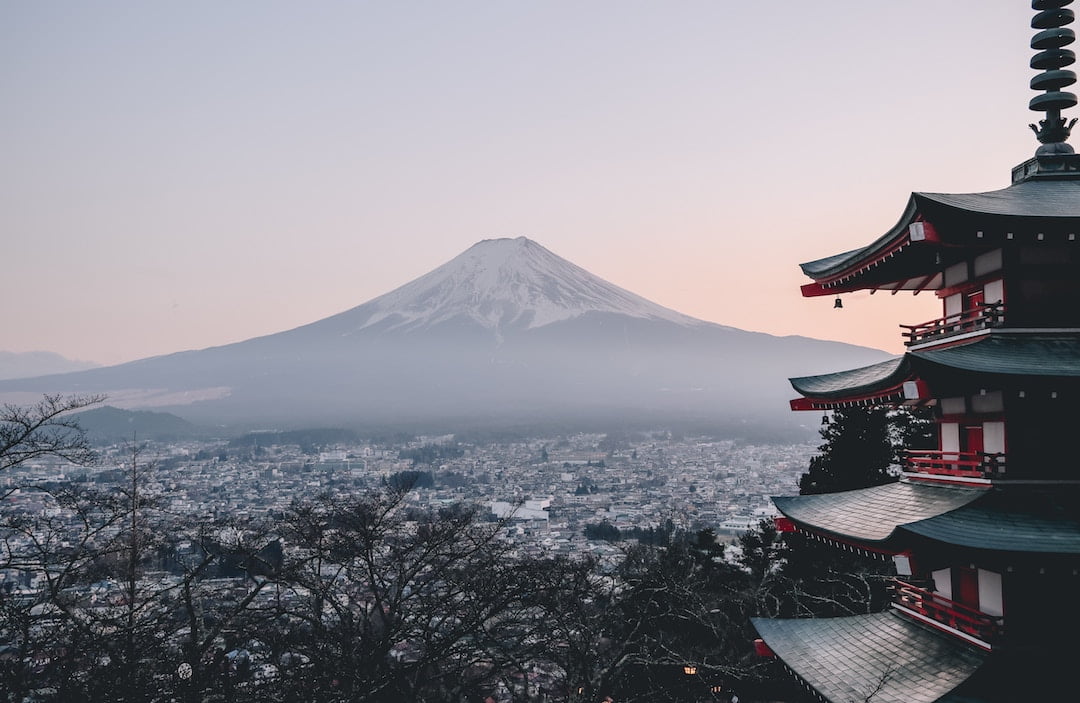
Japan Vs Korea: Where Should You Go On Tour Next?

It goes without saying that Japan and South Korea are two incredible destinations but deciding where you should visit on your next tour, however, is never an easy decision to make.
To save you losing sleep over choosing where to visit next, here are a few tips to help you with the decision: Japan or South Korea?
What type of traveller is best suited to Japan?
Japan is home to some of the best experiences in the world that are bound to suit the needs of all travellers. Thrill seekers can perch themselves on top of the Tokyo Tower to enjoy the sweeping views of the city from hundreds of meters in the air, or if you prefer to keep two feet on the ground, there are plenty of traditional Japanese spa experiences to be enjoyed. For the food lovers out there, of course, there are millions of new flavours and delicious cuisines that can be found across the country.
So basically, what we’re really trying to say is that anyone can visit Japan!
See Also: Where to Take the Best Photos of Japan: As Told by a Pro
Should you book a tour to Japan?
For travellers wanting an in-depth cultural experience, a multi-day tour to Japan is one of the best ways to go to experience the country. Not only will you get to learn all about Japan from your local guide, you can surround yourself with other like-minded travellers on your tour.
If you are determined to see Japan on your own, there’s always an option to join a self-guided tour so you can move at your own pace while exploring away from the beaten path.
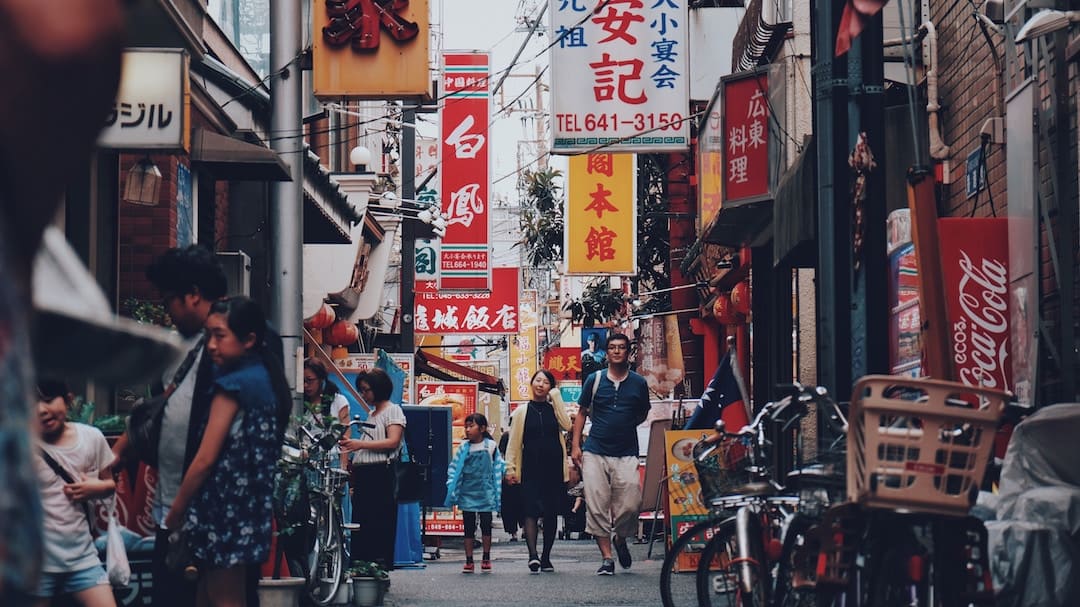
What is the best time to visit Japan?
Peak season for travel in Japan is dictated by the patterns of the colourful cherry blossom trees which causes a steep price hike during this time. The cherry blossom season is typically in full swing in early April, and between late-April to the start of May, the majority of the Japanese population take this week off work, and this is often referred to as ‘Golden Week’. If you are planning on travelling during this time, be wary that crowds at popular attractions will be much higher, and hotel rates will jump.
If you’re happy to settle for slightly cooler temperatures, late May to early June is a pleasant time to visit Japan as hotel accommodation prices will drop and crowds will lessen. Late-autumn through to early-spring is also an ideal time to visit Japan, although temperatures will be colder during this time.
- Spring – March, April and May
- Summer – June, July and August
- Autumn – September, October and November
- Winter – December, January and February
See Also: Hiking the Japanese Alps in Winter
What are the must-visit sites in Japan?
Mount fuji .
An undeniable icon of Japan is the beautiful and majestic Mount Fuji. Japan’s tallest peak can be seen up close with a drive up to the volcano’s 5th station, where travellers can enjoy the sweeping views of Japan’s countryside. Those seeking picturesque views of Fuji from afar can visit surrounding locations such as Lake Ashi.
Fushimi Inari Shrine

An endless stream of red torii gates, weaving and guiding travellers throughout a vibrant green mountain; the Fushimi Inari Shrine is a highlight that cannot be missed when visiting Kyoto. The shrine was founded in 711 AD and is comprised of over 10,000 torii gates. Although walking through the tunnels can be time-consuming, visitors are rewarded with panoramic views of Kyoto city.
Takeshita Street
Takeshita Street is a buzzing and colourful shopping lane of Tokyo, lined with unique stores, eateries and clothing boutiques. The spot is extremely popular due to its trendy stores which contain unique accessories that cannot be found elsewhere.
Sensoji Temple and Nakamise Shopping Arcade
Sensoji is Tokyo’s oldest temple, surrounded by charming and entertaining market strips. The temple was opened in 645 AD and still stands today as a much-loved tourist destination. Visitors can enter through the temples thunder gate and amble along the Nakamise Shopping Arcade through to the vibrant and grand structure.
Enoshima Bay
Enoshima is a small island, located approximately 1 hour south of Tokyo that can be accessed by car. Travellers can walk through the narrow shopping streets past traditional restaurants, through to the Enoshima Shrine. Trek through the shrine, respectfully participating in an array of Japanese customs before reaching the peak of the island for sweeping views of the surrounding area.
What are the must-try dishes in Japan?
- Sashimi: Thinly sliced raw meats, with the most popular being fish and seafood.
- Miso Soup: A soup made from fish stock, miso bean paste, green onion, and tofu. Commonly served alongside traditional Japanese meals.
- Tempura: Battered seafood and vegetables.
- Udon: Wheat flour noodles commonly served in soups.
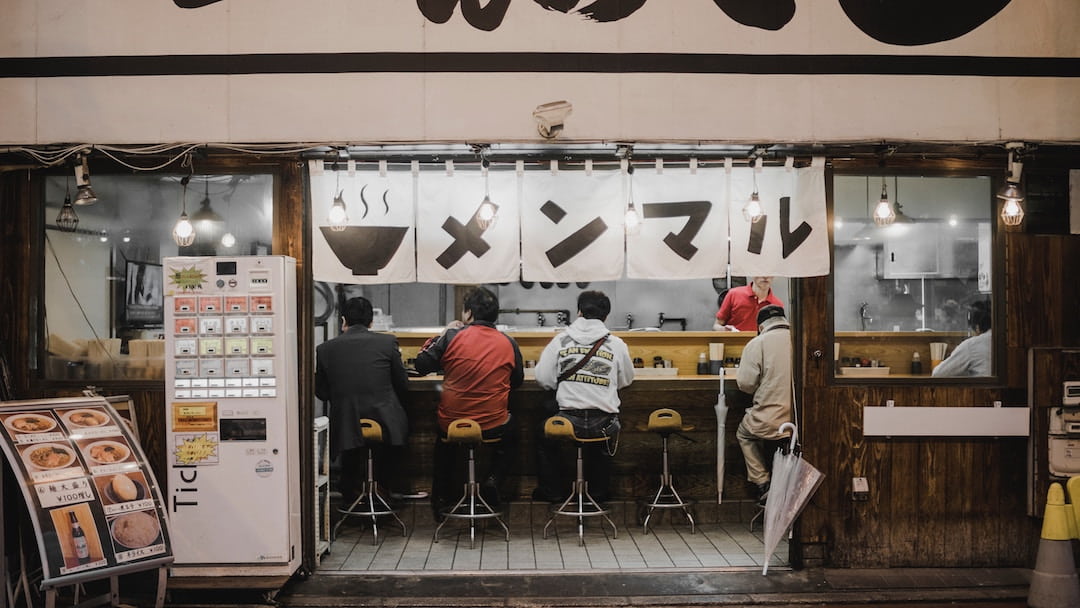
What are the best local experiences in Japan that I need to make time for?
Ride the shin kasen.
Japan’s extensive bullet train system is easily the most convenient and efficient method of getting between major cities. Reaching speeds of approximately 320 kilometers per hour, the trains are comfortable, spacious and popular among locals and travellers.
Wander among a bamboo forest
The opportunity to walk through a bamboo forest is an experience that simply cannot be overlooked in Japan. Walk beneath the towering tips of the bamboo, surrounded by greenery and fresh air.
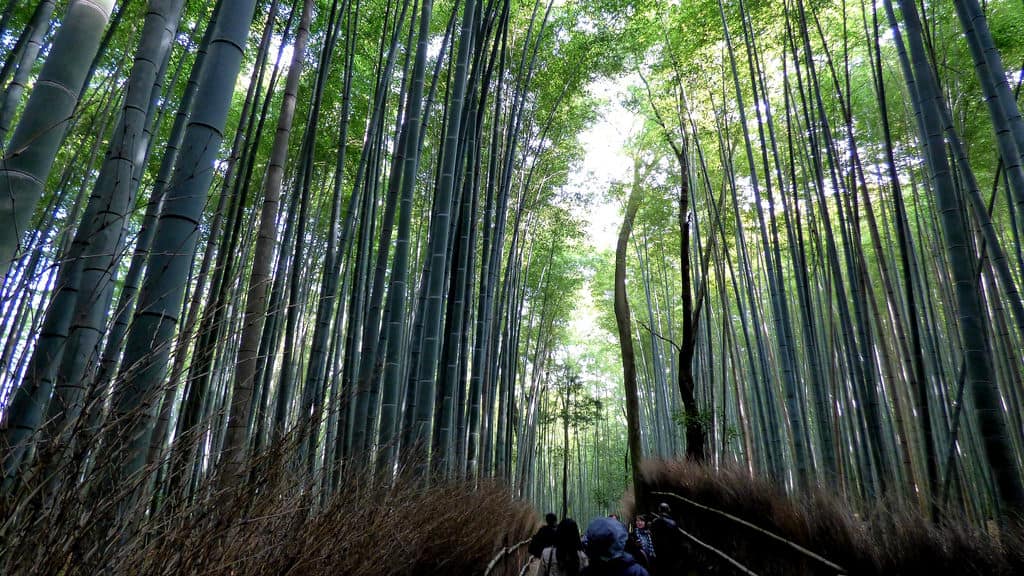
Feed the deer at Nara Park
One of Japan’s oldest parks, Nara Park is home to hundreds of roaming deer. Travellers come from all parts of the world to visit these creatures, with some even bow before receiving a treat.
Eat sushi in Tokyo
High upon many Japanese bucket lists is the opportunity to eat sushi while visiting, and Tokyo provides countless places to do just that. The city holds plenty of traditional sushi restaurants with a range of flavours to sample.
What do you need to know before visit Japan?
Jr rail pass.
The JR Rail pass allows travellers visiting Japan to ride the country’s bullet train system, for one fixed price, over a specific duration of time (7 or 14 days). This extremely cost-effective option is ideal for those wishing to venture between major cities. However, it should be noted that the pass must be purchased from home countries and can only be activated in Japan.
Learn a few phrases
While it is often easy to get your point across without the need for English, it may be worth learning a few phrases in case you find yourself in a situation where verbal communication is needed. Otherwise, online translators may be worthwhile. Here are a few Japanese phrases to help you with your journey.
See Also: Best Travel Podcasts If You’re Travelling to Japan
South Korea
What type of traveller is best suited to south korea.
Most travellers might be under the assumption that South Korea is a conservative place, however, in reality, this is not so much the case. South Korea is built for the curious traveller; someone who isn’t afraid to navigate the busy streets or to get lost and learn from locals who no doubt have a story to share. From the vibrant city of Seoul to the Seoraksan mountain in Gangwon and more, South Korea is filled with enough experiences to keep you entertained for a lifetime. Travellers with an open mind and an thirst for new experiences would be best suited for a trip to this exciting destination.
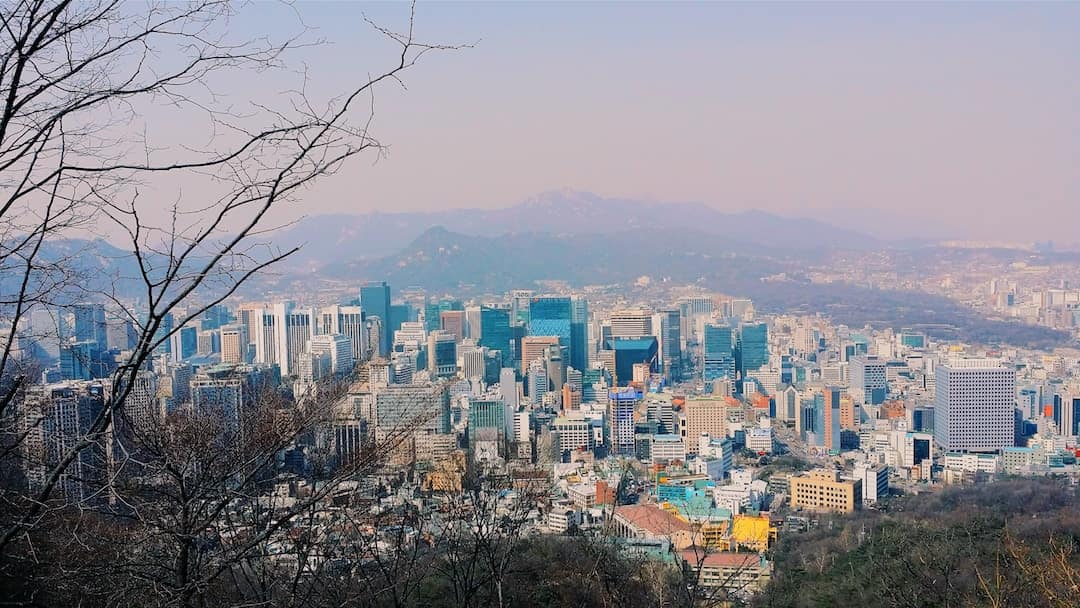
Should you book a tour to South Korea?
A multi-day tour of South Korea may be a good idea for those visiting for the first time. Aside from the obvious benefits of travelling with a local tour guide and a group of travel buddies, a tour can highlight the best secret places to visit that you might not find on your own.
What is the best time to visit South Korea?
The peak season for travel in South Korea is during the summer months of the year. During this time, crowds, hotel accommodation, and temperatures are at an all-time high.
The best time to visit South Korea is in spring and fall. Crowds are much lower than the peak season and weather is overall quite pleasant. Hotel rates are also much more reasonable.
- Spring: March, April and May
- Summer: June, July and August
- Autumn: September, October and November
- Winter: December, January and February
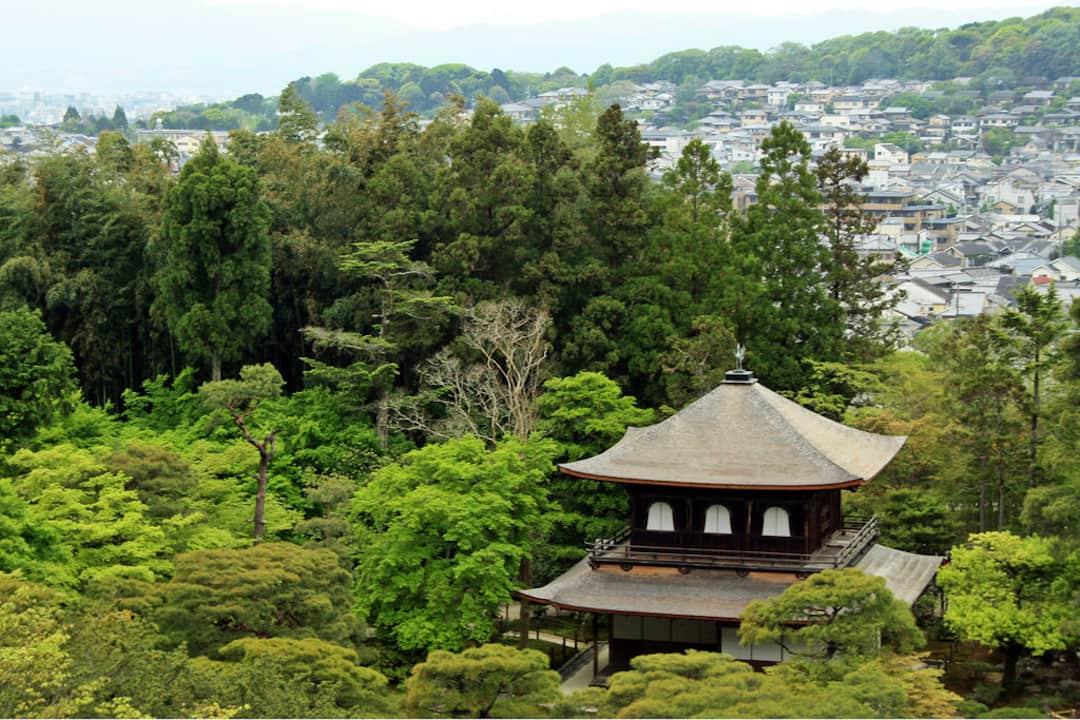
What are the must-visit sites in South Korea?
Myeong-dong.
The vibrant area contains big brands, department stores and charming eateries to enjoy. The streets are bustling with many tourists seeking delicious food and an energetic nightlife.
N Seoul Tower
Opening in 1980 and standing at an impressive 236m, N Seoul Tower is the perfect spot for those wanting to gain a unique perspective of the city. Some of the tower’s best features include a panoramic viewing platform, multiple restaurants, and a digital observatory.
Changdeokgung
Also located in the city of Seoul is Changdeokgung, a grand palace from the Joseon Dynasty. Within the grounds of the palace is a flourished, palace park, a rear garden and a residence for royal family members.
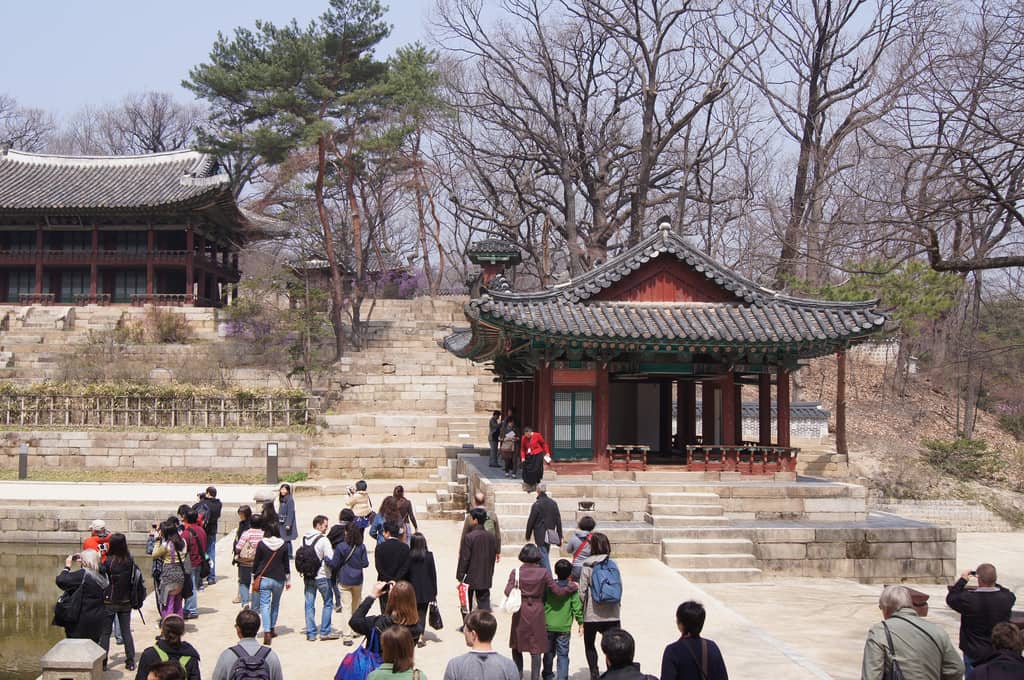
South Korea’s biggest theme park, Everland, is beloved by countless locals and tourists every year. The park houses thrilling rides, festivals throughout the year and a zoo. The park also features a wooden roller coaster, which is popular among guests.
See Also: Dress Codes in Asia: From Myanmar to Thailand and Beyond
What are the must-try dishes in South Korea?
- Korean spicy rice cakes (Ddeokbokki): Made of rice cakes, a fish cake, and sweet chilli sauce. The dish is popular in street markets.
- Pan fried chicken (Dakgalbi): A stir-fried, spicy, diced chicken dish served with sliced cabbage.
- Red bean shaved ice (Patbingsu): A popular dessert. The shaved ice is topped with sweet flavours, such as fruit syrup, and red bean paste.
- Stir-fried octopus (Nakji Bokkeum): Served with udon noodles and a spicy sauce.
What are the best local experiences in South Korea to make time for?
Try korean bbq.
For those looking to indulge in some traditional foods while visiting South Korea, Seoul is home to some of the best Korean BBQ restaurants. For those unsure about what Korean BBQ is, a grill is built into the table and guests purchase raw meats, commonly beef, pork and chicken to cook.
Noraebang (Karaoke)
A way of life for people of all ages in South Korea, Karaoke is a fun way for travellers to sing their hearts out in a unique, welcoming setting. It is very easy to come across a Noraebang when visiting, as they are scattered thoroughly around major cities.
Visit a temple
An excellent way to experience the remarkable history of South Korea first hand, the country is home to countless Buddhist temples to wander among and enjoy. Some of the must-see colourful temples include the Bongeunsa Temple and Haedong Yonggung Temple.
What do you need to know before visit South Korea?
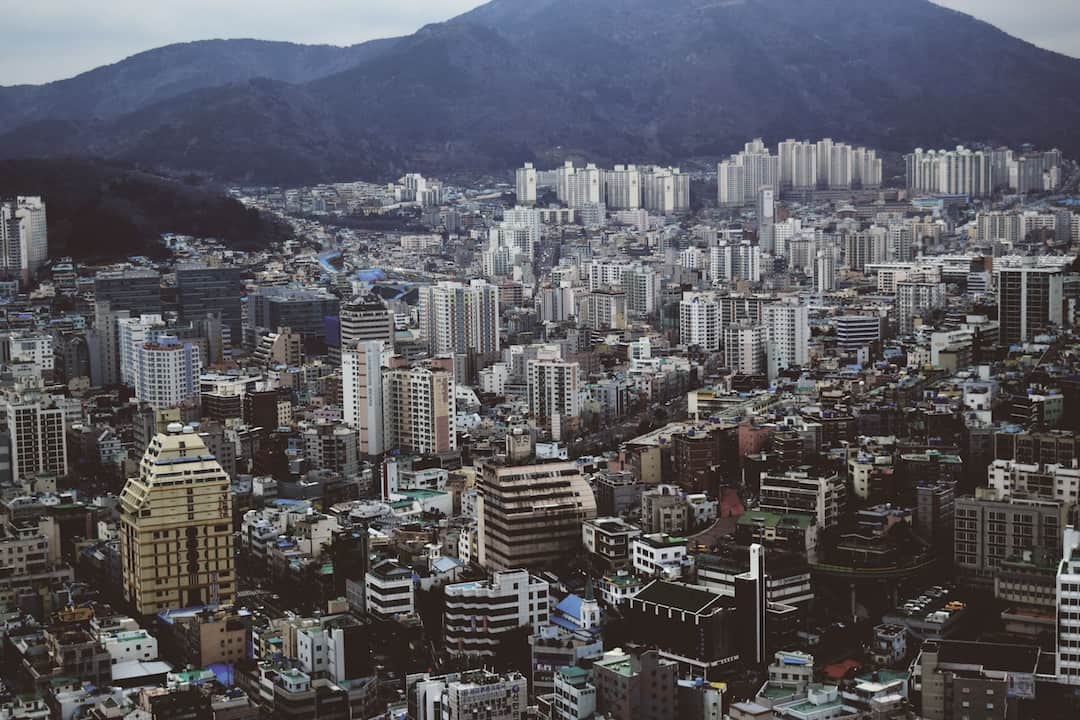
Transportation
Getting around the major cities of South Korea is very simple due to the country’s extensive and cost-effective public transport system. Purchasing a T-money card is a wise investment, as it can be topped up and used on public buses and subways. It also allows travellers to avoid purchasing a single ticket whenever the subway is used
See Also: 12 Safest Countries in Asia for 2018

Nicholas Hastie
Nicholas Hastie is a writer located in Brisbane, Australia. He enjoys documenting his journeys through travel and photography, hoping to inspire others to create unforgettable memories. He has travelled to 9 countries himself, Japan being his favourite. Follow his adventures on Instagram via @NicholasHastie and @WonderfulRoaming
Related Articles
- Food & Drink
Your Guide to Amsterdam’s Secret Bars and Speakeasies
One of the most popular cities in Europe, Amsterdam has no...
- Tips & Tricks
Best Destinations for People with Disabilities
The world and its wonders should be available to one and...
The Seven Most Scenic Train Rides in Europe
Forget planes, buses or automobiles: 2024 is the year of the...
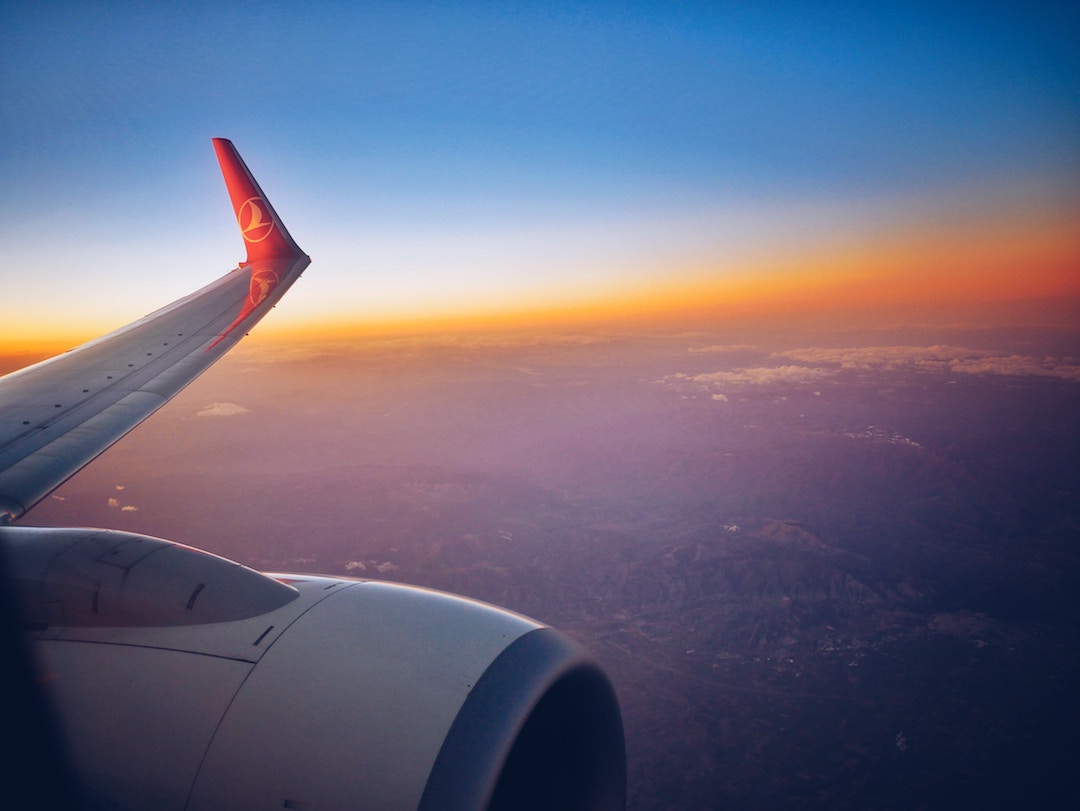
The 20 Most Pet-Friendly International Airlines Ranked
Get unlimited access to the world's best travel stories. subscribe now., privacy overview.
Korea or Japan – Which is Better to Travel

With the rise of the Hallyu wave and the sustained popularity of Japanese culture globally, it’s no wonder that you’re torn between choosing South Korea or Japan for your next travel destination.
Both countries offer unique experiences, brimming with rich history, diverse cuisines, stunning landscapes, and vibrant modern culture.
This article aims to provide a balanced overview of traveling to both these East Asian giants, assisting you in deciding which destination aligns best with your travel desires.
Apply Online
In this article…
A Tale of Two Capitals: Seoul vs. Tokyo
Seoul: a fusion of past and future.
Seoul, the capital of South Korea, is a metropolis where sleek skyscrapers coexist with centuries-old palaces and temples. The city’s districts are diverse in their offerings.
Gangnam, known globally thanks to Psy’s viral song, is a place of luxury boutiques and high-tech businesses. In contrast, Insadong boasts traditional tea houses, antique shops, and art galleries.
Seoul’s palaces, such as Gyeongbokgung and Changdeokgung, provide a glimpse into the country’s royal past. For a futuristic perspective, head to the Digital Media City or Lotte World Tower, the country’s tallest building.
Tokyo: Where Tradition Meets Innovation
Tokyo, Japan’s bustling capital, is equally captivating. It’s a city where you can experience Japan’s traditions and its futuristic vision side-by-side.
Historic temples and serene gardens lie minutes away from towering skyscrapers and neon-lit entertainment districts.
Visit Asakusa to experience old Tokyo, with its famous Senso-ji temple and Nakamise shopping street.
Contrast that with a visit to Shibuya or Shinjuku, bustling with life and bright lights after dark. Don’t forget to enjoy the view from the Tokyo Skytree, the tallest structure in Japan.
💡 Tip: Buy travel health insurance before your trip.
Check out popular travel insurance plans and choose one that suits you.
Most plans only cost less than $20 a day.
Cuisines: K-BBQ vs. Sushi
Savory delights of korea.
Korean cuisine is a paradise for food lovers, with dishes that are diverse, flavorful, and healthy.
Barbecue, or gogi-gui, is a must-try, with places serving everything from marinated beef (bulgogi) to pork belly (samgyeopsal).
Equally popular is bibimbap, a bowl of warm rice topped with sautéed and seasoned vegetables, chili pepper paste, soy sauce, and a raw or fried egg.
Don’t forget to try kimchi, the spicy fermented cabbage that’s a staple of every Korean meal. For the adventurous, there’s even a live octopus dish called sannakji!
Savoring Japan’s Culinary Artistry
Japanese cuisine, known as washoku, is praised for its balance, aesthetic, and depth of umami flavors. The most internationally recognized dish, sushi, is an art in itself.
Quality sushi restaurants, like Sukiyabashi Jiro in Tokyo, serve sushi that melts in your mouth.
Japan’s culinary delights go beyond sushi, though.
Ramen shops dot city streets, serving steaming bowls of noodles in various broths. Don’t miss out on tempura, tonkatsu (breaded pork cutlet), and street food like takoyaki (octopus balls) and okonomiyaki (savory pancakes).
Nature & Scenery: Hanami vs. Jeju
Discovering korea’s natural wonders.
South Korea is home to stunning natural landscapes.
Its star attraction is Jeju Island, often referred to as the “Hawaii of Korea.” Jeju is known for its volcanic landscape, complete with the stunning Hallasan mountain, lava tubes, and beautiful beaches.
Mainland Korea is equally captivating, from the cherry blossom-lined streets of Jinhae during spring to the vibrant autumn colors in Seoraksan National Park.
For a more tranquil experience, visit the picturesque Suncheon Bay Wetland Reserve.
Japan’s Seasonal Splendors
Japan’s natural beauty is world-renowned, offering an enchanting spectacle each season.
In spring, the country is awash with the soft pink of cherry blossoms (sakura) for hanami (flower viewing) season. Autumn turns the landscapes into vibrant hues of red, orange, and yellow, providing breathtaking sights in places like Nikko and Kyoto.
But it’s not just about the seasons.
The iconic Mt. Fuji, the tranquil bamboo groves of Arashiyama, and the scenic coasts of Hokkaido showcase Japan’s varied landscapes.
The southern island of Okinawa offers tropical beaches and great diving spots, providing a contrasting experience to mainland Japan.
Culture & History: K-Pop vs. Geisha
Korea’s vibrant culture and rich history.
South Korea may be known for K-pop and dramas, but its cultural canvas is far richer. Traditional arts like calligraphy, silk weaving, and pottery are still alive.
History buffs will love visiting the ancient Silla capital, Gyeongju, often referred to as “the museum without walls.”
At the same time, modern culture is equally enticing. Seoul’s Hongdae district is known for its underground music scene, art markets, and street performances.
Visit during the annual Busan International Film Festival, and you may catch a glimpse of Hallyu stars!
Japan’s Timeless Traditions and Innovative Spirit
Japan skillfully balances respect for traditions with a constant drive for innovation.
Traditional arts such as tea ceremony, ikebana (flower arranging), and kabuki theatre coexist with modern manga, anime, and robotics.
The historical districts of Kyoto are the best places to catch a glimpse of geisha culture.
Meanwhile, Akihabara in Tokyo represents the epitome of Japan’s pop culture and tech advancements. Attending a sumo match or visiting during a matsuri (festival) allows you to experience traditional Japanese culture firsthand.
Final Thoughts: Korea or Japan?
The decision between South Korea and Japan ultimately depends on your personal preferences. Both countries offer unique and enchanting experiences, making them worthy additions to any traveler’s bucket list. Here’s a quick summary:
- For modern culture and lively nightlife, both Seoul and Tokyo shine.
- For historical attractions, both countries offer remarkable insights into their rich pasts, with Kyoto being a standout in Japan, and Gyeongju in Korea.
- For natural beauty, both countries have their distinct offerings, from Jeju Island in Korea to Mt. Fuji in Japan.
- For foodies, it’s a tough call between Korean BBQ and Japanese sushi. Why not try both?
Remember, there’s no rule stating you can only visit one of these fascinating countries. Who knows? You might just find yourself planning to visit the other soon after your first trip! Safe travels!
- What Documents Do I Need To Travel to Japan
- Should I Exchange Money Before I Travel to Japan
- Do I Need Travel Insurance for Japan
- Best Travel Insurance for Japan: Complete Guide
- Japan Travel Restrictions – Everything to Know
Apply Online easily.
Leave a reply cancel reply.
Your email address will not be published. Required fields are marked *
Save my name, email, and website in this browser for the next time I comment.

- 2 Weeks for Couple
- 2 Weeks for Family
- Thailand Lantern Festival
- Indonesia(Bali)
- South Korea
- China (HK, Taiwan)
- Itinerary Ideas
- Asia Highlights Travel Reviews
- Thailand Travel Reviews
- Vietnam Travel Reviews
- Cambodia Travel Reviews
- Japan Travel Reviews
- Myanmar Travel Reviews
- China Travel Reviews

How to Plan a 12-Day Trip in Japan and South Korea
With anime and K-pop becoming more and more popular, visiting Japan and South Korea has become a dream trip for many children. If you're considering a trip to celebrate your child's birthday or graduation, Japan and South Korea would definitely exceed your family's expectations.
These two destinations also attract many insightful travelers to gain insights into East Asia's history as well as indulge in culinary delights.
To enjoy the main highlights, 12 days is ideal, with 7–8 days in Japan and 4–5 days in South Korea.
- 1. Which Country to Visit First
- 2. A 12-Day South Korea and Japan Itinerary
- 3. Best Times to Visit Japan and South Korea
- 4. How Much Does a 12-Day Trip Cost
- 5. Do I Need a Visa to Visit Japan and South Korea
Which Country to Visit First, Japan or South Korea?
Although both Japan and South Korea are conveniently connected by flights from the US or European countries, to get more of a wow factor throughout the trip, you're highly recommended to start your journey in South Korea and then travel to Japan . Japan provides more hidden gems for you to unveil.
When choosing your international flights, if you're in the US, it usually costs less for a round trip from the west of the US, such as Los Angeles to Tokyo. From Tokyo to Seoul, it takes about 2½ hours and usually costs about 200 USD per ticket.
Discover real reviews of Highlights Travel Family 's best-rated service across trusted platforms.
A 12-Day Classic South Korea and Japan Itinerary: Explore the Highlights of Both Countries
This itinerary covers the major highlights of South Korea and Japan, creating a fulfilling experience full of lifetime memories.
In South Korea, you would have the chance to explore the renowned DMZ tunnels, immerse yourself in the vibrant K-pop culture, and savor delicious Korean cuisine. In Japan, you could experience kid-favored animation elements, have fun at Super Nintendo World, unwind in onsens (hot-spring baths), admire the iconic Mount Fuji, and feed friendly deer in Nara.
Here is the handpicked itinerary, for inspiration:
- Days 1–3: Seoul in South Korea
- Day 4: Gyeongju
- Days 5–7: Fly to Osaka in Japan and then take the Shinkansen to Kyoto
- Days 8–9: Hakone
- Days 10–12: Tokyo
Start your wonderful trip in the energetic capital city of Seoul, South Korea. Stroll around the history-filled Gyeongbokgung Palace while wearing a hanbok to take memorable photos, explore the DMZ and its tunnels to learn about wartime stories and cherish the hard-won peace, attend an exclusive K-pop dancing class with a professional choreographer to groove with your teenage kids, and sample delicious Korean food, such as bibimbap and Korean fried chicken.
Head to Gyeongju, the ancient capital of South Korea. You could visit Bulguksa Temple, which has thousands of years of history, and stay for a night in a Hanok hotel to experience authentic Korean accommodation.
Continue your trip in the impressive medieval capital of Kyoto in Japan.
- For families with teenagers, you could dress up like a ninja to learn about the techniques and weapons from a ninja master. Many fathers and sons among our family clients have enjoyed this activity. Feeding the friendly deer in Nara could also be a great family moment.
- For couples, you could stroll through Fushimi Inari Shrine while wearing a kimono to admire the orange-red torii and gain an understanding of the history of the Japanese shrine. Have afternoon tea with a geisha and get an insight into the geisha culture with a story-telling explanation from an expert.
Take the Shinkansen to Hakone, which is home to onsens. Stay at a ryokan with an onsen to experience traditional Japanese accommodation. We would help you to select handpicked family-friendly or couple-friendly ryokans out of thousands. Generally, a traditional ryokan has 5–10 rooms, so it could easily be booked up. We suggest that you make a reservation at least 3 months in advance.
Complete your trip in Tokyo, the top city of Japan, which perfectly blends history and modernity. Wander through the Asakusa district to experience the Edo vibe and make sushi with the help of an experienced chef. For anime lovers, you could buy your favorite anime products in Akihabara and have a happy family time at Pokémon Center, the Ghibli Museum, or J-World Tokyo.
Taking a day trip to view the iconic Mount Fuji from Tokyo is another highlight.
Let us help you plan your trip! Contact us and we will create a trip based on your group size, time, budget, interests, and other requirements.
Best Times to Visit Japan and South Korea
Japan and South Korea enjoy similar weather in their four distinct seasons because of their close proximity.
The best times to visit South Korea and Japan are spring (March to May) and autumn (September to November) due to the pleasant weather and more clear days. These periods offer the most captivating views in both countries, with cherry blossoms blooming in spring and vibrant autumn foliage in fall. May has fewer crowds and decreased travel costs because the cherry blossom season will have ended in all but northernmost Japan.
Summer (June to August) is hot in both countries, with the average daily high reaching 34°C (93°F). It's the rainy season as well but it doesn't rain every day and you could still enjoy your planned trip.
Winter (December to February) is cold and dry in South Korea and Japan, with an average daily high of 10°C (50°F), making it a good time to enjoy onsens and see snow monkeys bathing in hot springs. Christmas and New Year are extremely busy in both countries and hotels are easily booked up. Therefore, we suggest that you plan ahead at least 3–6 months in advance for a festive-season stay.
Insider tips: For family groups who usually travel in the summer or winter vacation, June and January are recommended. June is cooler and less crowded than July and August (the local summer vacation months). January has a similar climate and sightseeing experience to December but you can usually get a better deal for international flights.
To make the best of travel opportunities at any time of the year, let us know your interests and requirements , and we'll take care of everything.
How Much Does a 12-Day Trip to Japan and South Korea Cost?
A 12-day trip to Japan and South Korea costs about US$7,000–8,000 per person based on a group of 3–5 people.
- Private touring in Japan costs about US$350–500 per day per person, and the cost in South Korea is about US$400–500 per day per person, including 4-star hotels, a full-day itinerary, tickets for attractions, private cars, and private guides.
- Direct flights from Seoul to Osaka are about US$100–150.
Our travel expert will customize your trip based on your requirements, and make the most of your money.
Do I Need a Visa to Visit Japan and South Korea?
Nationals of many countries are exempt from needing a visa to enter Japan and South Korea, including the United States, Canada, the United Kingdom, and Australia. Most travelers could stay in Japan without a visa for 90 days.
Why Asia Highlights (10,000+ reviews & 98.8% 5-star rating)
- Save Your Time:
- Less research, more enjoyment!
- Real-time 1V1 expert planning
- Maximize Your Flexibility:
- Personal local guide and ride
- Explore at your own pace
- Celebrate Your Journeys:
- Specially-crafted family adventures
- Celebrate milestones with style!
Get Inspired with Some Popular Itineraries
At Asia Highlights, we create your kind of journey — your dates, your destinations, at your pace. You can have any trip tailor made for your travel.
More Travel Ideas and Inspiration
Sign up to our newsletter.
Be the first to receive exciting updates, exclusive promotions, and valuable travel tips from our team of experts.
Why Asia Highlights
Where can we take you today.
- Middle East
- African Safari
- Travel Agents
- Loyalty Program
- Our Differences
- Privacy Policy
Address: Building 6, Chuangyi Business Park, 70 Qilidian Road, Guilin, Guangxi, 541004, China

Japan or South Korea? How to choose your next holiday destination
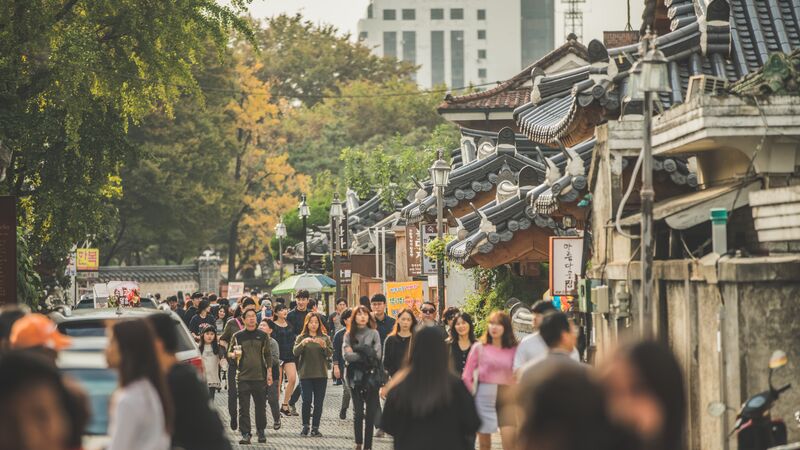
It turns out comparing countries isn’t all that easy to do…at least, not without a little help.
You might be under the impression that deciding which destination to travel to is the easy part, but the decision becomes a lot trickier when you’re choosing between two breathtaking Asian countries – Japan and South Korea.
Japan has the tradition and the food, but South Korea has the city of Seoul and K-pop so how are you supposed to pick one?
To help you out with this almost impossible dilemma, we’ve put together a comprehensive guide comparing the two countries when it comes to culture, landscapes, weather, cuisine, and cities so you can jet off knowing you made the right choice.
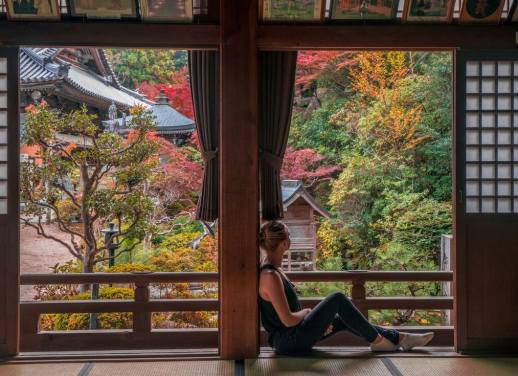
Japan might be the land of futuristic technology and vending machines that sell everything under the sun (no literally, you can buy fresh lobsters and lucky charms) but its ancient culture dates back thousands of years with traditions influenced by Confucianism (introduced in AD285) and Buddhism (introduced in AD522).
Although there are several elements of old-school Japanese culture practiced throughout major cities and rural areas such as tea ceremonies, sumo activities, bowing, geishas, and kendo, it’s actually Japan’s newer generations that are setting the cultural tone these days in a fast-paced world full of avant-garde fashion and virtual realities.
However, there’s still a focus on core traditional values such as modesty, respect, and discipline but this is more present in the older generation with the country’s young people preferring a life of flamboyancy and ostentation.
DISCOVER JAPAN ON OUR JAPAN: LAND OF THE RISING SUN TOUR
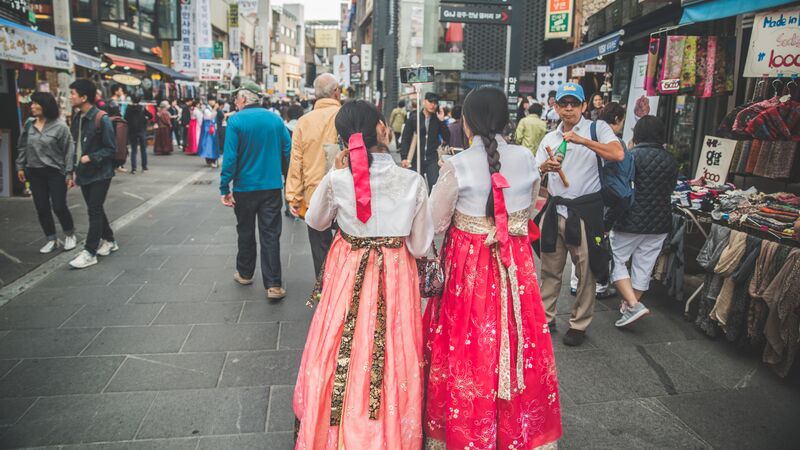
Thinking about South Korea’s culture can be overwhelming considering it dates back to 2,333BC but it prides itself on several core values that are still practiced today: respect, fairness, harmony, and adaptability (among others).
It’s these Confucius beliefs that underpin South Korea’s society with the majority of nationals participating in daily ancestral offerings, adhering to tiered interactions (strict hierarchal roles), and respecting community elders.
However, like with many other cultures, the younger generations are forging a new, less traditional path with less emphasis on humility and more importance placed on individuality and equality among all.
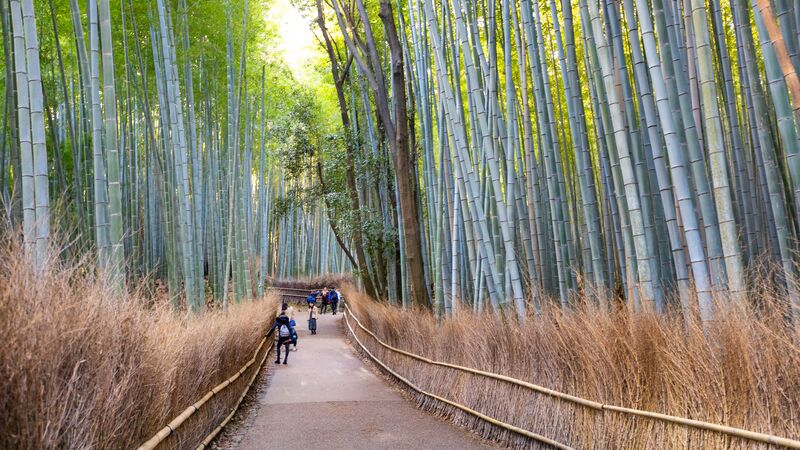
When you think of Japanese landscapes you might automatically think of Mount Fuji and while that’s definitely a landmark you have to set your sights on when you go to Japan, there’s so much more natural beauty to marvel at.
Boasting more than 6000 islands including Hokkaido, Kyushu, and Honshu, Japan’s geography consists of mountainous terrain, forested areas, natural hot springs, active volcanoes, and tranquil coastlines, as well as built-up cities, to explore.
Whether you feel like wandering through Aokigahara, a wildlife-infested forest on the outskirts of Mount Fuji, taking in the beauty of bamboo groves, or trekking up one of the many hiking trails on Mount Takao, this country’s wonders are both diverse and unique.
RELATED: NOW IS THE PERFECT TIME TO VISIT JAPAN
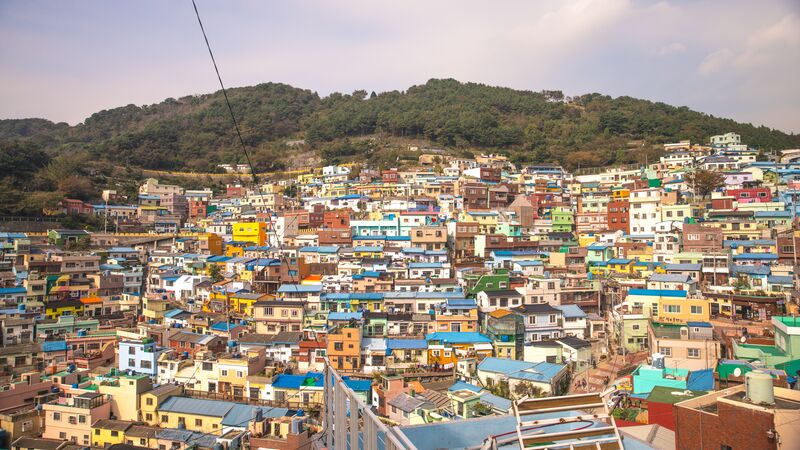
You’d be forgiven for not exactly knowing if there are any South Korean landscapes worth travelling thousands of kilometres for, but we can assure you the country is full of natural wonders from mystical forested mountain ranges to rocky and dramatic coastlines.
While Japan has Mount Fuji, South Korea has the smaller but no less impressive Halla-san – an extinct volcano that rises 6,398 feet high (compared to Mount Fuji’s 12,389 feet) and is located on Jeju Island. But that’s not all.
From UNESCO World Heritage-listed national parks like Seoraksan National Park with its unique rock formations and refreshing hot springs to Suncheon Bay with its extensive wildlife and breathtaking coastal areas, Mother Nature really did her best in South Korea.
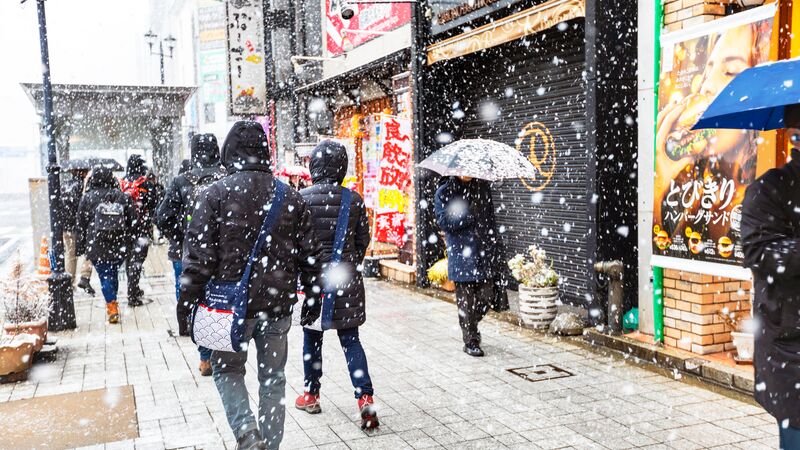
Japan’s weather tends to surprise a lot of people with different conditions and patterns experienced in different parts of the country from sticky, humid summers to cold, snowy winters but regardless of the season, Japan offers plenty to see and do.
If heavy snow (and the snow-based activities that come with it) tickles your fancy then head to the northern region of Yamagata from December to February, but if a light dusting is all you’re after, it might be worth visiting Hiroshima in the country’s south.
If you’re travelling during the summer and you’d rather keep humidity levels to a minimum, Tokyo’s the city for you with expected average temperatures around the 27°C mark (hot but not sticky). Osaka also experiences warm weather during the summer months and a mild winter making it one of the better year-round cities to visit.
JOIN OUR JAPAN EXPRESS SMALL GROUP ADVENTURE
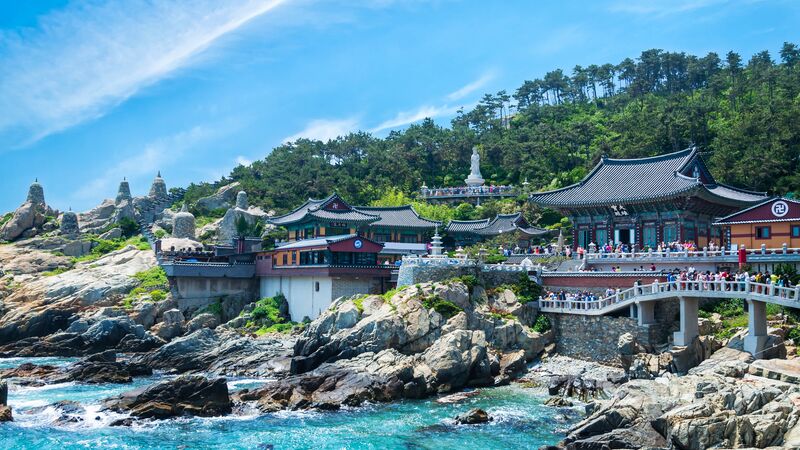
South Korea’s weather is much like that of its Asian neighbours – the summertime is considered the hot and rainy season and winter temperatures tend to drop below freezing in most parts of the country. For this reason, spring and autumn are generally considered the best seasons to visit.
During the months of March, April, and May, as well as September, October, and November, you can expect mild but comfortable temperatures without the rain and humidity experienced during the peak summer season. However, these optimal seasons never seem to last long so you really have to make the most of this country’s good weather while you have the chance.
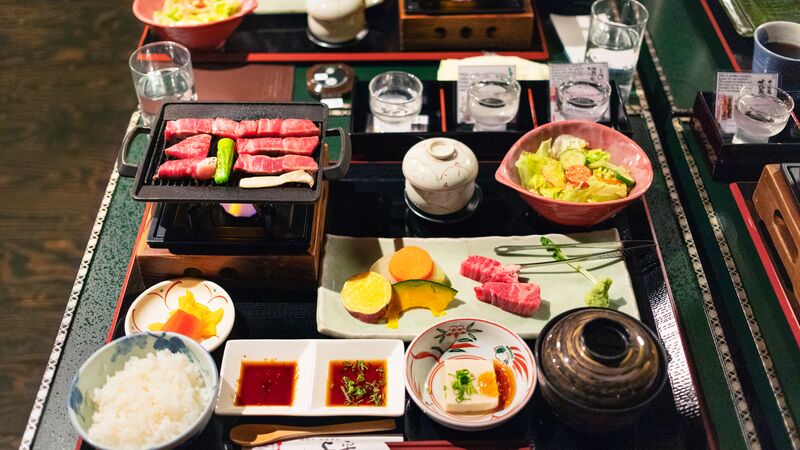
Your feet don’t have to do all of the exploring when you get to Japan. Embark on a culinary adventure and let your tastebuds take over with delicacies such as sushi, ramen, and okonomiyaki on the menu in most restaurants and eateries around the country.
Want to try something on-the-go? Pick up your next snack from one of the many vending machines you’re bound to see with seafood, ice cream, and hot meals all options for when you’re busy but peckish.
But a meal isn’t complete without a refreshing beverage to wash it down with; luckily, Japan has plenty of those. From traditional sake to antioxidant-packed green tea, trying out Japan’s cuisine is an experience you don’t want to miss.
RELATED: WHAT IS JAPAN FAMOUS FOR?
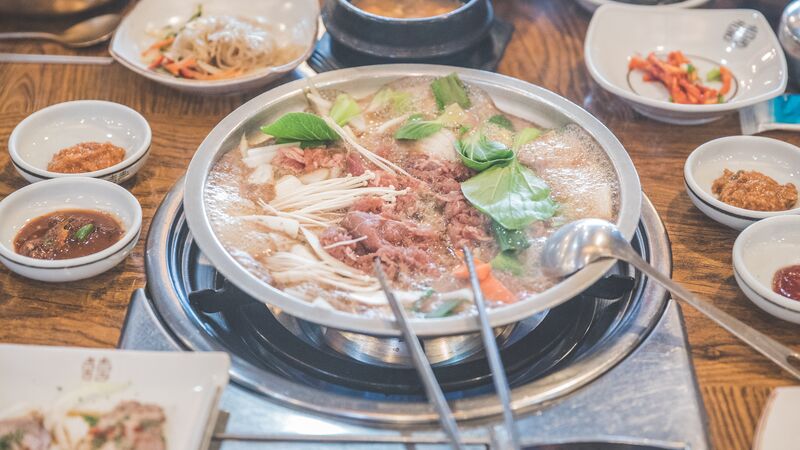
It’s hard to separate Japan and South Korea when it comes to their respective cuisines, like how can you pit sushi and kimchi against each other?! Answer: you can’t. But where Japanese food is centred on variety and balance, South Korean food is generally hot and spicy with ingredients such as fermented chilli paste and powdered red chilli the star of many traditional dishes.
However, long before Korean corn dogs stole the hearts of foodies around the world, traditional dishes such as bibimbap (a concoction of meat, vegetables, egg, and rice), jeon (a savoury pancake), and mandu (boiled, steamed, or pan-fried dumplings) were what travellers immediately sought out.
Other notable meals to try in South Korea are kan poong gi (spicy fried chicken), yook hwei (South Korea’s version of steak tartare), and gimbap (seaweed rice rolls). Oh, and you can’t forget to have Korean BBQ.
JOURNEY THROUGH SOUTH KOREA ON OUR SOUTH KOREA REAL FOOD ADVENTURE
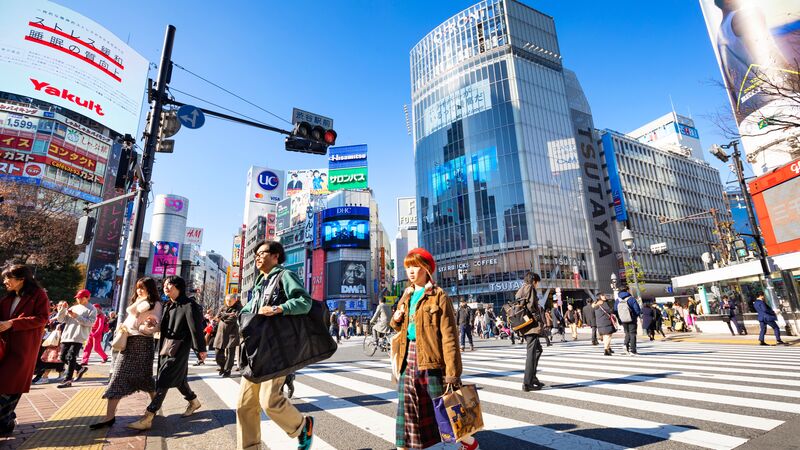
While Japan’s natural beauty can’t be denied, it’s the country’s vibrant, history-laden cities that steal travellers’ hearts the world over – think Kyoto with its ancient shrines and temples, Tokyo with its entertainment and neon-lit streets, and Hiroshima with its cherry blossoms and war memorials.
But Japan’s alluring cities go further than the popular, tourist-riddled ones. Take Nagoya for example. It’s actually Japan’s third biggest city but is often overlooked in favour of its bustling neighbours when in actual fact, it has a lot to offer in terms of attractions, culture, and cuisine.
From its collection of castles and religious monuments to the Osu district (the go-to place for second-hand goodies and delicious street food), Nagoya may just surprise you in the best way.
EXPERIENCE THIS DIVERSE COUNTRY ON OUR PREMIUM JAPAN TOUR
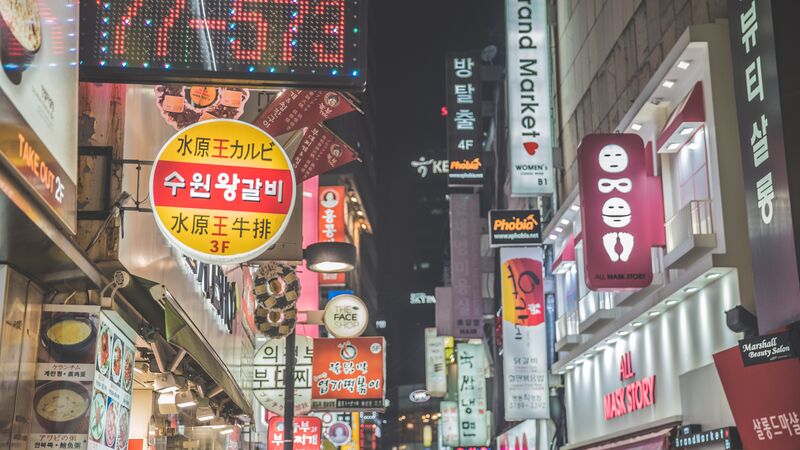
South Korea’s cities range from chaotic and concrete jungle-like to peaceful and history-filled with destinations such as Seoul and Gyeongju at the top of travellers’ lists – and with good reason.
Seoul is full of interesting things to see and do – Gwangjang market, Bongeunsa Temple, and Hanok Village are all must-visits – and even boasts plenty of breathtaking natural parks and gardens to wander around.
Gyeongju, on the other hand, is a slower-paced, ancient city that feels as if it belongs in a different time thanks to its UNESCO world heritage listed temples and historic monuments.
But these cities aren’t the only ones popular among tourists with several others such as Busan (a beachside retreat), Suwon (known for its impressive scenery), and Daegu (the economic hub of the country) all capturing hearts and taking up camera roll space.
The verdict
Japan and South Korea might be similarly located in Asia, but they couldn’t be more different, and to be honest, choosing between the two is pretty much impossible. Both countries offer incredible experiences thanks to their respective cultures, cuisines, and attractions – in fact, you can’t really go wrong with either of them. So, we’re calling this one a draw.
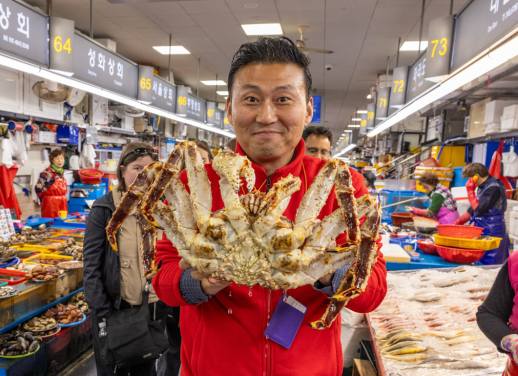
Kate Gazzard
When I was 11, my parents asked me whether I wanted a pool for the house or a trip to Fiji. I chose Fiji, and I've made travelling as much as I can a priority ever since.
You might also like
The 7 best places to go on a..., 5 reasons to visit sri lanka in the..., why 2024 is the best year to see..., yellowstone vs yosemite: which national park to visit, 6 unique experiences you can have in el..., from delhi to udaipur, here are the five..., cinque terre vs amalfi coast: which destination to..., california or florida which us state should you..., love at first bite: 10 famous sandwiches from..., galapagos or madagascar which unique destination should be..., central vs south america: how to plan your....

3 Weeks In South Korea and Japan Itinerary
DISCLAIMER: This post might have links to travel services and products that we enjoy. We might make a commission from it at no extra cost to you.
For various reasons, Japan and South Korea are on almost everyone’s bucket list. Aside from the beautiful scenery and a variety of healthy foods, people are also fascinated with their culture, anime, manga, K-dramas, K-pop, and of course, their history.
One of the most famous beef varieties, which is Kobe beef, can be found in Japan. You can also see the world’s shortest escalator here, only five steps, and the tallest mountain.
South Korea, on the other hand, has the fastest internet speed in the world. They have over 200 kimchi varieties, and their capital, Seoul, is where The Simpsons and South Park were processed. If it’s your first time in South Korea, these apps for Korea will help you get around and plan your upcoming trip.
You might be wondering why we’ve mentioned all of these facts. Well, it’s because this article will focus on 3 weeks in South Korea and Japan. That’s right, why travel to these countries on separate occasions when you could spend 3 weeks visiting both?
I compiled the most famous places to visit and things to do during your 3-week stay. How to spend 10 days in each country.
RECOMMENDED TRIPS: 3 weeks in the Philippines or 3 weeks in Cambodia and Vietnam
TIPS BEFORE GOING TO SOUTH KOREA AND JAPAN

We know you’re already excited and want to proceed with the itinerary. But first, there are some essential things that you need to know and be prepared first before you book anything.
When is the best time to go to South Korea and Japan
If you are fond of skiing and seeing the snow, the perfect time to go to these countries is during their winter season, which is from December to February in Japan and late December to mid-March in South Korea .
For those who want to witness the famous cherry blossoms personally, go during the spring season , which is from March to May, in both countries. Japan’s summer season is from June to mid-September and July to August in South Korea.
If you don’t want to go during the peak seasons, the best time to visit South Korea is from April to May and September to October because those are the months when the tourist numbers are low.
While in Japan’s off-peak season would be from late autumn through March . For those who are planning to avoid typhoon season, try not to book a flight to Japan from July to October and mid-June through September in South Korea.
Are 3 weeks enough for South Korea and Japan
If it’s your first time visiting these great countries, planning to spend 10 days on each will give you plenty of time to see all the top sites. Since both countries are small with reliable public transportation and short flights between them, you can really make the most of your time.
Remember to book your flight arriving in the first country you wish to visit first, then the flight home from the other country. This way, you don’t need to waste time flying back to the previous country.
Average cost of 20 days in South Korea and Japan
At $ 1,800, you can explore Japan and South Korea in 20 days. If you want to save a bit more, you can stay in a dorm room instead of a private one. On that low budget, you can expect to spend around $1,200 , especially if you also eat street food than dining at restaurants. If you want to splurge, $3,000 will allow you to stay in luxury hotels and try fancier restaurants.
These costs are per person, if you’re travelling with another person, you can bring the accommodation cost down if you don’t mind sharing a room.
Getting around
There are tons of ways to get around South Korea. There are trains, buses, cabs, cars, subways, and aeroplanes . If you’re planning to ride the bus, the most convenient way to do so is to buy a T-money transit card beforehand to avoid any hassle.
If the place you’re planning to visit is really far from where you currently are, then the fastest option would be to ride a plane, but it would be more expensive compared to the other modes of transportation.
Railways are the most common means to get around in Japan . They have two train types: the bullet train and the night train. Aside from that, they have taxis, buses, ferries, and offer car and bicycle rentals.
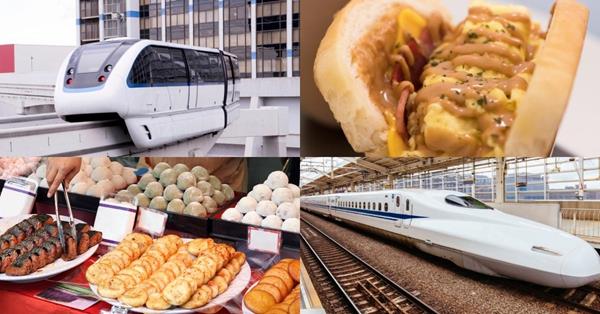
Visa/Covid policy
South Korea and Japan have quite different visa policies. Travellers with passports from North America (including Mexico), Argentina, Chile, Uruguay, Suriname, French Guinea, most of European, some of Southeast Asia, most of Oceania, and its neighbour South Korea, can enjoy visa-free travel to Japan for 15-180 days depending on the passport you have. Still, you must get the K-ETA which is only about $9.
For people who wish to visit South Korea, passport holders of most of America (excluding Bolivia and Cuba), almost all of Europe, some of Central Asia, some of North and South Africa, some of Southeast Asia and East Asia, and most of Oceania can enter the country as a tourist and stay for 30-180 days.
Unfortunately, as of the first quarter of 2022, Japan and South Korea have yet to open their borders to tourists. Bookmark this Japanese government site and South Korean government site to keep updated.
Basic travel tips
Here is a list of sites and travel services I use when travelling anywhere in the world. Many of these sites offer flexible cancellations and various choices depending on your budget and travel style. If planning to visit during peak season, make sure to book at least 6 months in advance especially for accommodations.
HOW TO TRAVEL BETWEEN JAPAN AND SOUTH KOREA
The most common and fastest way from Japan to South Korea (and vice versa) is to take a non-stop 2.5-hour flight . If you take on a connection, the travel time extends up to 6 hours.
There used to be a ferry service between these countries which was relatively uncommon. The travel time takes about 21 hours, and the ports are between Busan, South Korea to Hakata/Fukuoka, Japan.
You can choose from two companies: Kampu Ferries and Camellia Line Ferries. However, in 2019, Kampu Ferries limited their services to Japanese nationals. You can read more information here .
PACKAGE TOURS
If you prefer to sit back and relax, you can book a package tour where the tour operator will arrange everything for you, including transportation, hotels, food, tours, porters, and guides. Check out this 18-day trip for Japan and South Korea.
MUST-SEE PLACES IN SOUTH KOREA AND JAPAN (pinned map)
Click the icon on the top-right to enlarge the map. Credit: Map Data: Google
3 WEEKS IN SOUTH KOREA AND JAPAN
Due to the size of both countries and the distance from each other, you can easily cover Japan and South Korea in one go. You can spend about 10 days in each place or move things around if you want to spend more or less time in the other.
Although this doesn’t mean you can’t pay for the entire 3 weeks in a single country, you can very well, which will let you see many more places and travel slower.
Day-to-day overview:
- Day 1 : Arrive in Seoul, South Korea – get transferred from the airport or take the train/bus, get a local sim card if needed and train/bus passes
- Day 2 to 4 : Go sightseeing around Seoul and the surrounding areas
- Day 4: Get to Busan from Seoul by car or train or bus
- Day 4 to 6 : Explore Busan
- Day 7 : Travel from Busan to Jeju Island by plane
- Day 7 to 9 : Explore Jeju Island with East bus tour
- Day 10 : Fly to Tokyo from Jeju Island, get pocket wifi for Japan or local sim card with unlimited data , book an airport transfer to your hotel
- Day 10 to 14 : Go sightseeing around Tokyo , nearby areas such as Nagoya, Kyoto, and Osaka
- Day 15 : Get to Hokkaido by plane or train
- Day 15 to 17 : Discover Hokkaido
- Day 18 : Travel to Hiroshima from Hokkaido
- Day 18 to 20 : Discover Hiroshima
- Day 21 : Get to Tokyo to catch your flight home
10 days in South Korea
Various K-pop acts are now well-known worldwide, starting when Psy’s song Gangnam Style propelled to stardom. Very recently, the movie Parasite gained numerous prestigious awards, and the web series, most recently, Squid Games, paved the way for gaining worldwide recognition.
Not only that, even some of their variety shows, including Running Man, have been famous outside of South Korea for years. Their entertainment industry drew people to be interested in their culture as well. So much so that more people started learning Hangul.
Of course, their tourism industry skyrocketed along with these positive changes. That’s why we created a South Korea itinerary for 10 days where you’ll get to stay in Seoul, Busan, and Jeju.
Seoul for 5 days
Eight mountains and the Han River border Seoul, so it’s perfect for those who are fond of hiking, go for a stroll, or picnicking by the river. Here are some other places to visit and things to do in South Korea’s capital:
- Namsan Tower
- Seoul city tour
- Bukchon Hanok Traditional Village
- Lotte World Tower – get your e-ticket to avoid any hassle
- Nanta – enjoy a day trip to Nanta or Korean Folk Village
- Demilitarized Zone – you can book a half or full-day trip
- Seoul Museum of Art
- Join a cooking class and market tour
- Attend Yeouido Spring Flower Festival – join a cherry blossom tour
- Experience South Korean nightlife – book a pub crawl
- Experience Ultra Korea, a huge music festival that happens during the summer
- Ghost stories walking tour
Accommodations in Seoul:
- Affordable: 24 Guesthouse or Good Stay
- Mid-range: Standford Hotel or Hotel Skypark
- Luxury: Lotte Hotel or Four Seasons
Busan for 3 days
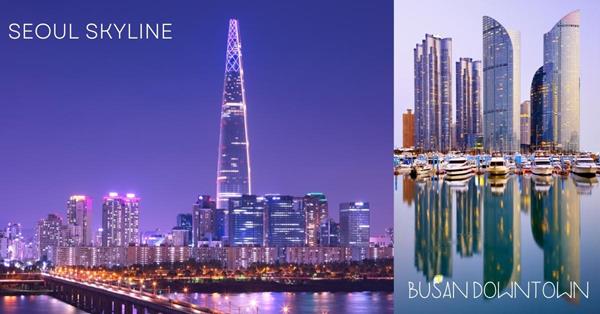
The easiest way to reach Busan from Seoul is by KTX high-speed train, which takes under three hours. You can also take the slow train, which is more affordable than the KTX. It would take you anywhere between 2.5 hours to 5.5 hours, depending on the train type that you will ride.
The costs also vary. Riding a bus would take you four hours to reach your destination. You can also ride the plane, which is the fastest and most expensive option.
One of the reasons why Busan is well-known is because they have the largest traditional market and seafood market in South Korea. There is also a great variety of street foods which are perfect for foodies, their speciality being eomuk or fish cakes or tasty Korean instant noodles , which are available in grocery stores and even food stalls. With that being said, here are the places to visit/ things to do in Busan:
- Attend Lantern Festival, which they celebrate during the spring season (May)
- Book a full-day city tour
- Haeundae beach
- Gwangbokdong food street or join a traditional food cooking class
- Samjin Eomuk main storer and museum
- Enjoy an afternoon cruise
- Busan Tower & Yongdusan Park
- Day trip to Oedo Island or Tongyeong
- Visit the cool Jusangjeollidae
Accommodations in Busan :
- Affordable: No.25 Hotel or Seri Inn Guesthouse
- Mid-range: Residence Mumum Hotel or Toyoko Inn
- Luxury: The Westin Josun or Arban Hotel
If this list is not enough for you or you don’t find suitable accommodation, check this detailed article about where to stay in Busan .

Jeju for 2 days
There are six ways to reach Jeju from Busan, one of which is by ferry. The travel time would last for 11 hours. You can also ride the train or bus and then ride a plane for about a little over 3 hours. Car rentals are also an option, then riding the ferry, which would take more than 6 hours.
The most recommended option would be to take the subway and ride the plane afterwards, which would take around 2 hours and 40 minutes.
Aside from otherworldly natural scenery, Jeju is also famous because of its unusual theme parks and commercial attractions. Here are some of the places to visit in Jeju:
- Osulloc Tea Museum
- Attend the Jeongwol Daeborum Fire Festival, which usually happens during the winter season (February or March)
- Mount Hallasan – go for a hike with local lunch
- Take a Submarine tour
- Manjangul Cave – you can book a transportation to and from
- Yeomiji Botanical Garden
- Book an organised full-day tour for Jeju Island
- Explore the famous Museum of Sex and Health
Accommodations in Jeju City :
- Affordable: You&I Guest House or Bricks Stay
- Mid-range: Ganderak Guesthouse or Ventimo Hotel & Residences
- Luxury: LOTTE Hotel or Grand Hyatt Hotel
10 days in Japan
Aside from anime and mangas, Japan is well-known for the plethora of snacks and beverages that can be found in its convenience stores and vending machines. They have a wide variety of fresh foods and snacks that you seriously won’t run out of options.
Japan also have a vast expanse of beautiful natural scenery, as well as places and trinkets with a kawaii aesthetic. Japan has such visual diversity that you’ll indeed find your trip to this country unforgettable. But most importantly, tourists love Japanese cultural etiquette.
The places are clean, the trains are always punctual, and most people are courteous and polite. If you are a history buff, there’s also something waiting for you. Hopefully, we’ve piqued your interest in having a vacation in this country and for that, here’s the Japan itinerary for 10 days.
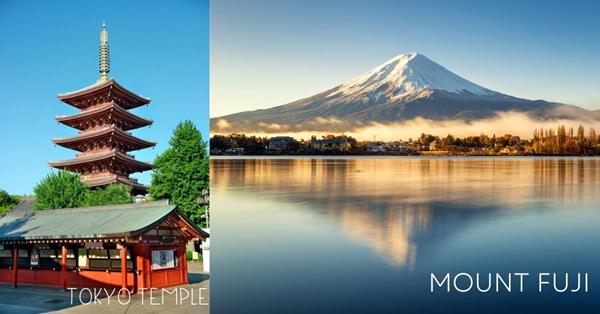
Tokyo for 5 days
Tokyo is a bustling yet organised city. Public transport is often on time, so you don’t have to worry about being late. You can get around the city pretty easily or get a hop on-hop off bus ticket or a Tokyo metro pass . There are many things to do and places to see in Tokyo, but some are only seasonal. Let’s first talk about places you can visit and things you can do in Tokyo all year round:
- Tokyo Skytree observation deck – get your ticket
- Visit Kawaguchi Lake with a Mount Fuji view – book a tour with lunch
- Digital Arts Museum – great for all ages, but for people with autism (especially with light sensitivity, this might be overwhelming) – buy your entrance ticket in advance
- Imperial Palace – join a walking tour with a local guide
- Visit Tsukiji Market (fish market) and learn how to roll a sushi – book a tour
- Enjoy a traditional Yakatube dinner on a cruise
- Learn about rame through this ramen tasting tour
- Join a half-day cycling and cruise tour
Accommodations in Tokyo :
- Affordable: Hotel Owl or bnb Hostel
- Mid-range: Hotel GrandBach or Shiomi Prince Hotel
- Luxury: The Capitol Hotel or The Gate Hotel
Here are some of the places you could visit during the winter:
- Skating rink at Toshimaen amusement park
- Tokyo German Village
Some of the things you could do during summer:
- Attend a fireworks summer event
- Try out kakigori , one of their summer foods
Things to do or places to visit in spring:
- Attend a Japanese Spring Festival
- Try out sakura-flavoured foods and delicacies
- Walk in parks to see cherry blossoms up close
Hokkaido for 3 days
Hokkaido has been included as one of the top destinations for travellers in Japan. They have various natural scenery, coastline villages, historical sights, and the freshest seafood. You could ride a plane, a bullet train, or a ferry or rent a car to reach Hokkaido if you come from Tokyo.
Here are some of the places to visit and things to do in Hokkaido, or you can book a customised city tour :
- Attend Sapporo Snow Festival during the winter
- Take a stroll at Matsumae Park during the spring season
- Daisetsuzan Mountain Range
- Noboribetsu Onsen
Accommodations in Hokkaido :
- Affordable: Tune Hostel or Tmark City Hotel
- Mid-range: Hotel Amanek or Toyoko Inn
- Luxury: Hotel Nets or Tenza Hotel and Sky Spa
Hiroshima for 2 days
Hiroshima is known to be the first city hit with an atomic bomb, but that’s not what the city is only known for. Hiroshima is famous among museum lovers because of the abundance of museums there. They also have tons of parks, historical wonders, and festivities all year round.
To reach Hiroshima from Hokkaido, the fastest and most recommended mode of transportation would be to ride a bus, then a plane, which would last for four hours. Some other options include taking a train, driving a car, taking a car ferry, or taking the bus. The travel times for these could last between 13 hours to 32 hours.
Here are some of the things to do and places to visit in Hiroshima once you’ve reached your destination:
- The Island Shrine of Itsukushima
- Hiroshima Castle – explore Hiroshima on a bicycle
- Shukkei-en Garden
- Have fun shooting arrows traditionally
- Hiroshima Museum of Art
- Learn about Japanese culture – book this cultural tour in a Kimono
- Hiroshima Peace Memorial Park
- Explore the city through this cycling tour
- Hiroshima Atomic Bomb Dome
- Explore Hiroshima and Miyajima in a day – book a guided tour
Accommodations in Hiroshima :
- Affordable: Capsule Hotel Cube or Santiago Guesthouse
- Mid-range: Daiwa Roynet Hotel or Candeo Hotels
- Luxury: Hilton Hotel or Sheraton Grand Hotel
SUMMARY OF 3 WEEKS IN SOUTH KOREA AND JAPAN
Combining all the days spent in these places, you’ll get to stay for 3 weeks in South Korea and Japan. With that being said, here are some other additional know-how during your travels:
When in Seoul, you could get an integrated palace ticket which will grant you entry to all five palaces and costs way less than buying separate tickets for each. You could also look on different sites for discount passes, and if you’re planning on doing physical activities, you might want to consider getting travel insurance.
You can also study some of the most common phrases used in your destination countries, purchase a travel dictionary, or download an app to make conversations more seamless. That’s about it, we hope that you’ll have a great time visiting these countries that have so much to offer and that you found this itinerary of 3 weeks in South Korea and Japan helpful in creating your own itinerary .
SAVE THIS TRAVEL ITINERARY ON YOUR PINTEREST:
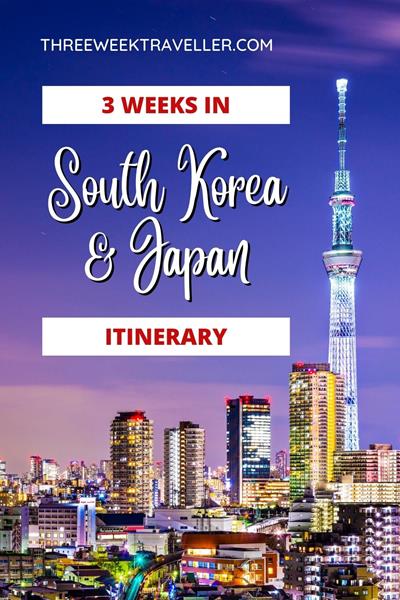

- Best Hikes In The World
- Appalachian Trail
- European Hikes
- Nepal Hikes
- Patagonia Hikes
- See All Hikes
- Mount Kenya
- Mount Kilimanjaro
- Mount Toubkal
- See All Mountains
- South Africa
- New Zealand
- Switzerland
- United Kingdom
- Packing Lists
South Korea vs Japan: Which Country Is Best For Adventure Travel?
Both South Korea and Japan are filled with adventure opportunities alongside the rich cultural experiences they offer. Deciding which country is best ultimately depends on what adventure experiences you’re looking for.
In this guide, we’ll explore some of the main adventure travel activities you can do in each country to see where you should travel next.
Wherever you go, make sure that you soak up the unique culture as well!
Joining small group or private tours to Japan is a great idea if you want to see the absolute best this destination has to offer. The same can be said of South Korea tours - having the logistics handled and a professional guide to show you around allows you to experience the country like a local.
If you love mountains, hiking, and outdoor adventure in general, then you’ll have a great time in either country. Just make sure that you plan your trip carefully to visit at the right season for the activities you want to do.
South Korea: Hiking Options
Jirisan national park: hiking for all levels.
Jirisan National Park is also a hiker's paradise with trails for everyone. The Baemsagol Valley Trail is perfect if you're up for a challenge, winding through lush greenery and offering a real sense of accomplishment.
For a more relaxed hike, the Nogodan Trail provides breathtaking views without the intense climb. It's a great choice for families or beginners.
This national park is covered with lush green mountains and epic views wherever you look. It’s the perfect escape into nature while you’re in South Korea.
Seoraksan National Park: Epic Hiking in Nature's Beauty
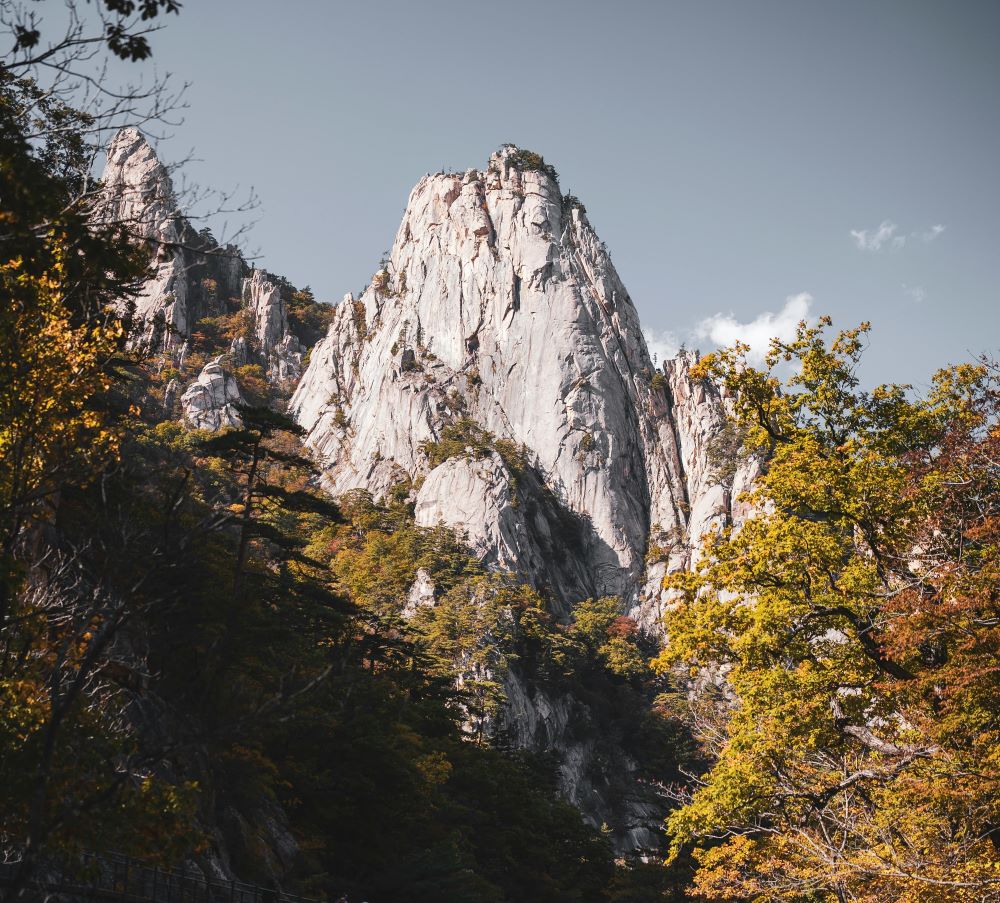
Seoraksan National Park is a dream for hikers. This park is filled with beautiful hiking trails, which are suitable for hikers of all experience levels.
The Dinosaur Ridge Course is one of the most popular trails. It’s like a rollercoaster for your legs, with steep climbs and rocky paths that keep your heart pumping. But the reward at the top is unbeatable panoramic views and a thrilling adventure.
For those who prefer a more laid-back hike, there are easier trails like the Ulsanbawi Rock Course, offering stunning views of the park's unique rock formations.
Hallasan Mountain on Jeju Island: South Korea’s Tallest Peak
Hallasan Mountain is the king of peaks in South Korea. If you’re going to go hiking in this country, then this is the peak you’ll want to conquer.
The Eorimok Trail is a favourite among adventurers, taking you through diverse landscapes to the summit. The views from the top are mind-blowing.
If you're into volcanic landscapes, the Manjanggul Cave nearby is a fascinating exploration. A day in Jeju can easily mix hiking and visiting unique natural wonders - a top recommendation if you’re visiting this part of South Korea.
Japan: Hiking Options
Mount fuji: japan's iconic peak.
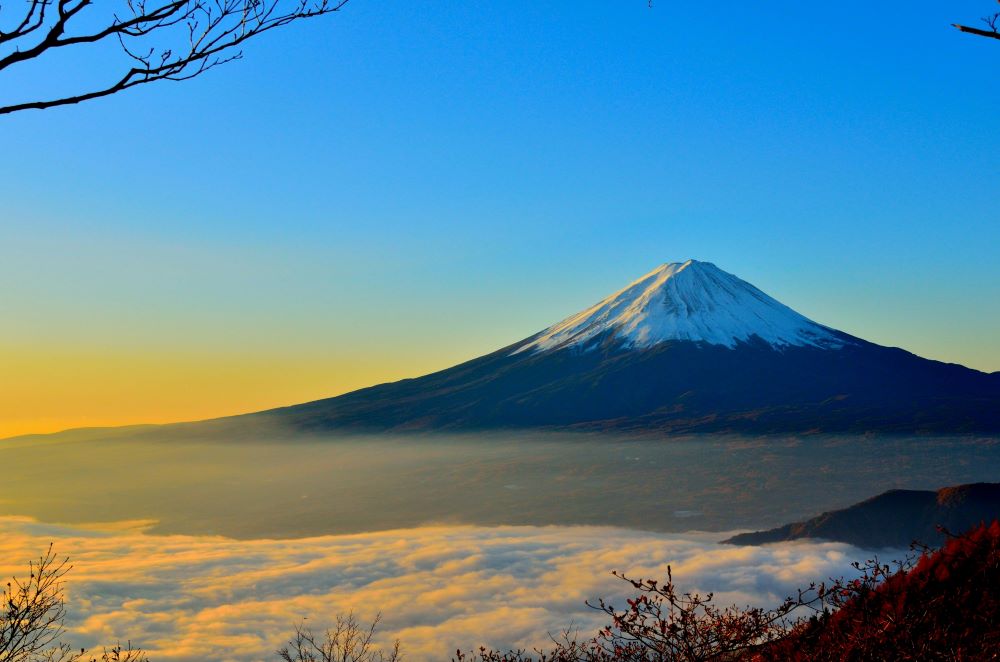
Mount Fuji is the star of the show when it comes to hiking in Japan. This is Japan’s tallest peak and the country’s greatest natural icon; it’s often considered one of the best hikes in Asia .
There are a couple of different routes available if you want to climb Mount Fuji . This includes variations for hikers of all levels. The Yoshida Trail is a classic route, offering a challenging yet rewarding climb. The sunrise from the summit is legendary and attracts adventurers from around the world.
For those seeking a less crowded experience, the Subashiri Trail provides a more serene journey through forests and volcanic landscapes. Both trails promise stunning views and a sense of accomplishment.
Being one of the most beautiful mountains in the world , Mount Fuji is an incredibly rewarding hiking experience. From the base to the summit, hikers are rewarded with some of Japan's most amazing views and scenery.
The Japanese Alps: A Haven for Hikers
If you’re going to hike in Japan , then you’ll also want to experience the Japanese Alps.
The Japan Alps, divided into Northern, Central, and Southern ranges, offer diverse hiking experiences. The Kamikochi Valley in the Northern Alps is a picturesque destination with easy trails suitable for beginners. The Tateyama Kurobe Alpine Route in the Northern Alps combines hiking with breathtaking scenic views.
The Kiso Valley in the Central Alps boasts the Nakasendo Trail, connecting historic post towns. It's a perfect blend of cultural exploration and moderate hiking. The Southern Alps, with the Senjojiki Cirque, present a challenging yet mesmerizing alpine environment.
Hikers can spend weeks here exploring the many different trails on offer. The scenery also changes dramatically with each season, with hiking being at its best during the Spring when the cherry blossoms are out.
Yakushima: Mystical Forests and Coastal Wonders
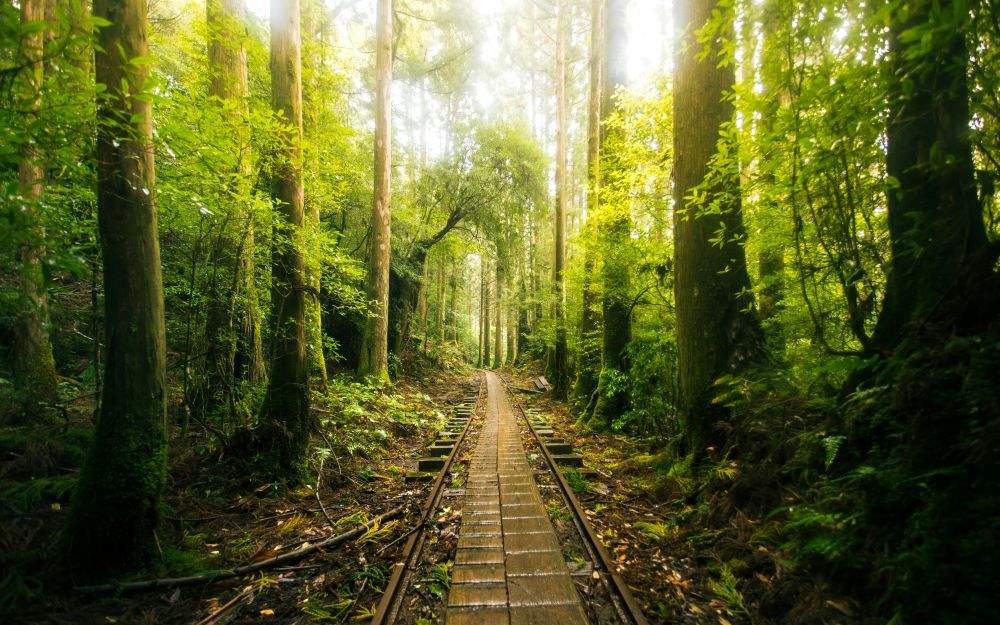
Yakushima, a UNESCO World Heritage site , invites adventurers to explore mystical forests and coastal wonders. The Shiratani Unsuikyo Ravine is a highlight for hikers, with moss-covered trails and ancient cedar trees creating a surreal atmosphere.
The challenging trek to Jomon Sugi, one of the oldest cedar trees in Japan, is a must for experienced hikers.
The island's diverse landscapes make Yakushima a unique destination for nature enthusiasts. Whether you want to go on a challenging hike or just want to soak up Japanese nature, then this is one of the best places to do it.

Japanese Via Ferratas: Scaling New Heights
Japan offers thrilling via ferrata experiences, combining hiking with rock climbing.
The Daikanbo Via Ferrata in the Northern Alps provides stunning views of the Chubu Sangaku National Park. It's an adventure suitable for both beginners and seasoned climbers.
The Karasawa Via Ferrata, also in the Northern Alps, offers a more challenging route with exposed sections and breathtaking alpine scenery.
Other Adventure Travel Activities in South Korea
Riding rapids on the donggang river.
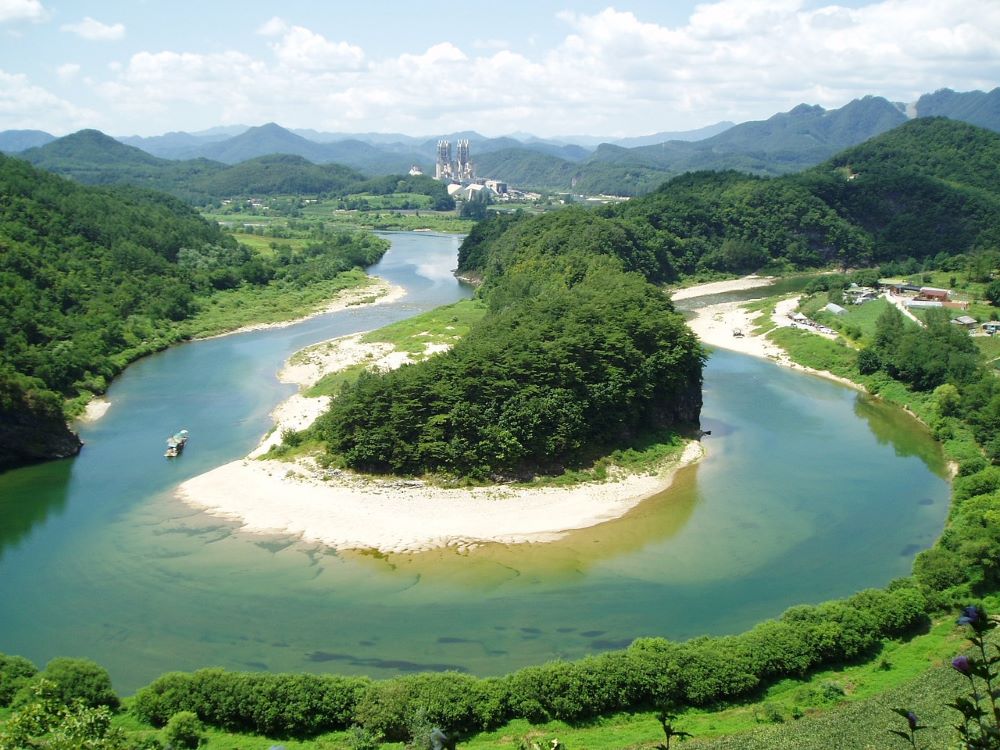
For water thrill-seekers, the Donggang River's white-water rafting is an absolute blast.
The rapids add an exciting twist to your adventure, and you don't need to be an expert to enjoy the ride. You can take guided white river rafting trips down the river to experience the thrill of these rapids in a safe environment.
Rock Climbing in Bukhansan National Park
South Korea's adventure scene isn't just about hiking - rock climbing is another well-loved activity here.
Bukhansan National Park is a rock climber's haven with challenging routes. Whether you're a pro or just starting, the varied terrain has something for everyone.
If you want to experience the best of this park, then consider doing the 5 Summits Traverse - a classic adventure day that leads you up to an intense ridge. There’s also the Seoninbong - a tall peak known for its difficult bolted slab routes.
Baekundae is the highest peak in the park at 836m. There are fewer routes up here and it can get quite crowded. Of course, the views from the summit are awesome.
Uiam is another climber's favourite. This is a single monolith with a few routes to climb up. It’s a more moderate climbing option for those who don't want to take on the more intense climbs in the park.
Ice Climbing in Cheongsong
South Korea's adventure scene doesn't hibernate in winter. Cheongsong Valley becomes an ice-climbing paradise. Of course, you need to prepare for the cold, but the thrill of scaling icy heights is a unique experience you won't forget.
You can take guided ice-climbing trips, which include all of the gear you need for this adventure activity. This is suitable for new and experienced ice climbers.
Scuba Diving
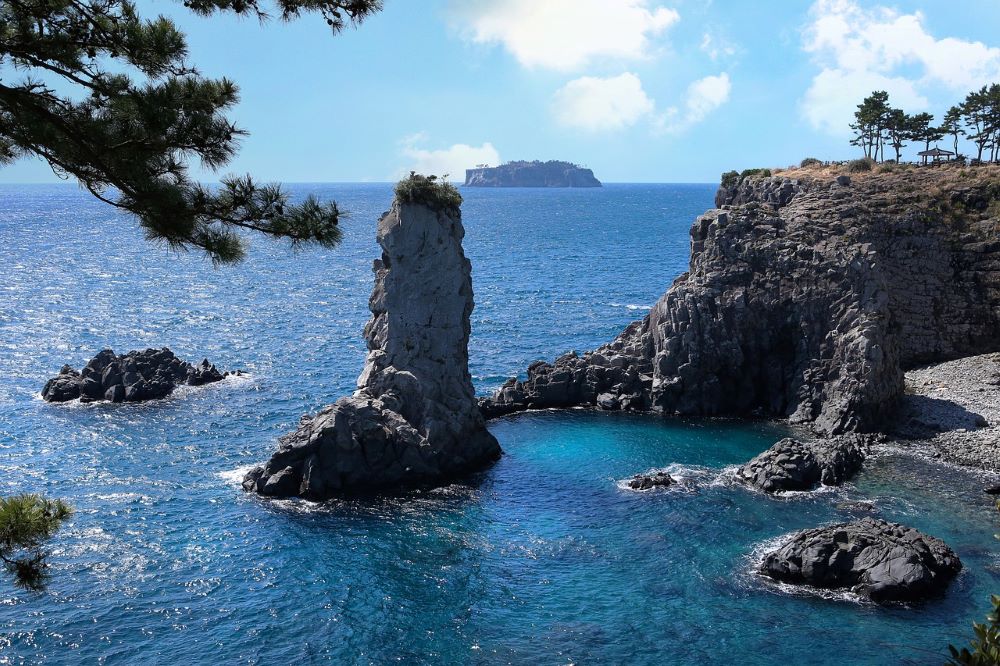
While there’s plenty of fun to be had in the mountains of South Korea, head to the coast and you’ll also find some amazing scuba diving opportunities.
Scuba diving is mainly done along the sojourn part of the country’s east coast, as well as around Jeju Island. The waters are warm, and you can experience a range of sandy bottom dives, beach dives and reef dives.
Experiencing New Heights
If you’re after some high-flying adventure, then South Korea has a range of adrenaline-fuelled options.
You could go sky diving or hot air balloon riding over the country. Bungee jumping the country’s highest jump at Jecheon City (62m) is another thrilling option.
Adventure travellers can also enjoy a seriously impressive ziplining course at the Hadong Alps Leports. It’s possible to reach 120km/hr on this 1.5 km-long ziplining trail.
And with all of the mountains comes plenty of paragliding opportunities. You can do this across the country, with many popular launch sites existing along booking trails.
Other Adventure Travel Activities in Japan
Ski and snowboard the mountains.
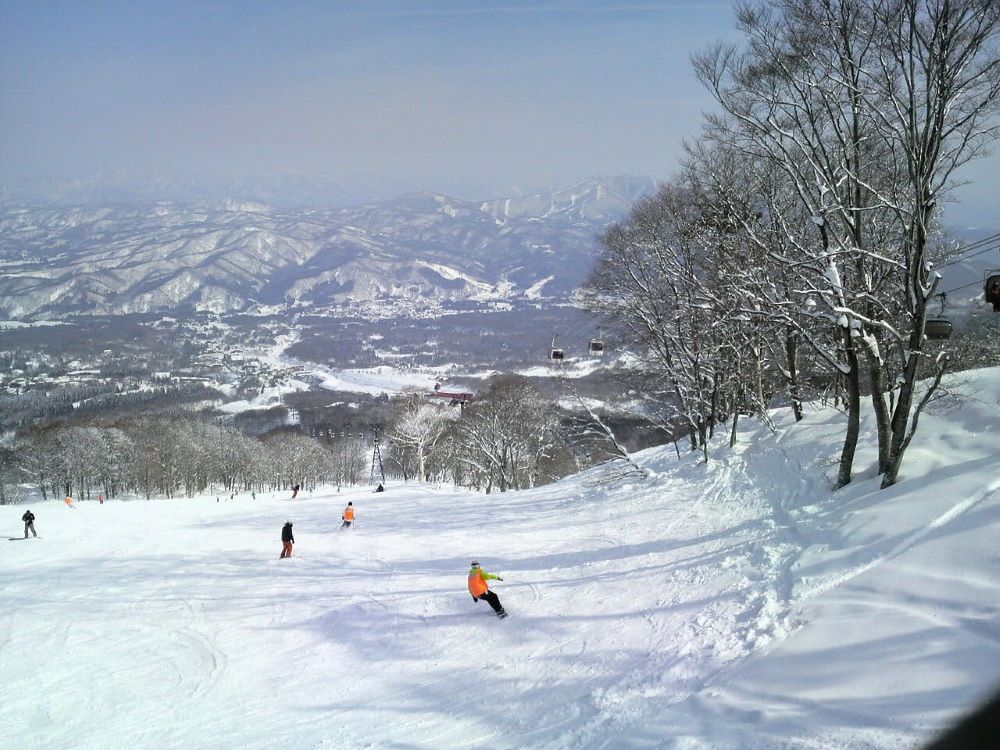
Japan's adventure scene adapts to each season. In winter, the country transforms into a winter sports paradise, with skiing and snowboarding in places like Niseko and Hakuba.
There are plenty of great ski resorts around these parts of Japan, with slopes suitable for all experience levels. If you’re after some of the best winter skiing outside of Europe, then Japan should be on your list.
Shirakawa-go and the Noto Peninsula: Cultural and Coastal Adventure
For a unique blend of cultural exploration and outdoor adventure, head to Shirakawa-go and the Noto Peninsula. The traditional thatched-roof villages of Shirakawa-go are surrounded by scenic landscapes. Hiking through this cultural treasure provides a glimpse into Japan's rural history.
The Noto Peninsula offers coastal hiking with stunning views of the Sea of Japan. The Noto Kongo Coastline Trail is a great way to combine seaside exploration with outdoor adventure.
Surfing and Kayaking
Japan's extensive coastline provides excellent opportunities for surfing and kayaking enthusiasts. The beaches of Shonan near Tokyo and the Chiba Peninsula are popular surf spots, offering some great waves - especially during typhoon season.
For kayaking, the crystal-clear waters of Okinawa provide a serene yet exciting adventure. You can explore sea caves, coral reefs, and hidden coves, immersing yourself in Japan's coastal beauty from a different perspective.
South Korea vs. Japan: Which Country is Best for Adventure Travel?
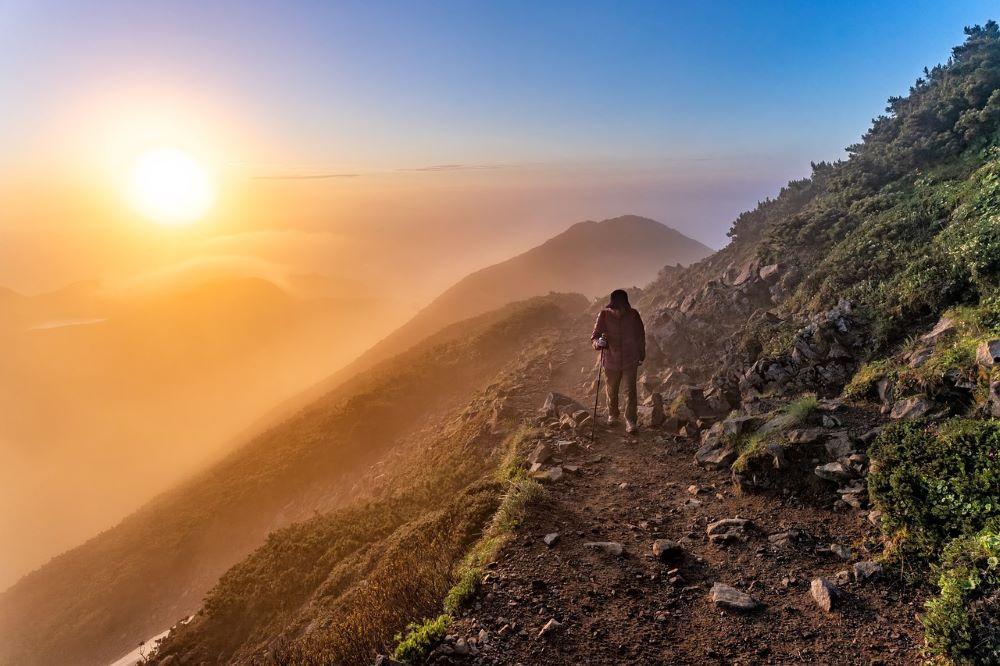
So, which country is better for adventure travellers?
Both South Korea and Japan offer many thrilling activities, including plenty of mountains and hiking opportunities.
Overall, Japan is a more popular and iconic adventure destination, as it includes the impressive Mount Fuji, the tall Japanese Alps, and offers a greater range of winter sports activities.
However, South Korea still has plenty of amazing national parks, with beautiful protected mountains, and it tends to be cheaper to visit. Jeju Island is also the better option for sunny beaches and ocean adventures.
If you’re looking to tick off bucket list hikes, go to Japan. If you’re looking for a lesser-known adventure destination, consider South Korea.
About the author
Alison Macallister
With a degree in Nature Conservation and experience working with wildlife including the Big 5, Alison used to work as a guide for a 5-star safari reserve in South Africa. Today she is a full time traveller and editor for Mountain IQ. She has travelled and hiked extensively in South America, including many solo hikes in Patagonia, the Cusco region of Peru, Ecuador and Chile.
Leave a Reply
Your email address will not be published. Required fields are marked
We work with local guides to offer great value adventures at unbeatable prices.
- Skip to primary navigation
- Skip to main content
- Skip to primary sidebar

Destinations
Experiences.
- Photography
Plan Your Trip

Is Korea Really the Poor Man’s Japan?
January 7, 2023 by Robert Schrader Leave a Comment
When the topic of Korea vs Japan travel comes up, you might assume the discussion is historical, political or even racial—that’s not what this post is about. Rather, I’m going to explore the key differences between these two amazing countries where travelers are concerned, and help you decide which is best to visit.
Some of these will be practical in nature, whether you’re asking “is Japan expensive?” (either in comparison to South Korea , or as a standalone question), or want to know how far English will get you in either country (Spoiler alert: not very!).
I’ll also be exploring the difference between Japan and Korea in a more esoteric sense, weaving in stories from my two dozen combined trips to the two countries to entertain you a bit as you make your decision. (Assuming you don’t simply decide to extend your trip and visit both!)
When it comes to Korea or Japan, which is better to travel?
My Own Experience with Korea vs Japan
Before my first trip to Korea, a well-meaning friend of mine told me that “Korea is the poor man’s Japan” (which, side note, is a ridiculous statement, since Korea is at least as expensive as Japan—but I digress). I landed in Seoul the first time very much in love with Japan and believing Korea couldn’t possible measure up; this prophecy was largely self-fulfilling. Why is Japan more popular than Korea? Part of it may be simply because so many people ask this question.
Indeed, my views have moderated as I’ve traveled in Korea more, but I still wouldn’t say that the question of Japan vs South Korea travel is a draw. Japan is still a far superior country for travelers in my opinion, even if South Korea has more redeeming factors (and, to be sure, a slightly wider array of destinations and experiences) than I initially gave the country credit for.
Key Ways to Compare Korea vs Japan
Japanese culture vs korean culture.
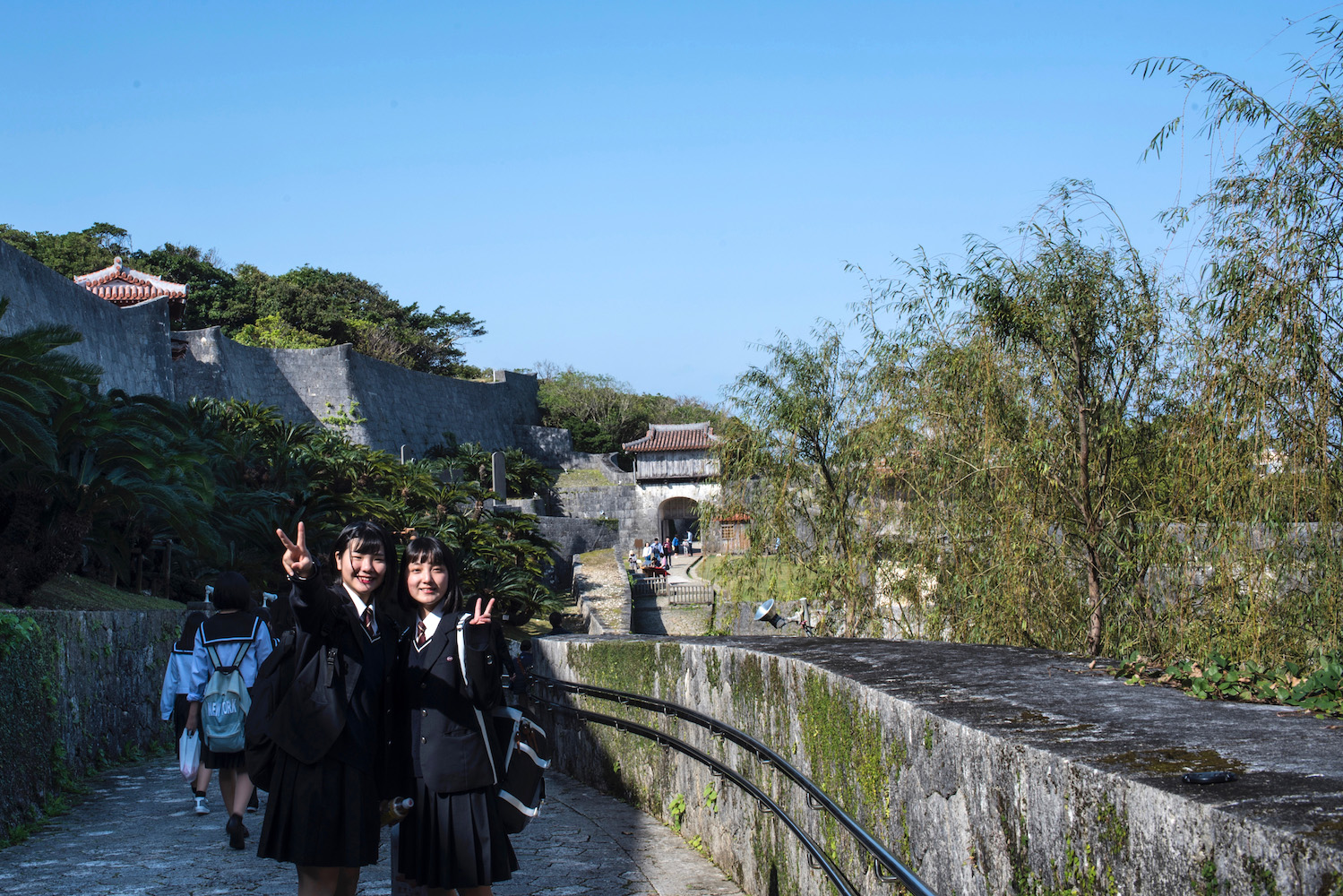
Let’s be clear: A post on a travel blog is not the proper venue to have a sophisticated discussion of Korea vs Japan culture. However, from practices like the Japanese tea ceremony and the Korean hanbok costume, to the way people in Japan and Korea welcome strangers (or don’t), I prefer Japanese culture in every conceivable way. One (possible under the influence of my aforementioned) friend I wholly believed that the entire of Korean culture was a rip-off of Japan’s (and China’s), though I’ve somewhat walked that back in recent years.
Korean Food vs Japanese Food
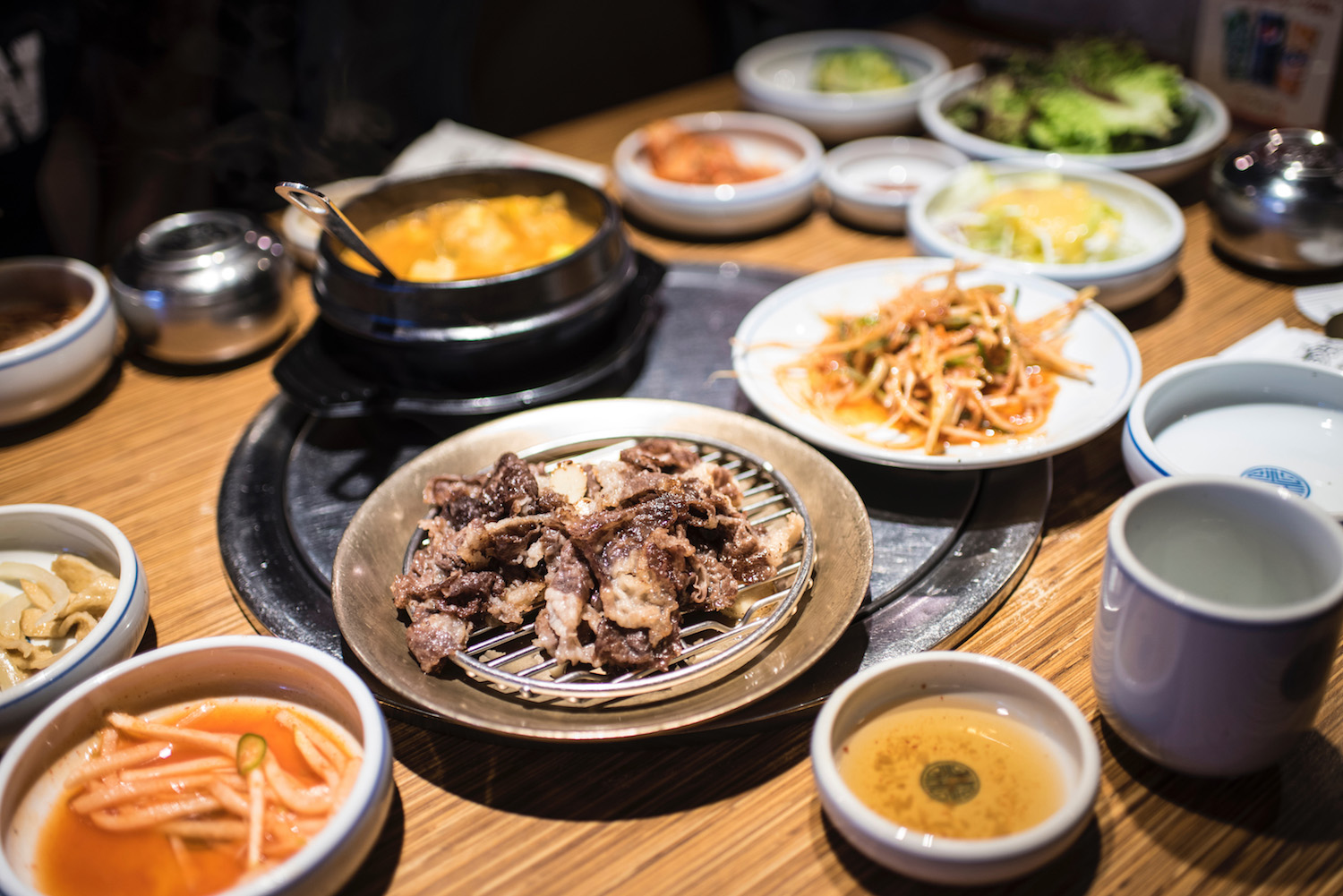
Whether you travel from South Korea to Japan or vice-versa, you’re in for a culinary treat. Largely, I would say that Japan’s cuisine is more diverse , ranging from delicate dishes like sushi and sashimi to down-home comfort food like tonkatsu fried pork cutlet and ramen noodle soup. Korean food has some range too (beyond kimchi and bibimbap , you can enjoy kimbap rolls and dakgangjeong fried chicken), but I still give the nod to Japan overall in this category.
Destinations in Korea and Japan
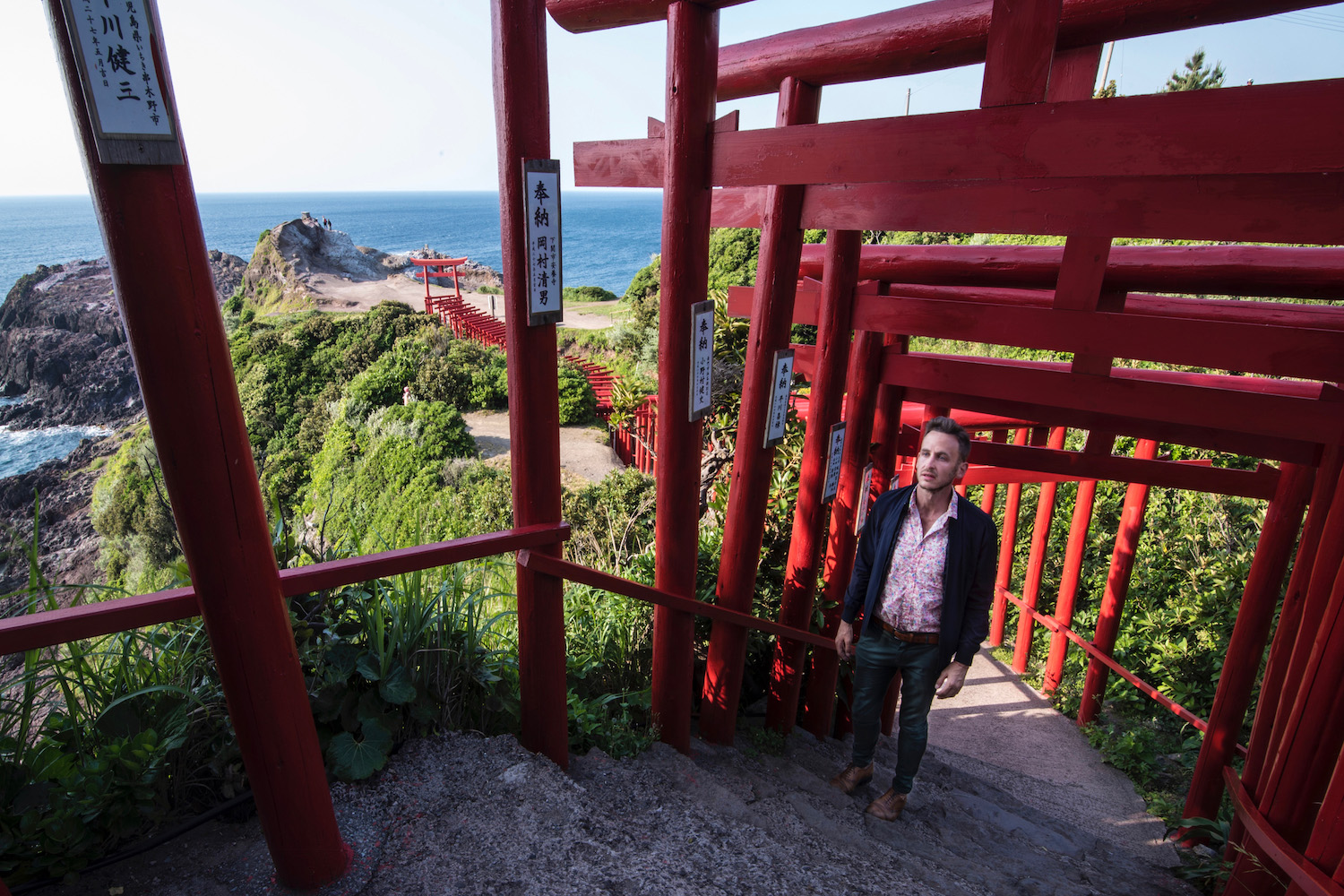
Comparing Korea or Japan in terms of destinations (and experiences), there is simply no contest: Japan wins hands down! Japan destinations , for example, span several exciting regions: Tohoku , Kanto , Chubu , Kansai and Chugoku ; as well as the islands of Hokkaido , Kyushu and Shikoku ; and the Okinawa archipelago. While I’ve slowly come to realize that Korea is more than just Seoul and Busan as time has passed, it’s just got nothing on Japan in the variety department.
Cost of Travel in Japan vs Korea
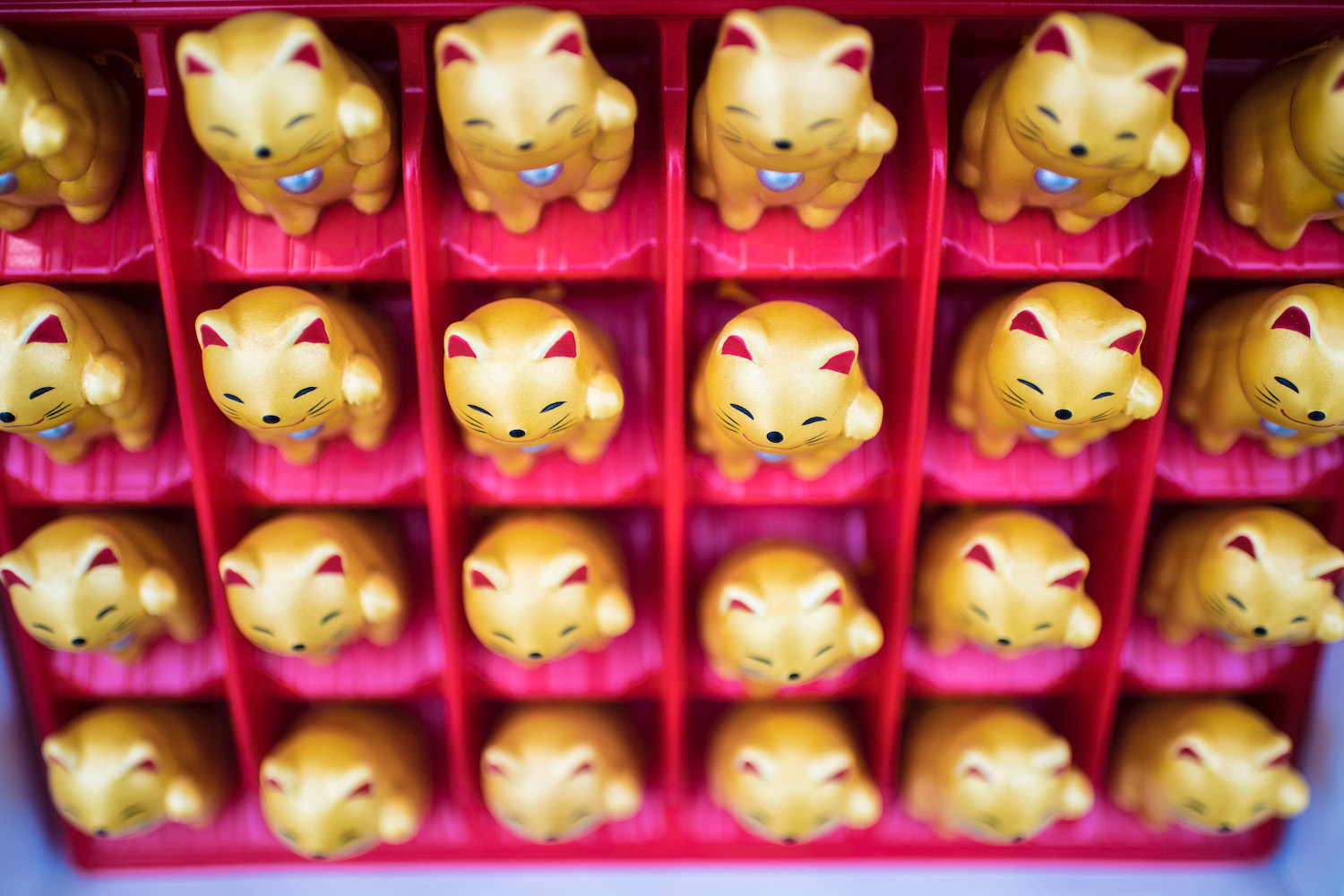
Is Korea expensive? Of course it is—and so is Japan. However, while prices of some things like city hotels (say, Tokyo’s Hotel Felice Akasaka and Makers Hotel Seoul ) tend to be pretty congruent, I would generally say that Korea is slightly cheaper. Korea’s smaller cities and towns, for example, are significantly cheaper than major metro areas; this is not the case in Japan. On the other hand, Korea’s paltry rail pass falls far short of the savings offered by the Japan Rail Pass .
Speaking English in Korea vs Japan
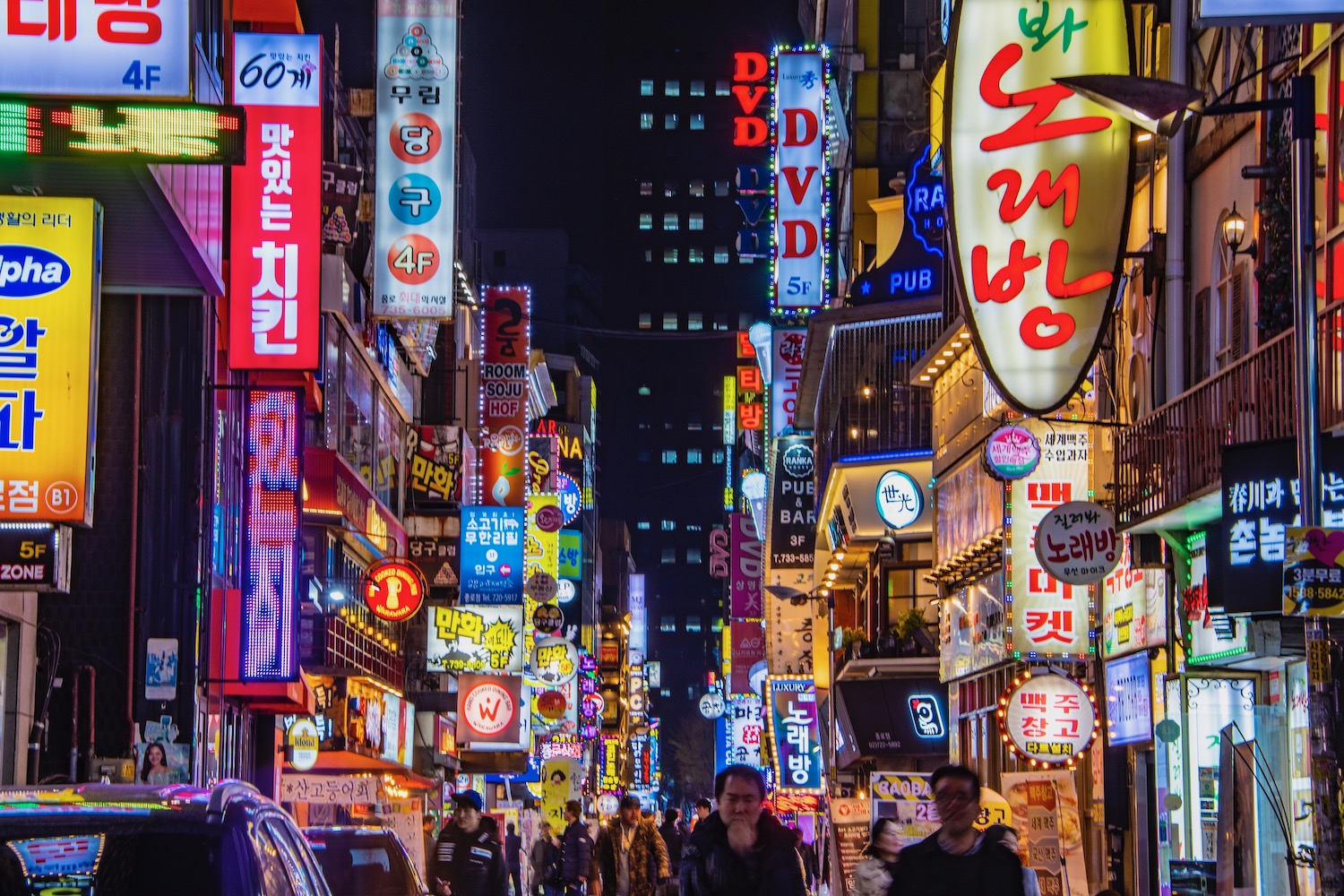
How Long to Spend in Japan and Korea
An important practical element of the discussion of Korea vs Japan travel is how long to spend in each. Japan has significantly more regions (which are significantly more interesting, and have many more destinations within them) than Korea—your trips to Japan will be longer than those to Korea out of sheer necessity.
In general, I would say that the shortest itinerary you can get away with for your first trip is 3 weeks in Japan vs about a 10 days in Korea itinerary. Naturally, this element of Japan vs Korea travel becomes less important if you’ve already visited either country, or if you’re 100% sure you’ll be able to return to either (or both) in the future.
Plan Your Trips to Korea and Japan
Regardless of what you end up deciding RE: Japan or Korea travel (i.e. whether to visit one country or both, at what time of year and for how long), planning your trip can be a whole other animal. This is at once a matter of nuts and bolts (which cities and regions in Japan do you visit, and how do you structure your food trip to Korea) as it is an esoteric question: How do you want to feel when you step back on the plane to go home, and how do you translate that into an itinerary?
Other FAQ About Korea vs. Japan
How is korea different from japan.
The main difference between Korea vs Japan, in my opinion, is that technology is slightly more important than tradition in Korea, while slightly less so in Japan. Additionally, while both Korea and Japan are relatively xenophobic countries, I feel that the Japanese tend to tolerate foreigners better, at least in public.
Is Japan richer than Korea?
Although Japan has a higher GDP (and GDP per capita) than Korea, I don’t necessarily think that Japan feels richer than Korea in reality. There’s a certain austere manner to the Japanese, and a very profound level of dilapidation in some more rural prefectures, even in smaller cities—you don’t see this in Korea. This isn’t as obvious in Korea vs Japan travel, of course, as it is if you live in either country.
Is South Korea cheaper than Japan?
Honestly, this depends on which aspect of Japan vs Korea travel you’re talking about! While hotels in Korea are perhaps cheaper than those in Japan on an absolute basis, I think the value of Japanese hotels (at least in major cities) is better. Korea is cheaper than Japan, but Japan offers more richness as a travel destination.
The Bottom Line
Japan or Korea—which is better for holiday? The question of South Korea vs Japan travel is a contentious one—even before broaching the topic of travel, and to say nothing of the Seoul vs Tokyo debate. But while both of these countries offer travelers a great deal of return-on-investment, they’re not the same, whether because of practical factors like the cost of travel in either, or the historical and cultural differences that underlie both ancient and modern tensions between their people. Taking a short trip to Asia, but want to squeeze Korea and Japan into your itinerary? Hire me as your Travel Coach!

Subscribe to email updates!
Words, images and design ©2009-2024 Robert Schrader, All rights reserved. Read Privacy Policy or view sitemap .
Korea Vs Japan – What is the best East Asia country?
Korea or Japan? Which Eastern Asia country should you visit next? They are internationally known for their unique culture, unique experiences, and amazing activities. We will explore everything you need to know about each country and determine which fits you best and where you will have the most fun.
So, which is the best option for traveling? And more importantly, which fits you better? These countries offer a wide range of activities for different kinds of travelers; they are similar in many ways but also very different.
Page Contents
Japan vs Korea – Quick info
- Breathtaking nature and general beauty
- Unique culture and heritage
- Famous landmarks and temples
- The amazing Mount Fuji
- Great nightlife with some unique offerings
- Great shopping
- Some of the best food in the world
- Surprisingly inexpensive, apart from transports
- Good hiking opportunities
- Spotless country
- Amazing tropical Beaches (Okinawa only)
- Lovely country, but not as beautiful as Japan
- Unique Culture and Heritage
- Good nightlife
- Excellent shopping
- Good food with lots of new flavors
- Relaxed and friendly locals
- Beautiful but lesser-known landmarks
- Inexpensive for such a developed country
- Clean country
- Some good lesser-known hiking trails
- Good Beaches in Busa and Jeju

To better compare Korea and Japan and to help you decide which destination is best for your next vacation, we will analyze the following topics:
- General beauty;
- Tourist attractions;
- Culture and heritage;
- Eco-friendliness;
- The people;
- Travel infrastructure;
- Travel safety;
- Tourist index;

Now, if you are looking for complete guides to Japan or Korea, have a look at:
- Everything you need to know before traveling to Japan
- Everything you need to know before traveling to Korea
South Korea vs Japan – Travel
General beauty.
Both Japan and Korea are beautiful countries with many lovely sights and places to explore, so determining the most beautiful is subjective and varies from person to person.
We found Japan to be really special. The cities are lovely, mixing modern and traditional elements. In Japan, you can find a bit of everything, from traditional architecture and historic temples to modern and impressive buildings. Surprisingly, it was the countryside, mountains, and forests of Japan that swept us away. Everything is so clean and pristine.
Korea boasts its own beauty, with ancient palaces, vibrant markets, and the natural wonders of Jeju Island. Similarly to Japan, each region in Korea has its unique charm, from the bustling streets of Seoul to the serene landscapes in places like Gyeongju and Suncheon.
Both countries have seasonal highlights with the cherry blossoms in April and the fall foliage in October/November, which attract thousands of people to witness them.
We will give this one to Japan, as we enjoyed Japan’s general beauty more than Korea’s, but it really depends on personal preferences, interests, and the type of experiences one is seeking.

Tourist attractions
Both countries offer beautiful attractions and landmarks, and curiously, many of them are similar, as they are neighbors who share a disturbed history, some religious beliefs, and cultural traits.
Japan is a beautiful country in terms of natural beauty and human-made landmarks. It is filled with lovely attractions, including some of the most gorgeous temples and shrines we have ever visited, relaxing gardens, historic castles, and villages. But it is also home to some wonderful natural landmarks like Mount Fuji, waterfalls, and even beaches like the ones in Okinawa.
Some of our favorite attractions in Japan include:
- Fushimi Inari Taisha, Golden Temple, Silver Temple in Kyoto
- Kumano Kodo trails and shrines
- Himeji Castle
- Itsukushima Shrine
- Kenrokuen Gardens
- Matsumoto Castle
- Shirakawa-go Village

Korea also has some impressive sights and landmarks, but they are lesser known than their Japanese counterparts. They are also arguably less impressive, but it really depends on your taste. We really enjoyed exploring Seoul’s Palaces and the island of Jeju, but it is difficult to beat Japan on this topic.
Some of our favorite attractions in Korea are:
- DMZ (Demilitarized Zone)
- All Jeju Island
- All five palaces of Seoul, but particularly Gyeongbokgung Palace
- Bukchon Hanok Villag in Seoul
- Hwaseong Fortress
- Gamcheon Culture Village in Busan
- The Silla temples in Gyeongju
- Jeonju Hanok Village

We believe that Japan wins this topic, as it has so much more diversity and famous landmarks. But it really depends on what you want to visit and explore. Korea is by no means depleted of attractions and cool things to do. On the contrary!
Culture and Heritage
Before visiting both countries, we thought this would be an easy win for Japan, but Korea has surprised us so much, and it has so much to offer that we must give this one a tie.
It may be shocking for some people, as Japan’s global influence is so evident, and its culture is unique and beloved. However, Korea is similarly unique and has made such an effort to export and promote its culture and heritage that it has become one of the most popular places in the world.
K-pop and K-dramas may be Korea’s most apparent cultural exports, but famous companies like Hyundai, Kia, Samsung, and LG are also Korean. Plus, when you visit Korea, everything is prepared to showcase its history and heritage. There are many free tours of the temples and palaces, and entry tickets to historical landmarks are inexpensive.
It is very different in Japan. Japan and Japanese culture have been popular for many years now. Everyone has heard of one or many Mangas, animes, Karate, and Sumo. Geishas and Samurais are part of Japan’s history but are also well-known everywhere.
Curiously, both countries are traditionalist and conservative, where hierarchy is essential. Historically, Japan has Shinto and Buddhist traditions, while Korea has Confucianism and Buddhism.
So, while Japanese culture is still more famous, Korea has been doing a better job lately of promoting it and becoming a new sensation.

Similar to general beauty, this item is very personal and depends on each person’s tastes and experiences. As we will explain below, both South Korea and Japan are very safe and have excellent infrastructure, but the people and society, despite sharing some characteristics, are quite different.
We found Korea much more relaxed than Japan and consequently more comfortable. Koreans are very friendly and not as uptight as Japanese. Furthermore, Korea actively wants visitors and attracts tourism, so it feels very welcoming.
I always felt that Koreans really wanted us to enjoy their country and show what it has to offer. So, traveling around and exploring feels very easy.
In Japan, everything felt more uptight because there were so many rules. Japanese have rules in almost anything, from the correct way to eat to the tea ceremony. They also seem to enjoy being in lines and having reservations about everything, which doesn’t allow visitors to be very spontaneous.
On the other hand, Japan is also known for its attention to detail and politeness and the peculiar cultural emphasis on avoiding confrontation.
For all this, we enjoyed and felt more comfortable in Korea than in Japan.

You may be thinking… beaches? who goes to Korea or Japan to go to the beach…? Well, indeed, the beaches aren’t the most important factor when visiting either country, but they do have beaches, and some are pretty good.
Furthermore, both Korea and Japan have a very different beach culture than other countries, as they don’t enjoy sunbathing and getting a tan.
In Korea, the best beach opportunities are located in Busan and Jeju. While Koreans don’t go to the beach to sunbathe, they have some good beaches, like Jungmun Saekdal Beach, Hamdeok Beach in Jeju, and Haeundae Beach in Busan.

While the beaches aren’t the first thing that comes to mind when visiting Japan, the truth is that Japan has some world-class beaches in its southernmost province, Okinawa. These beaches are renowned for their stunning beauty, clear turquoise waters, and vibrant marine life. The rest of Japan also has a few good beaches, like Wakayama and Kamakura’s surf beaches.
So, if you want to include a few beach days in your trip, Okinawa is your best option. It is also an opportunity to learn about different aspects of Japan and Japanese culture.
Both Japan and Korea are amazing shopping destinations, and determining which is the best is nearly impossible. It all depends on what type of goods you are looking for. For this reason, we will have to give it a tie.
However, we will try to explain what each country does best and where to go to buy each kind of product.
We believe Korea is your best option if you are looking for beauty products and modern fashion. South Korea is renowned for its beauty and skincare products. It has also quickly become a fashion-forward country, and you can find unique and stylish clothing in various districts, often influenced by K-pop and K-drama trends.
For beauty products, we suggest Olive Young, as it is the most popular and famous store in Korea. As for fashion, we were impressed with the Hongdae, Seoul stores.
Both Korea and Japan offer a wide array of electronics and luxury goods. If you are looking for luxury goods in Korea, you should go to Gangnam, while in Japan, to Ginza. While we did not buy luxury goods in either country, we were really impressed by the size of everything in Ginza.

Akihabara in Tokyo is the place to go if you are looking for electronics shops, as it displays the latest gadgets, cameras, and tech accessories. The stores are huge and have everything. It is fun just strolling around and seeing what they have!
What Japan really excels at is traditional goods and crafts. You can find beautiful ceramics, textiles, and pottery in just about everywhere. The attention to detail and the quality is incomparable.
Japan is also a paradise for unique merchandise, collectibles, and themed goods, particularly if you are a fan of mangas, anime, video games, and any other Japanese pop culture references. Curiously, Korea doesn’t have that many merchandise and collectibles from their cultural icons. At least, not that we could identify.

The nightlife isn’t among the most important things we look for when traveling, but Korea and Japan have vibrant nightlife scenes, particularly in large urban centers.
Both countries offer diverse entertainment options, from traditional performances to modern clubs and bars. They are also incredibly safe and have efficient and accessible public transportation options, which are very convenient at night. Plus, convenience stores are almost everywhere in either country if you want to eat or buy anything.
The most famous thing about Japanese nightlife is probably the neon-lit streets of Tokyo and Osaka. If you want to explore this, visit Shinjuku in Tokyo and Dotonbori in Osaka. They are unique and brimming with life. Just walking around is fun!
Izakayas are popular and informal spots where people gather after work or to socialize with friends. They are usually open until late and serve drinks and typical, casual, delicious food. You will find izakayas everywhere in Japanese cities.
However, if you are looking for a more typical nightlife, Roppongi (Tokyo) and Namba (Osaka) are the most famous for the bars, clubs, and entertainment options. Some of the most popular options include:
- Karaoke – most nightlife districts have karaoke joints where groups can rent private rooms to sing and enjoy drinks.
- Arcades games – also very popular, and we had a great time playing games
- Pachinkos – a singular form of legal gambling in Japan that involves vertical pinball machines where players purchase small metal balls and launch them into the machine. Only entering a Pachinko is an experience as it has a unique sound.
- Crane Games – Japanese love to play crane games, and you will find them everywhere. Usually, there’s a couple, and the boy is trying to win the prize for the girl…

Korean nightlife is a bit different but almost as lively. Regarding food, locals love Korean BBQ, where people can enjoy grilled meat, drink, and socialize. Another popular option is Chimaek, also known as Korean Fried Chicken and Beer. Going out to have Chimaek is a very popular casual and socializing night out.
Although more associated with Japan, Karaoke bars are also trendy in Korea and are a very popular nightlife activity. South Korea is also known for having many themed cafes; some stay open late at night. There are animal cafes, board game cafes, K-drama and K-pop cafes, and anything you can think of. They offer a unique and enjoyable experience.
The night markets are also very popular in Seoul, particularly in the Myeongdong and Dongdaemun areas in Seoul and BIFF Square in Busan. The Hongdae area in Seoul is known for its youthful and energetic crowds with indie music, street performances, and many clubs and bars.

This is a topic where both countries excel. The food in Korea and Japan is delicious, but despite sharing some characteristics and main ingredients, it is also very different. Either way, if you are a foodie or like to try local food and different dishes, you will have a great time in Korea and Japan.
Korean food is very different from Western food, with many unusual flavors and combinations of bold and spicy flavors. It incorporates ingredients like garlic, ginger, sesame oil, red chili flakes, and fermented vegetables (kimchi). It has a unique range of flavors and textures, but it can also be really spicy.
We enjoyed the flavors of Korean food, but we also liked the adventure of eating new things almost every day and discovering dishes, ingredients, and even techniques we hadn’t tried elsewhere.

Japanese food shares some similarities, such as rice and noodles being their primary carbohydrate source and strongly emphasizing seafood and other fresh ingredients. However, the essence is different; Japanese food is not spicy (there are exceptions), and the balance of flavors and freshness of ingredients are the most important things.
Most Japanese dishes are absolutely delicious, and it is challenging to find bad food, even in cheap places. I don’t think we have ever eaten consistently as well as in Japan, not even in Italy or Mexico . Plus, some Ramen dishes in the izakaya are an absolute splash of flavor.
This is why, despite having enjoyed almost everything about Korean food, we have to give Japan the win here.

The people – Japanese vs Korean
Another difficult topic, but for very different reasons. First, it is important to say that both Japanese and Korean speak very little English, and even those who speak have a hard-to-get accent. This makes communicating challenging for them and us.
Japan is famous for its unique hospitality rituals and etiquette. The staff is usually extensively trained to cultivate the skills and attitudes necessary for providing exceptional service. We understand many people enjoy this customer-first mentality, but the interaction felt almost fake and left us uneasy as it is strict, almost robotic even.
On the other end, the attention to detail, punctuality, politeness, and respect are amazing and something the rest of the world should learn from.
In Korea, communication is as difficult as in Japan, but people are less strict and easygoing, which makes us feel much more at home. People are amicable and warm both in service and in the streets.
It is very easy to feel welcome in South Korea, as most people want you to like their country and culture. They are attentive and helpful, even with hard language barriers.
For all this, we preferred interacting with Koreans and will give this topic to Korea.

Which is safer? Korea or Japan?
Both countries are perfectly safe, and throughout our time in each country, we have never felt insecure or in danger. We also never got scammed, nor did anyone try to scam us. On the contrary, people would get out of their way to help us.
For example, in convenience stores, sometimes there are 2-for-1 deals (or similar), and we didn’t realize it, and they would tell us that we could get another one free.
You may wonder if it is different at night; in our experience, it’s similarly safe. You would see young teenagers alone in the metro or children playing more and less freely. Public transportation is also incredibly safe – people fall asleep (because they are tired) regularly.
So, we will give this one a tie, which may surprise some people as Japan is famously safe and usually among the safest in the world, but Korea is as safe as Japan.

Travel Infrastructure
Before visiting Japan and Korea, we expected Japan to win this one easily. Japan has a reputation for having amazing public transportation, particularly regarding trains. However, now we will give this one to South Korea.
It’s not that Japan’s infrastructure is bad; it is easily one of the best we have ever visited; it’s just that Korea is the best country we know in this term. Everything works almost perfectly, and it isn’t expensive.
Japanese trains work very well and are incredibly punctual. Still, there’s a long learning curve to understand how everything works and all its peculiarities—and there are many—including all the different trains, the passes, and even the tickets and IC cards.
Japanese buses aren’t great and are scarce in many situations, so you need to plan around their timetable.

In Korea, everything is easier. After learning how to use the Naver maps app and T-money card, it’s just a breeze. The metro in Seoul is just amazing; it goes absolutely everywhere, and there are so many trains that we don’t even have to worry about timetables.
Also, the Korean travel infrastructure is much more modern than Japan’s. Things are newer, which is understandable as South Korea built it more recently than Japan. Plus, there are so many details where you see that the goal is to make things easy/better for travelers – from free guided tours to shades in the crosswalk…
Another thing that Japan isn’t great at is having many queues. Japanese seem to love queues, and there are queues for almost everything. We always have to plan and reserve ahead of time because if we don’t, we’ll have to wait or be unable to use the service.

Which is more expensive? South Korea or Japan?
The traveling costs depend as much on the type of traveler you are as on the destination. So, it is important to establish that we traveled independently as a couple, backpacking through both countries. We also used only public transportation and took the occasional tour (DMZ, for example).
Japan used to be a very expensive country, but that has changed in the last decades, and today, it is cheaper to travel in Japan than in most other developed countries. Food is particularly inexpensive if you enjoy eating in markets, local restaurants, or Izakayas. Plus, as we have said, Japan’s food is always excellent.
Accommodations are also surprisingly cheap, and even in Tokyo, where they are a bit more expensive, they are now cheaper than in most other big capital cities. The only thing really expensive in Japan is transportation—even with the passes, it is very expensive.
Korea has been following the opposite path regarding travel costs, becoming a bit more expensive as the country develops and becomes one of the richest in the world. However, traveling on a budget in Korea is still possible (and easy).
Nothing in Korea is particularly expensive, and it is relatively easy to travel around the country on public transportation, eat in markets and inexpensive restaurants, and visit the main sights. In fact, the most impressive thing is that there are many free official guided tours in historical sights. Public attractions are usually very inexpensive.
In total, we spent about 55 USD per person in Japan and Korea. Thus, we will give this a tie. However, if you compare travel costs for Seoul vs. Tokyo, Tokyo is still a bit more expensive per day.

How clean is Korea vs Japan?
This is funny because comparing any country with Japan is almost unfair. Japan’s cleanliness is legendary, and it doesn’t disappoint. Almost everything is spotless in Japan, and the natural areas are incredible. They are beautiful and have no pollution.
Moreover, despite being huge and overpopulated, the major cities are mostly immaculate. Even the markets and more tourist areas are very, very clean. It is a cultural thing.
South Korea is a neat country, much cleaner than most of its neighbors and the world average. However, compared to Japan, it loses.
In general, the cities in South Korea are clean, but some areas have trash (particularly near markets and street restaurants where people gather). You can see that they are cleaned regularly, but this leaves them behind Japan.
The natural areas are mostly pristine, and you will hardly find anything to complain about.
Finding trash bins in Korea and Japan – even in markets- is difficult. Always have a bag to save your trash for when you find one. Plus, if you buy from a street vendor, you can return the garbage to them.

Tourism Japan vs Korea
Japan has many more tourists than Korea, even with the recent Korean wave (Hallyu) and its recent popularity. Tourism to Japan is also increasing because it is more affordable.
In the last pre-Covid Year, 2019, South Korea received 17.5 M visitors while Japan had almost 33M
However, we need to mention that the number of tourists in both countries is perfectly manageable. Apart from the most famous landmarks and attractions, you won’t feel the places are too crowded with tourists. In fact, in most places, we have been in Japan or Korea, there were more locals than foreigners.

What’s the verdict: Korea or Japan
The verdict is: It depends on what you are looking for and your personal preferences. If you are into K-culture, you’ll prefer Korea; if you are in Mangas or Samurais, Japan will obviously be much closer to your heart.
Being neighbors and having a long historical relationship (not always friendly), they have various similarities, but they are also very different in many ways. Yet, you should know that whatever the reason for your trip, these destinations are amazing.
So, in hindsight, you should go to South Korea if:
- Like K-dramas and K-pop;
- Looking for beauty products;
- Want to try new foods and flavors;
- Relaxed and easy-going vibe;
- With very friendly locals;
- Be away from mass tourism;
- Want to visit a developed, safe country;
- With an amazing and easy-to-use infrastructure.
- Don’t want to spend too much;

On the other hand, Japan is the best fit for you when you want to:
- See some amazing temples and other famous landmarks;
- One of the most beautiful countries in the world;
- Love Japanese culture – there’s nothing similar to Japan, and nothing can substitute it;
- Try some of the best food in the world;
- Don’t mind some crowded places, particularly the famous ones;
- Visit a developed and very safe country;
- Take the opportunity to travel to a recently affordable country;
- Love trains;
- Enjoy a nightlife full of anime, mangas, video games, arcades, Karaoke, etc;
- Do some shopping, particularly handicrafts, design, and stationery items;
- Need to include some tropical beaches (in Okinawa);

Why not both?
If you have enough time (we suggest at least three weeks in each), you may equate visiting both of them on the same trip. They are very close, and the flights between the main cities are inexpensive. Sometimes less than 100 USD per trip.
Moreover, South Korea and Japan are fascinating and lovely places to visit. They have enough similarities and differences to make a trip to both memorable. We did it and loved it.

Pin for later

Sharing is caring!
Seoul vs. Tokyo: Which One Would You Go For?
If you’re looking for an Asian capital to visit, it’s hard not to think of Seoul and Toyko as some of the top contenders.
Both Seoul and Tokyo are safe, well-developed, high-tech cities that are full of wonderful sights, culture, food, and more that will have you enjoying your visit for days on end. They are a bit like the New York and London of the west, making it hard to pick a favorite.
If you have never visited either city, then you can’t go wrong by going to see one of them, as they are both frankly awesome. Both of these incredible cities are 100% worth a flight to, but if you had to choose one, which one would you go for? That’s what we’re here to find out as we compare Seoul Vs Tokyo.
Things To See And Do
One of the most important considerations when trying to pick between Seoul Vs Korea is what each city offers in terms of things to do during the day while you’re exploring. Both of these cities are drenched in their cultural history and full of amazing modern architecture as well as feeling like they are a little bit from the future.
But, since Japan and South Korea’s cultural heritages are quite different, each one has something a little different to offer. So, how do they compare in regards to historical and cultural sites as well as green areas and design?
Seoul has a wonderful balance of both new-age buildings and funky-neighborhoods plus a load of cultural and historical sites too. You can balance your day with a dash of history and culture, then dive into some green spaces and nature, followed by some drinks at the top of a skyscraper.
Some of the most popular attractions to visit are the Bukchon Hanok Village, Gyeongbokgung Palace, and Changdeokgung Palace where you’ll get a big fix of South Korea’s history. From there you can move on to Namsan Mountain Park where you can hike up the mountain surrounded but stunning trees and plants (cherry blossoms in spring) and get an amazing view of the entire city from the top of N Seoul Tower.
Once you’ve finished your little mountain picnic, you can head down to Myeongdong and Itaewon for a drink or two to enjoy the buzzing neon-lit atmosphere or take a stroll around Lotte World Tower or the Dongdaemun Design Plaza for something more low key.
Doing the above itinerary in a day is pushing it but it gives you an idea of what’s on offer in Seoul, and you will never be lacking something to do. One thing you should know though is that Seoul is very hilly and walking around the city is just like being on a hike, so consider a lot of taxis and public transport if you want to avoid them.
Similar to Seoul, Tokyo is also full of historical, cultural, and green sites that are all spliced in amongst a very modern and lively city, but there is something more about Tokyo that you just can’t put your finger in Seoul. It’s somehow a bit more alive?! If that make sense? Maybe it’s due to Toyko having a longer history or being an older city? Who knows…perhaps it’s just my opinion?! But Toyko has more of a buzz to it that captures you.
If you’re looking for some traditional experiences head down to the neighborhoods of Asakusa and take a stroll around Asakusa Shrine, Sensoji Temple, and the Textile Culture and Ukiyo-e Art Museum. From there you can hop straight to the Shibuya Crossing, probably the most iconic image of Tokyo that you have seen everywhere, the lit-up streets that outdo Times Square in New York and Piccadilly Circus in London a few times over.
You find that you’re ready for a break by this point and it might be time for a relaxing wander through the natural surroundings of Ueno Park which is full of plants, trees, and it is done in true Japanese style. You will also find the cherry blossoms in full force if you’re there during spring.
Once you have had a little peace and quiet in the park, head on over to Tokyo Skytree for some of the best views of Toyko’s vibrant and dramatic skyline.
Tokyo has a little more to offer in terms of vibe as I mentioned but it’s also a lot easier to get around as it’s flat unlike the hills of Seoul.
One of my favorite parts of visiting a new place is getting to try the new, wonderful, and sometimes not quite to my taste flavors of the local cuisine. Seoul vs Tokyo is pretty well matched when it comes to the food on offer as they are both very food-focused cities – sushi vs ramen vs Korean bbq vs? It’s an impossible comparison for my taste buds.
Generally speaking, Toyko has was more options for eating out while Seoul is the winner when it comes to street food. But, Japanese cuisine is far more diverse than South Korean cuisine giving you a range of options and tastes that you just can’t find in Seoul but you will in Japan.
As I already mentioned, Seoul is all about street food and less about restaurants which is awesome if you’re on a budget and great when you’re out exploring. The flavors are diverse, interesting, and incorporate noodles, rice, broths, and bbq. Once you have stated everything from Korean fried chicken to hotteok, Samgyeopsal, and bibimbap, you’re well on your way to having discovered Korean food.
What’s missing from this menu is a large diversity of food types/taste classes that you will find in Tokyo.
Eating out in Tokyo is all about hopping from one restaurant to the next. Most of the restaurants in Tokyo only have a few things on their menu, unlike western restaurants which I often think have too many. This means that they do things well and that you have to keep moving around if you want to taste everything that is on offer.
I love Japanese food and that you can dance your way around from Katsu curry to tonkatsu and then onto sushi and teppanyaki all within a single day. It’s this kind of depth of cuisine that one can’t quite put their finger on in South Korea’s Seoul.
It’s often been said that cities and their residents show you their true colors at night. While this might be both wildly inaccurate and accurate at the same time, you can’t go and explore the nightlife of a new city you’re visiting for the first time, especially when you have Seoul vs Tokyo to consider, both of which are pretty amazing places to stay awake in.
Seoul has a youthful vibe to it and considering it ranks and one of the countries that consume the most alcohol in the world, you can expect to find a solid party scene in Seoul. There are nightclubs everywhere all with different vibes and music that cater to the different preferences of its residents.
Karaoke is hugely popular, as you probably already know, and you couldn’t have more of a traditional South Korean night out than hitting up a private karaoke room with friends and then going to a club after. Try out the Hongdae district if you’re looking for a young night out, or for something more fancy head down to Apgujeong and Cheongdam-dong, and if you’re looking for an ex-pat vibe of rooftop bars, Itaewon is the area of Seoul to be in.
Tokyo is famous for being alive and popping 24 hours a day. The neon-lit streets are a bustle of energy that is quite addictive and energy-filling. You don’t remember that bed is an option when out on them and Tokyo’s nightlife is full of tempting options to keep you from bed until the early hours.
Tokyo doesn’t quite have the wild and young vibes of Seoul but between the clubbing areas of Shinjuku and Shibuya, you’ll find all kinds of clubs, bars, gastropubs, and more that cater to pretty much all tastes. You can also head to Roppongi if you’re looking for a more of a western night out, or if you’re buying grey goose and dropping cash, Ginza is the posh nightlife district of the city.
Remember, you have to be 20 years old to drink in Tokyo, so if you’re not and like to party, Seoul might win in the Seoul vs Tokyo clash.
Public Transport
One thing I always take a good look at when I visit any city is how good its public transport system is. If it’s impossible to get around a city, it doesn’t really matter what wonderful things you might be able to discover inside it, as stress and time-wasting will get the better of your enthusiasm.
Luckily, the public transport in both Seoul and Tokyo are some of the best public transport systems in the world. The systems aren’t that easy to work out, but no matter where you want to go, you’ll never be far from a bus, taxi, or train, or subway that will get you where you want to go pretty quickly.
The best way to travel around Seoul is on the metro and the extensive metro system will pretty much get you to wherever you want to be. The stations are well place and are always close to popular attractions and districts, so once you’re above ground you won’t have too far to walk.
The Seoul metro is far less claustrophobic and confusing than the Tokyo subway, but it can still get busy at rush hour.
Tokyo’s subway system is extensive. You won’t need to get into a taxi if you can understand how to use it. The different train lines aren’t all run by one company and therefore one ticket doesn’t give you access to different trains every time, so be careful when buying tickets.
When it comes to buying tickets, go for a daily or weekly pass as it’ll make life cheaper, quicker, and a lot easier when navigating the numerous train companies.
Cost Of Travelling
When it comes to Seoul vs Tokyo and the general costs of visiting each one, neither of them are very cheap cities when compared to the likes of Delhi or Bangkok. These are modern capitals and if you’re thinking of going for a budget holiday to Seoul or Toyko you should think again.
Seoul is generally a little less expensive than Toyko when it comes to major things like hotels or the subway. The subway is very affordable and accommodation reasonable and the restaurants are a little less expensive in Seoul too. But when you consider the savings you can find in Japan by being clever, you’ll notice that the cities are almost equal when it comes to cost.
Your hotel in Tokyo is going to cost a bit more than one in Seoul but things like the street food in Tokyo is actually more affordable when compared to Seoul, especially if you’re looking for the best of it. You can also ride the Tokyo subway for free if you use a Japanese rail pass which helps balance the costs between the two cities.
Let’s be honest though, if you’re planning a trip to either Seoul or Tokyo, you’re final decision isn’t going to come down to the costs of things when they are both pretty expensive places to visit.
Day Tripping
It’s not only what you’ll find in the city that matters when deciding between Seoul vs Tokyo, it’s also about what is available on a day trip from both capitals. Luckily, the day trips available from Seoul and Tokyo are pretty awesome, so no matter which one you choose, you’ll end with some great options.
Seoul has some excellent day trips to choose from, so much so, you want to go on two or three of them. One must-do day trip is heading out to Nami Island.
Nami island is a few hours away from Seoul and is an island that sits in the main river of the country, the North Han River. The island is stunning with beautiful plants and trees, you’ll find museums and art galleries and it’s also a host to performances and festivals across the many stages with it.
You can also head out to the old fortress called Hwaseong, a UNESCO World Heritage that is so huge it’s over 5 kilometers squared. If you want to dabble into some modern history, you can also head to the DMZ which is the buffer zone between South and North Korea.
Toyko, like Seoul, has a lot to offer with regards to day trips as well. If you’re traveling with kids, there are two Disney Worlds. Disneyland Tokyo and Tokyo Disney Sea are on the outskirts of Tokyo and next to each other, so you could even visit both in one day.
If that sounds far too touristy, then a trip up Mount Fuji is an excellent day trip from Tokyo and I’d recommend seeing the lakes that surround it too.
For a touch of history, a visit to Nikko, the famous mountain city that is also a UNESCO World Heritage site is a great day out. The architecture is nothing short of stunning and you’ll see everything from temples to shrines and villas.
The Weather
A lot of the traveling decisions I make are based on the weather, as I usually plan to escape the cold winters of Europe in exchange for the warm sunshine of Christmas in the southern hemisphere or on the equator. When it comes to Seoul vs Tokyo and the weather, they are pretty similar except for during winter.
If you visit either Seoul or Tokyo between April and October, then you can expect highs of up to 30 Celsius in summer and lows of 15 Celsius in spring and fall.
During winter, Tokyo remains a lot warmer than Seoul despite having a similar latitude. This is because South Korea experiences a cool effect by being attached to the Asian continent while Japan doesn’t as it’s an island.
If you’re planning to visit either Tokyo or Japan between November and March you can expect Seoul to be between 3 and minus 6 Celsius while Tokyo will be between 4 and 10 Celsius.
Seoul vs Tokyo – The Verdict
As you can see, both Seoul and Tokyo have a lot to offer and if you have the money and the time, you should certainly visit them both, perhaps even one after the other. But, if you have to choose which one would you go for? This is an immensely personal choice and if it was me, I would be going to Tokyo.
Tokyo, for me, has a lot more depth to it, from the age of the city to the cuisine, and even the Japanese culture. It is a little bit more expensive to visit but some extra cost for a better experience isn’t something that has ever held me back before.
About the Author Roger Timbrook
Roger is a little obsessed with travel. He has been to over 40 countries, broken 3 suitcases and owned over 10 backpacks in 12 months. What he doesn't know about travel, ain't worth knowing!
Leave a Comment:
Save my name, email, and website in this browser for the next time I comment.
- Overview Guide
- 1 Week Itinerary
- Train Journeys
- Epic Drives
- Stunning Lakes
- Historic Castles
- Lauterbrunnen
- Grindelwald
- Chocolate Tours
- Swiss National Park
- Majestic Mountains
- Spectacular Waterfalls
- Famous Things
- Tasty Fondue
- 10 Day Itinerary
- Cherry Blossoms
- Tokyo Shrines
- Dos and Don’ts
- Osaka Guide
- Osaka Itinerary
- Osaka or Kyoto
- Kyoto Day Trips
- Matsumoto Castle
- Tokyo Luxury Hotels
- Island Hopping
- Best Campsites
- Driving Tips
- Beaune, France
- Barcelona Itinerary
- Spain Itinerary
- Greece Itinerary
- Italy Road Trips
- Berlin Day Trips
- Norway Northern Lights
- Netherlands National Parks
- Mostar, Bosnia
- Best Airlines
- Midwest Ski Resorts
- Florida RV Parks
- Washington RV Parks
- Oregon RV Parks
- Utah Camping
- Texas Camping
- Chicago National Parks
- East Coast National Parks
- Colorado National Parks
- Joshua Tree
- Yellowstone
- Alberta Hikes
- Flashlights
- Water Filters
- Sleeping Pads
- Solar Lanterns
- Tent Brands
- 4-Person Tents
- 4 Seasons Tents
- Backpacking Tents
- Beach Tents
- Cabin Tents
- Multi-room Tents
- Pop-up Tents
- Truck Bed Tents
- Underwear (Men)
- Backpacks Under $100
- Microspikes
- Boonie Hats
- In The World
- New Zealand
- Hardisde Luggage
- Lightweight Luggage
- Luggage Sets
- Spinner Luggage
- Durable Suitcases
- Duffel Bags
- Kids Luggage
- Teen Luggage
- Space Saving Luggage
- Business Carry-Ons
- Garment Carry-Ons
- Suitcases Under $50
- Travel Briefcase
- Zipperless Suitcases
- Rolling Briefcase
- Luggage Straps
- Luxury Brands
- American Tourister
- AmazonBasics
- Delsey Chatelet
- Anti-Theft Backpacks
- Backpacks Under $50
- Baby Carrier Backpacks
- Cooler Backpacks
- Backpacking Backpacks
- Climbing Backpacks
- Backpacks for Back Pain
- Beach Backpacks
- Hiking Backpacks
- Business Travel Backpacks
- Laptop Backpacks
- Backpacks for Tablets
- Commuter Backpacks
- Travel Backpacks (Men)
- Travel Backpacks (Women)
- Waterproof Backpacks
- Wheeled Backpacks
- Down Jackets
- Down Parkas
- Fleece Jackets
- Hardshell Jackets
- Rain Jackets
- Softshell Jackets
- Eco Friendly Jackets
- Gore Tex Alternatives
- Heated Jackets
- Lightweight Jackets
- 3-in-1 Waterproof Jackets
- Parajumper Jackets
- Rain Poncho
- Ski Jackets
- Travel Hoodies
- Travel Jackets
- Winter Coats
- Helly Hansen
- Mammut Jackets
- Patagonia Nanopuff
- Survival Jackets
- Flower Captions
- Waterfall Captions
- Tree Captions
- Sunset Captions
- Sunflower Captions
- Rainbow Captions
- Paddle Boarding Captions
- Hot Air Balloon Captions
- Kayaking Captions
- Airplane Captions For Instagram
- Forest Captions
- Travel Planning Guide
A Travel Price Comparison for Families, Couples, and Backpackers Seoul vs. Tokyo for Attractions, Food, Nightlife, and Music

- Pros & Cons
- Attractions
- Backpackers
- Public Transit
- Walkability
- More time in Seoul or Tokyo?
- Which is Cheaper, Seoul or Tokyo? (Travel Cost Comparison)
Which is Bigger, Seoul or Tokyo?
- When to Visit Seoul or Tokyo?
Should you visit Seoul or Tokyo?
Which is cheaper to visit which is more expensive for vacation.
Which city is more affordable and which is best for your travel style? If you're trying to figure out where to go next, comparing the travel costs between Seoul and Tokyo can help you decide which place is right for you.
Seoul is a colorful, cultural, and bustling city. Visitors will also find so much to do here because it's a large city with many sights and attractions. It's also popular because of the food, shopping, and museums.
Tokyo is a iconic, eclectic, and cutting edge city. With plenty of activities and things to do, it's a huge city that draws plenty of visitors. The beauty of this spot is also one of the main reasons why visitors come. And you can't forget about the shopping, museums, and nightlife.
Seoul and Tokyo: Pros and Cons
- Popular museums and historical sights
- Active nightlife
- Good music scene
- Family-friendly
- Good for couples and romance
- Good for backpackers and budget travelers
- Big city activities
- Impressive beauty
Is there more to do in Seoul or Tokyo?
Travelers will generally find more things to do in Tokyo than Seoul. While Seoul is larger than Tokyo, Tokyo has more sights and attractions for tourists. Tokyo is more touristy than Seoul and is popular for its ultramodern skyscrapers, neon lights, historic temples, lively karaoke bars, and peaceful parks. It is also home to The Sensō-ji Temple. Seoul is popular for its shopping malls, colorful street markets, beautiful parks, and vibrant energy.
How is Seoul different from Tokyo?
Which is better for a holiday.
Let's take a look at the differences and similarities between Tokyo and Seoul. Then, you can decide for yourself which place is better for your next trip.
Are the Museums and Historical Sights Better in Seoul or Tokyo?
Tokyo is very popular for its sights and museums. Also, Seoul is not as famous, but is still a good city to visit for its museums and history.
The museums, monuments, and landmarks in Tokyo are among the most recognizable in the world. This iconic city is filled with recognizable landmarks and world class museums including the Meiji Shrine, the Sensō-ji Temple, and the Tokyo Skytree.
With a variety of museums, monuments, and historical sights, a trip to Seoul can be an interesting and educational experience. The museums and landmarks are diverse, with notable sights including N Seoul Tower, the Bukchon Hanok Traditional Village, and the National Museum of Korea.
Is the Food Better in Seoul or Tokyo? Which Destination has the Best Restaurants?
Both Seoul and Tokyo offer world-class local cuisine and restaurants.
Seoul has long been recognized as a culinary destination with great restaurants. Food is a cultural obsession here, and you'll find everything from world class street food to award winning restaurants. The dishes are so much more diverse than Korean barbecue and kimchi. Many dishes are very spicy, with popular local foods including gamjatang (pork and potato soup) and jeon (savory pancakes).
Known for it's food and restaurant scene, Tokyo is always at the top of any foodie's travel list. With an astonishing number of Michelin star restaurants, this is one of the most interesting and impressive food destinations in the world. Not all restaurants are high end though. You'll find plenty of cheap eateries that offer their own rewarding culinary experience. Must try local dishes include okonomiyaki, ramen, and of course, sushi.
Is Seoul or Tokyo Better for Nightlife?
Tokyo is very popular for nightlife and partying. Also, Seoul is not as famous, but is still a good city to visit for its evening party scene.
Tokyo is a party destination, and you'll find plenty of activity all night long. The professional urgency that you feel during the day morphs into a vibrant, laid back city at night. The neon lights turn on and locals head out to destress. There are karaoke bars, casual pubs, high energy nightclubs, and more. Popular areas for nightlife include Roppongi, Shibuya and Shinjuku.
Seoul has a large number of nightlife venues. This is definitely a work hard/play hard city, with locals working long hours during the day and then partying hard late into the night. The nightlife scene is strong both during the week and on weekends. There are bars, clubs, and lounges that are frequented by locals and tourists alike.
Is Seoul or Tokyo Better for Music?
Both Seoul and Tokyo offer world-class live music venues.
Live music, and music in many other forms, is everyone in Seoul K-pop has put the city on the map for music, but you'll actually find a wide range of genres here including rock music and electronic dance music.
Tokyo has become a mecca for musicians from around the world. The music scene features both national and international artists and the music style is as eclectic as the city itself. You'll find many underground venues, vintage record stores, and local bars that have each created their own niche.
Is the Shopping Better in Seoul or Tokyo?
Both Seoul and Tokyo are world-class shopping destinations.
The abundance of shops in Seoul make it a world-class shopping destination. This bustling city offers traditional local items as well as Korean cosmetics and trendy fashion. Although shopping malls are spread throughout the city, some of the most popular shopping areas are found around Myeong-dong and Dongdaemun.
Many people travel to Tokyo specifically to go shopping. The city is known for its electronics, anime products, and trendy fashion brands. Many neighborhoods are also shopping districts with malls or markets throughout. Prices can be steep, but products are generally high quality. For some of the city's best shopping, head to Shinjuku, Shibuya, or Ginza.
Is Seoul or Tokyo Better for Families?
Tokyo is very popular for its family-friendly activities. Also, Seoul is not as famous, but is still a good city to visit for its kid-friendly activities.
Tokyo is one of the most popular family destinations. This is an incredibly kid-friendly city. There's Disneyland, but there are also many other entertainment centers, amusement areas, a zoo, aquarium, and more. Kids will also enjoy experiencing the city's fascinating culture. They can visit temples, museums, and the Tokyo Tower. Another fun local experience is to go to a baseball game.
You'll find plenty of family-friendly things to do in Seoul. The city has a wide range of kid-friendly activities, ranging from the easy choices like amusement parks and children's museums, to the less obvious like kid-friendly cafes and markets. There are many entertainment options packed into a small space, so kids and adults alike will stay entertained.
Is Seoul or Tokyo Better for Couples?
Both Seoul and Tokyo are great destinations to visit as a couple.
Seoul is a very popular place to visit for couples. Couples enjoy the beautiful viewpoints, outdoor parks, and diverse restaurants. There are also many beautiful luxury hotels where couples can enjoy a romantic getaway.
Tokyo makes for a fun place to visit for a couple. This high tech city offers luxury hotels and spas, award winning restaurants, and unique date night opportunities like karaoke or sushi making classes. The city has many parks and gardens as well as malls, dynamic neighborhoods, and interesting museums.
Is Seoul or Tokyo Better for Backpackers and Budget Travelers?
Both Seoul and Tokyo are good destinations for backpackers.
Seoul is popular with backpackers and budget travelers. The city isn't the most popular among backpackers, but those who visit will enjoy exploring a fascinating culture and delicious cuisine. Because it's a large city, you'll find a diversity of accommodation options including some budget-friendly hostels and hotels.
It's common for backpackers to visit Tokyo. Known for it's high prices, it can be a bit difficult to visit this city on a budget. There are dorm rooms available but they still come with a high price tag. Food is a bit easier as the eateries are diverse with many options on the cheaper side.
Is Seoul or Tokyo Better for Students?
Tokyo is very popular for students. Also, Seoul is not as famous, but is still a good city to visit for its student-friendly activities.
Students come from all over the world to visit Tokyo. The city attracts many international students and there are a number of prestigious universities to choose from. Perhaps the biggest challenge is navigating the language difference, but that is all part of the experience when studying abroad.
Seoul is a great city to visit as a student. Many international students head to Seoul National University, which has an excellent academic reputation. The city is also fun and energetic, so everyone will be entertained.
Is Seoul or Tokyo Better for Public Transit? Which Is Easier to Get Around Without a Car?
Both Seoul and Tokyo offer world-class public transit options.
Seoul has an effecient and thorough public transportation system which can take you anywhere in the city. The modern and clean transportation system includes both a subway and buses.
With a huge network, the transit system in Tokyo can get you around easily. Trains, subways, and buses make up the complex transportation system and, while it may seem overwhelming at first, the system is actually very clean, efficient, and reliable.
Is Seoul or Tokyo a more walkable city?
Tokyo is very popular for its high level of walkability. Also, Seoul is not as famous, but is still a good city to visit for its ease of walking around.
It is easy to get around Tokyo on foot. Many neighborhoods are very easy to explore on foot, so it's fun to just wander without a plan, seeing where you end up.
Seoul is a very walkable destination. Many neighborhoods are fun to explore on foot but do take note that parts of the city are very hilly and the weather can be bitter cold during the winter months.
For even more information, also check out Is Seoul Worth Visiting? and Is Tokyo Worth Visiting? .
Should I spend more time in Tokyo or Seoul?
How long in seoul or tokyo.
Both Seoul and Tokyo have a number of activities to choose from. In our opinion, Tokyo has more to see and do, so we recommend spending more time in Tokyo than Seoul . However, 3-7 days is a good amount of time to spend in either destination.
Families should spend more time in Tokyo than Seoul. Because of the many family-friendly attractions and fun things to do for kids in Tokyo, it's a great place to visit with the whole family.
Couples should spend more time in Tokyo than Seoul. You'll find plenty of romantic sights and fun activities in Tokyo that are perfect for a weekend getaway or a longer couple's trip.
Backpackers and budget travelers should spend more time in Tokyo than Seoul if your budget allows for it. With a larger number of budget-friendly sights, good nightlife, and active things to do, anyone traveling on a budget would have a good time in Tokyo.
- How many days in Seoul or Tokyo? Ideal Length of Stay Seoul 3-7 Tokyo 3-7
One day in Seoul or Tokyo?
Each neighborhood in Seoul has its own distinct appeal, so there are pleny of areas to explore. This city offers a variety of activities to choose from. Since there is so much to do in the area, one day is probably not enough for all of it.
In Tokyo, many people enjoy the live music and food that this high tech big city offers. This city offers a variety of activities to choose from. Since there is so much to do in the area, one day is probably not enough for all of it.
A weekend in Seoul or Tokyo?
It's hard to know how much time to spend in Seoul. A weekend is usually not enough time for a trip here as there is plenty to do. The length of your ideal trip is an individual decision.
It's hard to know how much time to spend in Tokyo. A weekend is usually not enough time for a trip here as there is plenty to do. The length of your ideal trip is an individual decision.
Five days in Seoul or Tokyo?
Seoul is a fun place to experience. Each neighborhood in Seoul has its own distinct appeal, so there are pleny of areas to explore. This would be the perfect place to spend five days, as it has just the right amount of activities.
Tokyo is a fun place to experience. In Tokyo, many people enjoy the shopping and museums that this big city destination offers. This would be the perfect place to spend five days, as it has just the right amount of activities.
A week in Seoul or Tokyo?
Each neighborhood in Seoul has its own distinct appeal, so there are pleny of areas to explore. Plenty of people spend one week in the area when traveling. Take your pick from the many activities offered here. One week is often enough time to do most activities.
In Tokyo, many people enjoy the museums and nightlife that this high energy big city offers. Plenty of people spend one week in the area when traveling. Take your pick from the many activities offered here. One week is often enough time to do most activities.
For some great organized tour ideas, see The Best Family-Friendly Tours to South Korea , The Best Adventure Tours to South Korea , The Best 2-Week Tours in Japan , and The Best Bicycle Tours in Japan .
Which place is cheaper, Tokyo or Seoul?
These are the overall average travel costs for the two destinations.
- Seoul Prices South Korea Prices Tokyo Prices Japan Prices
- Average Daily Cost Per person, per day Seoul $ 107 Tokyo $ 157
The average daily cost (per person) in Seoul is $107, while the average daily cost in Tokyo is $157. These costs include accommodation (assuming double occupancy, so the traveler is sharing the room), food, transportation, and entertainment. While every person is different, these costs are an average of past travelers in each destination. What follows is a categorical breakdown of travel costs for Seoul and Tokyo in more detail.
Accommodation
- Accommodation Hotel or hostel for one person Seoul $ 54 Tokyo $ 76
- Accommodation Typical double-occupancy room Seoul $ 108 Tokyo $ 152
Compare Hotels in Seoul and Tokyo
Looking for a hotel in Seoul or Tokyo? Prices vary by location, date, season, and the level of luxury. See below for options and compare which is best for your budget and travel style.
Hotels in Seoul
Hotels in Tokyo
Kayak helps you find the best prices for hotels, flights, and rental cars for destinations around the world. Compare prices for multiple destinations when planning your next trip.
Local Transportation
- Local Transportation Taxis, local buses, subway, etc. Seoul $ 15 Tokyo $ 17
Typical Local Transportation Prices in Seoul
Below are a few samples from actual travelers for transportation costs in Seoul:
- Subway Card $ 3.62
- Short Taxi Ride $ 5.07
- Metro Ride $ 0.98
- Seoul City Pass Plus $ 7.24
Hired Cars and Shuttles in Seoul
Some specific examples of transportation prices in Seoul:
- Private Airport Transfer: Seoul City to Incheon Airport 1-12 pax: $204
- Private Airport Transfer: Gimpo Airport to Seoul City (1-12 pax): $167
- Private Airport Transfer: Seoul City to Gimpo Airport (1-12 pax): $167
- Private Airport Transfer * Incheon Airport <-> Seoul (1-5 people): $101
- Private Transfer l Airport to/from Seoul: $100
- Private Transfer To/From Incheon Airport: $99
- Private Airport Transfer : Incheon airport to/from Seoul(~7 pax): $99
- Private Airport Transfer: Seoul City to Incheon Airport (1-5 pax): $98
- Incheon Airport Private Transfer between Seoul City: $98
- Private Airport Transfer : Gimpo airport to/from Seoul (1~7pax): $95
- Seoul Airport: Private Departure Transfer from Seoul City Center: $87
- Seoul Incheon International Airport to from Incheon Private Transfer: $85
Hired Cars and Shuttles in Tokyo
Also for Tokyo, here are a few examples of actual transportation services:
- Japan Railway Station Shared Departure Transfer : Tokyo City to Tokyo Station: $17
- Haneda Airport: 1-Way Shared Shuttle Transfer: $30
- Private Transfer from Tokyo Port to Tokyo Narita Int Airport(NRT): $33
- Private Transfer from Tokyo Port to Tokyo Narita Airport (NRT): $36
- Private Transfer from Tokyo Port to Tokyo Haneda Int Airport(HND): $38
- Private Transfer from Tokyo Cruise Port to Tokyo City Hotels: $38
- One-Way Private Transfer From/To Haneda Airport (HND): $44
- Tokyo Haneda Airport (HND) to Tokyo hotel or address - Arrival Private Transfer: $51
- Private Transfer from Tokyo Haneda Airport (HND) to Yokohama Port: $59
- Private Transfer from Nagasaki Hotels to Nagasaki Cruise Port: $61
- Private Transfer from Tokyo Haneda Airport (HND) to Yokohama Port: $65
- Yokohama Port Shared Transfer : from Haneda Airport to Yokohama Port: $68
Is it cheaper to fly into Seoul or Tokyo?
Prices for flights to both Tokyo and Seoul change regularly based on dates and travel demand. We suggest you find the best prices for your next trip on Kayak, because you can compare the cost of flights across multiple airlines for your prefered dates.
- Food Meals for one day Seoul $ 30 Tokyo $ 37
Typical Food Prices in Seoul
Some typical examples of dining costs in Seoul are as follows:
- Rice with Kimchi & Bacon $ 4.34
- Waffle $ 0.72
- Dippin' Dots $ 1.45
- Chicken Fried Rice $ 3.98
- Chicken Stick $ 1.45
- Drinking Yoghurt & Mi Chew $ 1.38
- Lunch Buffet $ 4.34
- Donut $ 0.72
- Mushroom Burger $ 3.76
- Green Tea Ice Cream $ 2.39
- Udon & Sushi $ 5.07
- Fresh Burger $ 3.48
- Soba Noodles Lunch $ 3.26
- Bibimbap Lunch $ 3.62
- Fried Rice $ 3.98
- Vietnamese Dinner $ 6.88
- Breakfast and Coffee for 2 $ 6.88
- Donut $ 1.81
Food Tours and Cooking Classes in Seoul
Also, here are some specific examples of food and dining related activities in Seoul.
- Gyeongbokgung Palace : Tour, dinner and coffee: $36
- Seoul Mangwon Market Social Night Food Tour: $44
- Grandma's Home Cooking Class at Korean House l Seoul: $45
- Namdaemun Market: the Largest Traditional Market Food Tour: $46
- Namdaemun Market Street Food Tour: $47
- Mangwon Market Food tour By Locals;Cheap Eats to Fancy Feast: $53
- Gwangjang Market Netflix Food Tour: $54
- Guided City Wall Sunset Hike with Korean Dinner: $57
- Sunset Walking Tour in Naksan Park with Dinner: $59
- Night Market Food Tour: $70
- Energizing Korean Cooking Class in a Local Home in Seoul: $71
- Night Market Food Tour: $72
Typical Food Prices in Tokyo
Here are some examples of typical meal expenses from previous travelers to Tokyo:
- Late Night Noodles $ 5.22
- Conveyor Belt Sushi Snack $ 5.22
- Meal at Airport $ 6.80
Food Tours and Cooking Classes in Tokyo
For Tokyo, here are some samples of tours and activities related to meals and dining experiences:
- Takoyaki cooking experience in Kabukicho, Shinjuku: $22
- Easy Ramen Cooking Experience in Kabukicho, Shinjuku: $25
- 2 Hours Japanese Style Pub and Food Tour in Ueno: $33
- 【Contemporary Culture】Food tour I Always Visit in Shibuya: $38
- Private Sushi Roll Cooking Class in Japan: $38
- Ueno Private Walking Tour and Night Food Tour: $40
- Tokyo Best Cooking Class! Sushi Making Experience in Tsukiji: $52
- Wagyu and 7 Japanese Dishes Cooking Class: $59
- Japanese Traditional Cooking Class: $59
- Small-Group Wagyu Beef and 7 Japanese Dishes Tokyo Cooking Class: $69
- Sustainable Vegetable Temari Sushi Cooking Class in Asakusa: $69
- Private Food Tour in Downtown Yanesen and Nezu Shrine: $73
Entertainment
- Entertainment Entrance tickets, shows, etc. Seoul $ 26 Tokyo $ 68
Typical Entertainment Prices in Seoul
Some typical examples of activities, tours, and entrance ticket prices in Seoul are as follows:
- Palace Tickets $ 5.79
- Movie Ticket $ 5.79
- Kimchi Museum $ 2.17
Tours and Activities in Seoul
Some specific costs of activities, tours, and entrance tickets for Seoul are as follows:
- Full Day Tour Jeonju Hanok Village, Wansan Park and Gakwonsa: $72
- Private Tour Nami Island with Petite France 'and/or' The Garden of Morning Calm: $98
- (Private tour) Nami Island + Railbike + Garden of morning calm: $220
- 2-Hour Makgeolli Tasting Experience in Seoul: $37
- 2-Hour Private Kayaking and Paddleboarding Experience in Hanriver: $30
- 3 Hour Walking Tour in Songpa Seoul: $49
- 3-Hour Self-guided Sokcho Tour with Private Transportation: $33
- 365-day DMZ Special Tour including Monday & National Holiday: $55
- ARMY must visit BTS tour in Seoul: $55
- Activity - Mt. Bukhan Hiking Guided Tour: $150
- Afternoon Half Day Seoul City Tour, visit Queen's dorm: $67
- All in One Full Day Tour 2 (Palace & Korean Folk Village): $125
Tours and Activities in Tokyo
Also, here are some specific examples of entertainment, tickets, and activities for Tokyo.
- Japan: Zen and Tea Ceremony Audio Guided Tour: $3.16
- Ancient Orient Museum Admission Ticket: $3.79
- Samurai and Bushido Audio Guided Tour: $4.55
- 24-hour, 48-hour, or 72-hour Subway Ticket: $5.05
- Akihabara Walking Tour with Otaku and Photography: $6.31
- Tokyo Local Bar Hopping Tour in Shibuya: $6.32
- Audio Guide Tour: Deeper Experience of Shinjuku Sightseeing: $6.32
- Ueno: Self-Guided Tour of Ameyoko and Hidden Gems: $6.32
- Shibuya Sightseeing with an Audio Guide: $6.32
- Harajuku: Audio Guide Tour of Takeshita Street: $6.32
- Akihabara (Tokyo): English Audio Guide Tour: $6.32
- Local Food and Bar Tour in Ginza: $6.32
- Alcohol Drinks for one day Seoul $ 12 Tokyo $ 33
Sample the Local Flavors in Seoul
Also in Seoul, these are the prices for nightlife and alcohol related activities from various tour providers:
- Chunpoong Makgeolli Brewery Tour: $10
- The Seoul Pub Crawl [official]: $21
- Pub Crawl: $25
- The Seoul Pub Crawl [official]: $25
- Soju Tasting at Distillery - story of 3 pigs: $42
- Soju Tasting at Distillery - Story of Three Pigs: $42
Typical Alcohol Prices in Tokyo
Below are a few samples from actual travelers for alcohol and nightlife costs in Tokyo:
- Sake $ 3.91
Sample the Local Flavors in Tokyo
Here are a few nightlife and alcohol tours and activities from local tour providers in Tokyo:
- Tokyo Pub Crawl: $25
- Private Shinjuku Nightlife Walking Tour & Golden-Gai Bar Crawl: $79
- barhopping tour&bar crawl in Retro Town Shimokitazawa: $82
- Toshimaya Sake Brewery Tour with Sake Tasting: $88
- Tokyo | 3 Hours Brewery Tour with Sake Sommelier: $101
- Private Sake Tasting at 300 Years Old Sake Brewery in Tokyo : $106
- 【Harajuku】Night Pub Crawl with Local Japanese: $125
- Private Local Craft Brewery Tour in Tokyo: $150
- Wooden Barrel Sake Brewery Tour and Unlimited Tasting Near Tokyo: $165
- Private Walking Tour with Sake Brewery Visit in Chichibu: $190
When we compare the travel costs of actual travelers between Seoul and Tokyo, we can see that Tokyo is more expensive. And not only is Seoul much less expensive, but it is actually a significantly cheaper destination. So, traveling to Seoul would let you spend less money overall. Or, you could decide to spend more money in Seoul and be able to afford a more luxurious travel style by staying in nicer hotels, eating at more expensive restaurants, taking tours, and experiencing more activities. The same level of travel in Tokyo would naturally cost you much more money, so you would probably want to keep your budget a little tighter in Tokyo than you might in Seoul.
If you're trying to decide if either of these two destinations are within your price range, also see Is Seoul Expensive? and Is Tokyo Expensive? .
Seoul has a larger population, and is about 24% larger than the population of Tokyo. When comparing the sizes of Seoul and Tokyo, keep in mind that a larger population does not always imply the destination has more attractions or better activities. So, always research the type of place that you want to visit along with the activities and attractions that interest you.
When is the best time to visit Seoul or Tokyo?
Both places have a temperate climate with four distinct seasons. As both cities are in the northern hemisphere, summer is in July and winter is in January.
Should I visit Seoul or Tokyo in the Summer?
The summer brings many poeple to Seoul as well as Tokyo. Most visitors come to Seoul for the city activities, the music scene, and the family-friendly experiences during these months. Also, the summer months attract visitors to Tokyo because of the city activities, the music scene, and the family-friendly experiences.
In the summer, Seoul is around the same temperature as Tokyo. Typically, the summer temperatures in Seoul in July average around 26°C (78°F), and Tokyo averages at about 26°C (78°F).
In the summer, Seoul often gets less sunshine than Tokyo. Seoul gets 121 hours of sunny skies this time of year, while Tokyo receives 137 hours of full sun.
It's quite rainy in Tokyo. Seoul receives a lot of rain in the summer. Seoul usually gets more rain in July than Tokyo. Seoul gets 369 mm (14.5 in) of rain, while Tokyo receives 127 mm (5 in) of rain this time of the year.
- Summer Average Temperatures July Seoul 26°C (78°F) Tokyo 26°C (78°F)
Should I visit Seoul or Tokyo in the Autumn?
Both Tokyo and Seoul are popular destinations to visit in the autumn with plenty of activities. The autumn months attract visitors to Seoul because of the city's sights and attractions, the shopping scene, and the music scene. Also, the city's sights and attractions, the shopping scene, the music scene, and the natural beauty of the area are the main draw to Tokyo this time of year.
In October, Seoul is generally cooler than Tokyo. Daily temperatures in Seoul average around 15°C (59°F), and Tokyo fluctuates around 18°C (64°F).
The sun comes out a lot this time of the year in Seoul. Seoul usually receives more sunshine than Tokyo during autumn. Seoul gets 204 hours of sunny skies, while Tokyo receives 129 hours of full sun in the autumn.
It rains a lot this time of the year in Tokyo. In October, Seoul usually receives less rain than Tokyo. Seoul gets 49 mm (1.9 in) of rain, while Tokyo receives 165 mm (6.5 in) of rain each month for the autumn.
- Autumn Average Temperatures October Seoul 15°C (59°F) Tokyo 18°C (64°F)
Should I visit Seoul or Tokyo in the Winter?
Both Tokyo and Seoul during the winter are popular places to visit. The museums, the shopping scene, and the cuisine are the main draw to Seoul this time of year. Furthermore, many travelers come to Tokyo for the museums, the shopping scene, and the cuisine.
It's quite cold in Seoul in the winter. Seoul is much colder than Tokyo in the winter. The daily temperature in Seoul averages around -3°C (27°F) in January, and Tokyo fluctuates around 5°C (42°F).
In the winter, Seoul often gets around the same amount of sunshine as Tokyo. Seoul gets 163 hours of sunny skies this time of year, while Tokyo receives 175 hours of full sun.
Seoul usually gets less rain in January than Tokyo. Seoul gets 23 mm (0.9 in) of rain, while Tokyo receives 45 mm (1.8 in) of rain this time of the year.
- Winter Average Temperatures January Seoul -3°C (27°F) Tokyo 5°C (42°F)
Should I visit Seoul or Tokyo in the Spring?
The spring attracts plenty of travelers to both Seoul and Tokyo. Many travelers come to Seoul for the activities around the city. Furthermore, many visitors come to Tokyo in the spring for the activities around the city and the natural beauty.
In the spring, Seoul is cooler than Tokyo. Typically, the spring temperatures in Seoul in April average around 13°C (55°F), and Tokyo averages at about 14°C (58°F).
In Seoul, it's very sunny this time of the year. Seoul usually receives more sunshine than Tokyo during spring. Seoul gets 205 hours of sunny skies, while Tokyo receives 161 hours of full sun in the spring.
Tokyo receives a lot of rain in the spring. In April, Seoul usually receives less rain than Tokyo. Seoul gets 94 mm (3.7 in) of rain, while Tokyo receives 125 mm (4.9 in) of rain each month for the spring.
- Spring Average Temperatures April Seoul 13°C (55°F) Tokyo 14°C (58°F)
Typical Weather for Tokyo and Seoul
Related articles for seoul, related articles for tokyo.

Subscribe to our Newsletter
By signing up for our email newsletter, you will receive occasional updates from us with sales and discounts from major travel companies , plus tips and advice from experienced budget travelers!
Some of the links on this website are sponsored or affiliate links which help to financially support this site. By clicking the link and making a purchase, we may receive a small commission, but this does not affect the price of your purchase.
- Privacy / Terms of Use
- Activities, Day Trips, Things To Do, and Excursions

Have Ya Seen Japan
The Home of Japan Adventure

Japan vs Korea – 5 notable differences from a neutral viewpoint
As a foreigner with no real bias toward either of these Asian nations, I thought I’d share some of my observations comparing Japan vs Korea.
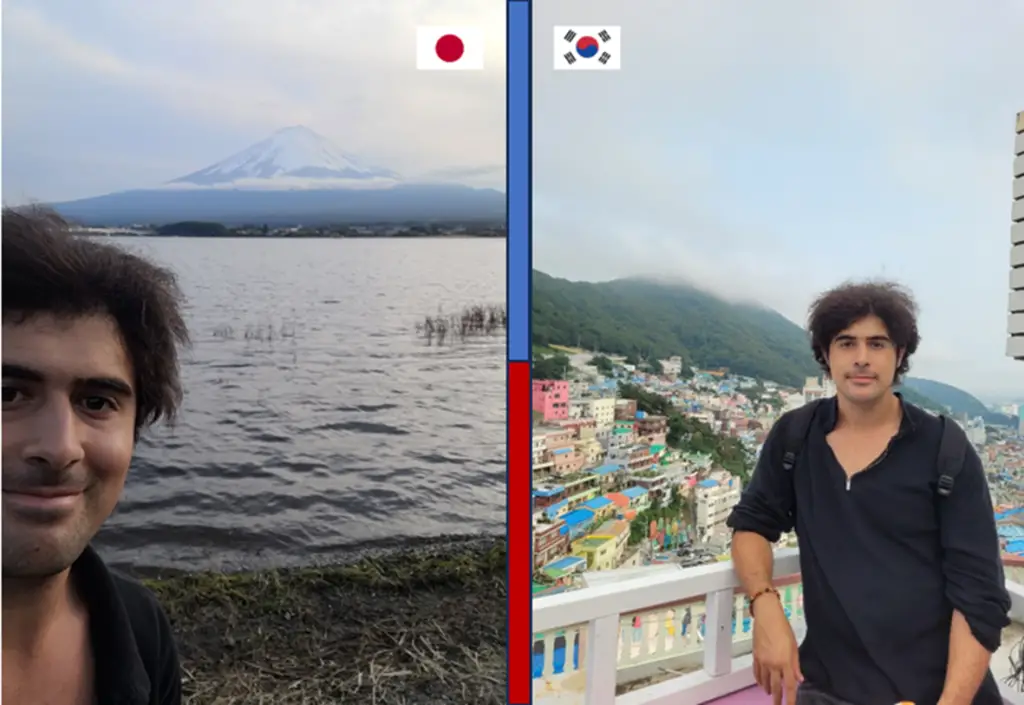
I may be a Japan travel blogger at the moment, but I certainly have no biases when it comes to making comparisons against other countries.
After spending over two weeks in South Korea, I noticed these 5 major differences between Japan and Korea, two countries that I previously believed to be more similar than different.
1. Cultural Norms

Perhaps some may debate this point, but I truly feel Japan is a country of “law abiders” and “rule lovers” more so than anywhere in the world, and yes, that includes Korea.
While I do love the immense respect and polite approach Japanese society has toward just about everything, I do feel they could benefit from a little wiggle room.
On the other hand, it is fantastic to see nobody jaywalking across the street or rushing into train carriages before others have a chance to disembark.
In Korea, I certainly felt the level of “over-the-top” politeness was dialed down compared to Japan, but it wasn’t necessarily a bad thing.
For instance, in Korea, it’s not seen as disrespectful to eat and drink while walking on the streets, and personally, I think that’s great!
Sure, Japan may have cleaner streets because of their strict cultural norms in regard to eating in public, but that also makes Japan feel like a more “judgmental” society in some aspects, resulting in people becoming overly self-aware at times.
In Japan’s defense, however, I prefer its public transport etiquette which I feel Korea lacked, for example, not talking on the phone on trains and obeying the arrow markings on walkways at train stations.

Japan has always been known for its “healthier food” options (though this is certainly not always the case).
The concept of bento boxes has stood the test of time in Japan, typically consisting of rice, vegetables, and various proteins packed with nutrients.
There’s no doubt, Japanese cuisine offers some of the most delicious foods in the world, however, they are also the least tolerant Asian nation when it comes to handling spice.
Finding spicy Japanese food is almost impossible in Japan, as much of their cuisine revolves around the concept of umami or “savory” dishes with a deep flavor.
What I love about Korean food on the other hand is their bold approach to flavors, whether it’s super spicy, super sweet, or a combination of both, they do it right!
Tteokbokki (spicy rice cakes), Korean fried chicken, and Samyang spicy instant noodles are just a few of the many chili Korean foods that pack a flavor punch.
That being said, I definitely felt it was easier to gain weight in Korea given the greater prevalence of heavy flavors and high-calorie dishes, though they do offer their fair share of healthy dishes too (but who can resist a good Korean fried chicken?).

3. Convenience Stores

I always knew that Japan and Korea were both notorious for their amazing convenience stores and the delicious nutritious foods available there.
However, what I didn’t realize was the differences in the prevalence of these stores as well as the differences in what each store offers.
While not by a huge margin, I will say Japan certainly has the edge in having more convenience stores across the country, but Korea isn’t too far behind and certainly bests Western countries like Australia in this regard.
Both countries may have 7-Eleven in common, but Japan has its exclusive Family Mart and Lawson stores while Korea has its exclusive CU and GS25 stores.
7-Eleven or not, I was surprised that Korean convenience stores sold practically no Japanese products whatsoever, but rather, had a Korean equivalent for anything Japan had to offer.
Again, the Korean love of spicy food came into play, offering similar items to Japan such as onigiri rice balls and bento box lunch packs but with sweet and spicy red gochujang sauce added into the mix.

4. Language Barriers

Regardless of whether you visit Japan or Korea (or both), you’ll benefit greatly by learning useful phrases from each language as English is certainly not so common.
However, you are far more likely to come across English-speaking people in Korea than you are in Japan.
On the other hand, Japan’s frequency of katakana, that is, borrowed foreign words does give its society a benchmark of English vocabulary that you can always count on.
For example, tennis is translated as tenisu in Japanese and toilet is toireh, and so on.
In that regard, however, Korea still bests Japan by having even more borrowed English words than Japanese.
Furthermore, American influence on South Korea is far stronger than that of Japan, resulting in many societal attitudes, foods, fashion, and pop culture taking inspiration from the West.
On that note, Korea does maintain a healthy balance between its Eastern tradition and Western influences, making it an attractive destination for just about everyone of all backgrounds.
All-in-all, you’re certainly more likely to find English-speaking citizens and customer service people in Korea than in Japan, so in that regard, it’s more foreigner-friendly !

5. Natural Beauty
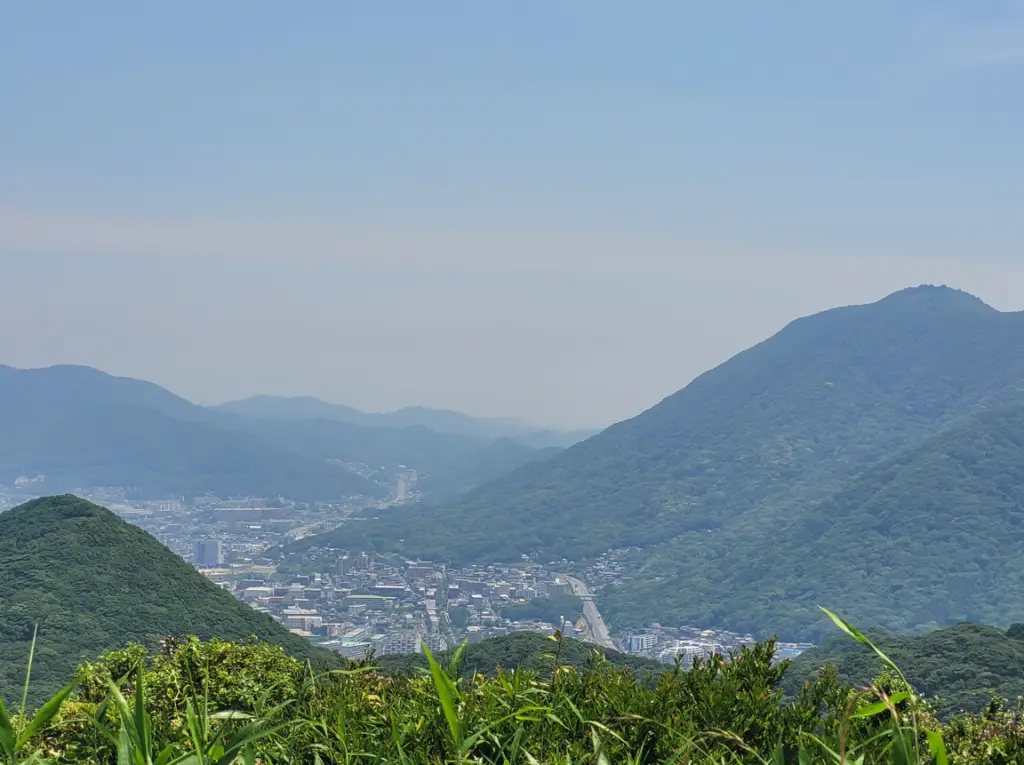
Last but not least, I noticed a subtle but significant difference between Korea and Japan in terms of their individual natural landscapes and scenery.
It’s no secret that both countries are quite mountainous and surrounded by sea, so you’ll find plenty of mountain ranges surrounding the cities of either country.
However, I couldn’t help but notice the mountains had a smoother outline in Japan compared to Korea’s mountains, which seemed jagged and sharper around the corners.
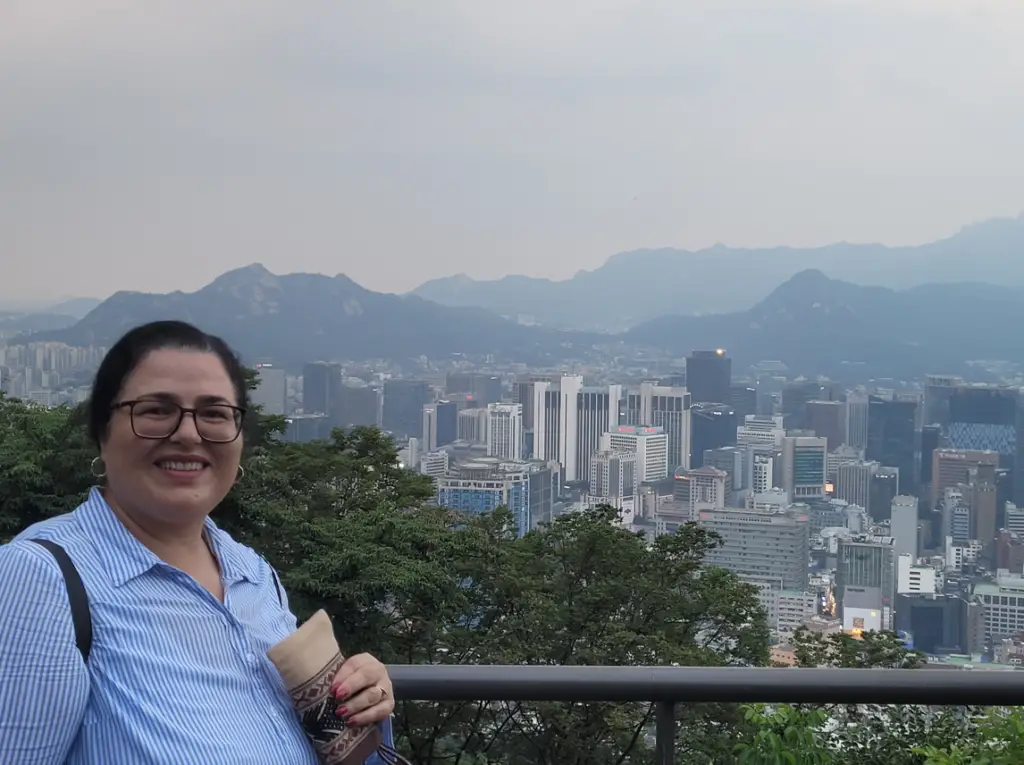
That being said, I don’t necessarily have a preference for one type of mountain range over the other, but it was an interesting observation to make.
Nevertheless, both Japan and Korea are abundant in beautiful natural sceneries from aesthetic mountain ranges to stunning waterways and rich green forests!
Of course, if you are planning to visit Japan, you’ll need a way to get around the country as efficiently and affordably as possible. Japan Rail provides an abundance of travel passes to suit your travel needs. So whether you are traveling individually or as a group, the JR Pass is every traveler’s go-to for getting around and making the most of your time in Japan!
Leave a Reply Cancel reply
You must be logged in to post a comment.
Welcome back!
Save articles to your bucket list and start planning.
By continuing with your action, you agree to Have Halal, Will Travel’s Terms Of Use
Join the community.
Sign up to access your saved articles across all your devices.
Create your account
Password should contain atleast 8 characters with combination of alphanumeric, special characters and one uppercase letter.
Multi Factor Authentication
IF you have need multi face Authentication?
key generated for 2FA. Please verify through QR scan
key generated for 2FA. Please check your mail to get key and manually enter in on Google authenticator app and verify the token
Enter your email and we'll send you a link to reset your password
Enter your new password to reset your password.

- Travel Guide
- South Korea
- Budget Travel
Japan VS Korea: Which Destination Is Better For Budget Travellers?
Cheng Sim • Jun 12, 2023
If you’re standing at the crossroads between a backpacking adventure in Japan and a budget getaway in Korea, you’re not alone. Exploring these high-priced travel destinations on a low budget can take a bit of work, but leave the homework to us! ? With Japan and Korea placed side by side, we cover everything from the array of free attractions to budget shopping to ease your selections. By the end of the article, you will discover one destination that is friendlier to your travel budget.
Follow us on Telegram for the latest updates: https://bit.ly/3LnFN1F
1. Free Attractions
There’s no such thing as a free lunch, but free attractions - yes! In Japan, you can catch a real-life sumo training session, explore the Imperial Palace East Garden with a guided tour, walk amidst the bamboo forest of Arashiyama, discover the old world charm of the Kyoto Imperial Palace, and more without costing any yen – and the list doesn’t stop there! Check out our handy guides to free attractions in Tokyo here .
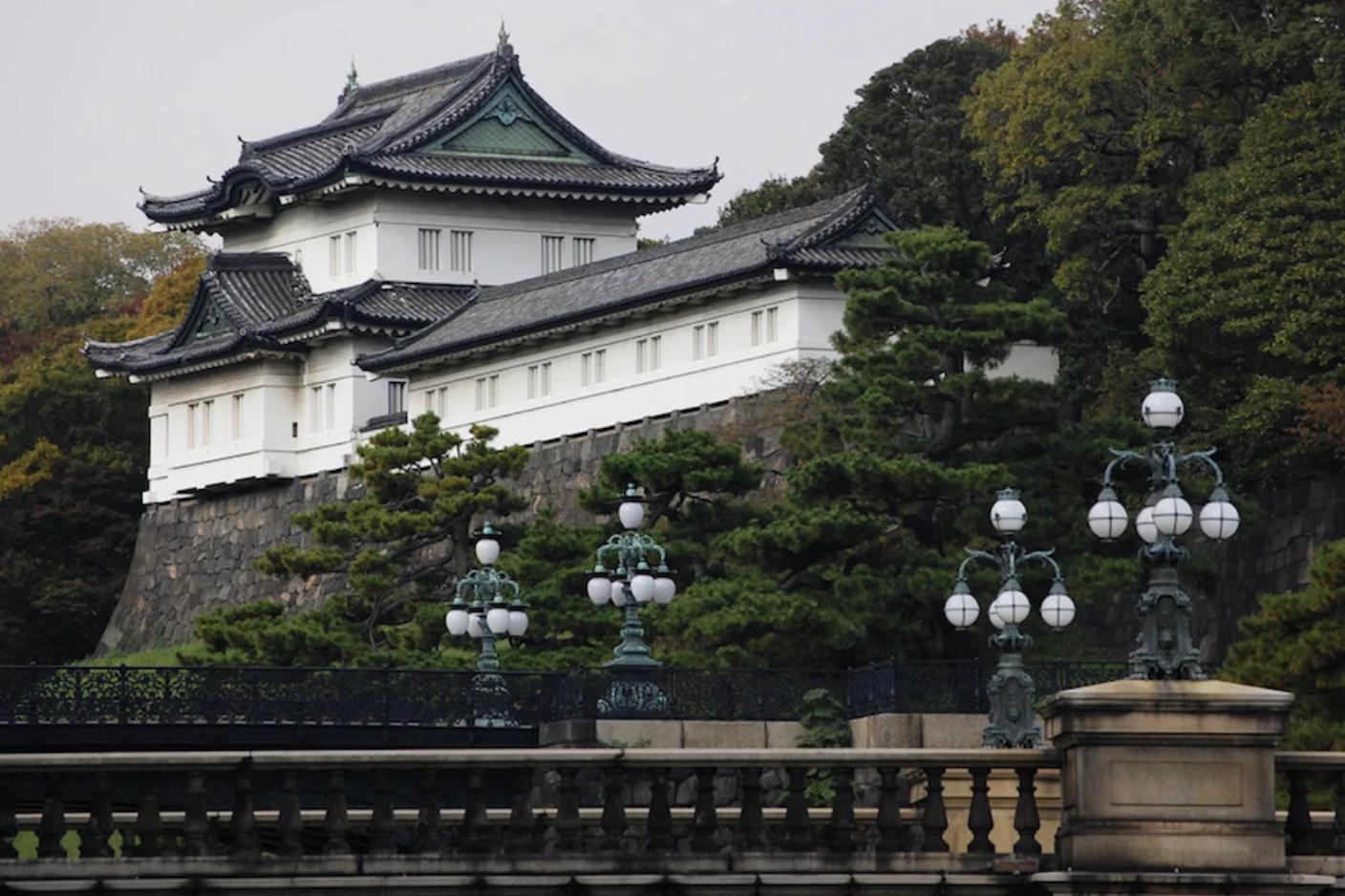
Credit: clio1789 on Flickr
P.S. Conquer Osaka and Nara for just under RM2500 with our budget-friendly itinerary for Muslim travellers!
Brimming with cultural and historical sites, Seoul has a good amount of free attractions to keep your travel itinerary packed too. Our favourite is the free hanbok experience at Seoul Global Cultural Center. Followed by a chance to explore a traditional Hanok village, listen to Seoul-ful stories from the free walking tours, visit the bustling Dongdaemun after sundown, and catch the Seoul Lantern Festival and other festivities. And that is just a summary of our full compilation - check out our round-up of the absolutely free things to do in Seoul near halal food !
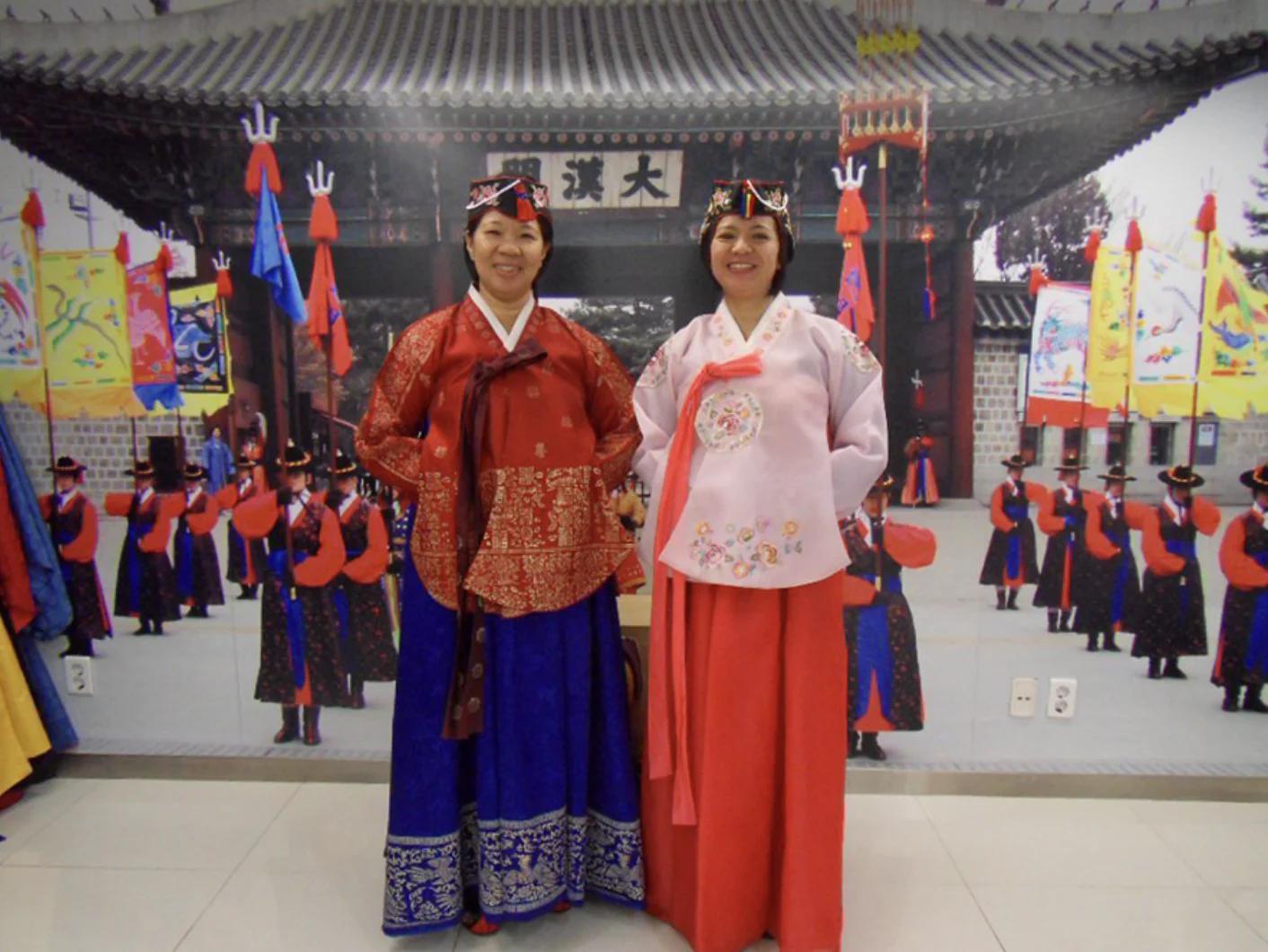
Credit: seoulculturalcenter
P.S. Heading to Seoul but not sure if you can do it on a budget? Our 5D4N Seoul Muslim-friendly itinerary under RM1800 will be perfect for you !
Verdict: Korea may have the upper hand in cultural experiences, but Japan wins this round for the huge amount of free attractions in Tokyo and Kyoto.
Whenever we have the four seasons experience in mind, it’s difficult to shake off Japan from our daydreams. Spring and autumn seasons are the best times to visit Japan, but this advice comes with an entourage of tourist crowds and high priced accommodations. If you’re fine with skipping out on the widely popular cherry blossom and koyo (autumn foliage) season, pay a visit within a week or two after the viewing weeks and public holidays.
But if you're planning to visit Japan during these hugely popular seasons, make sure you check out these tips:
- Muslim-Friendly Guide To Japan's Cherry Blossom Season
- Muslim-Friendly Guide To Japan's Autumn Foliage Season
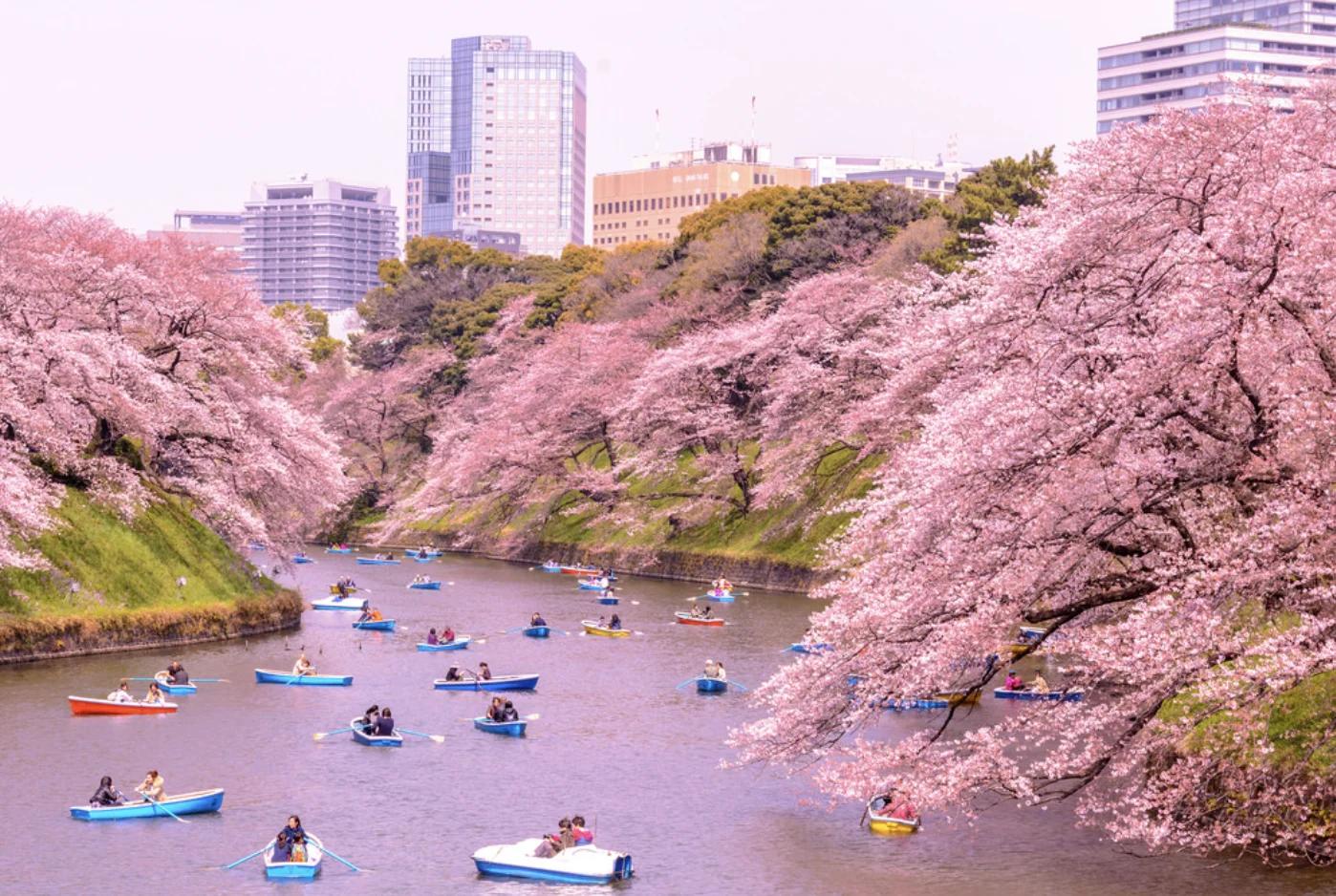
Credit: Yoshikazu TAKADA on Flickr
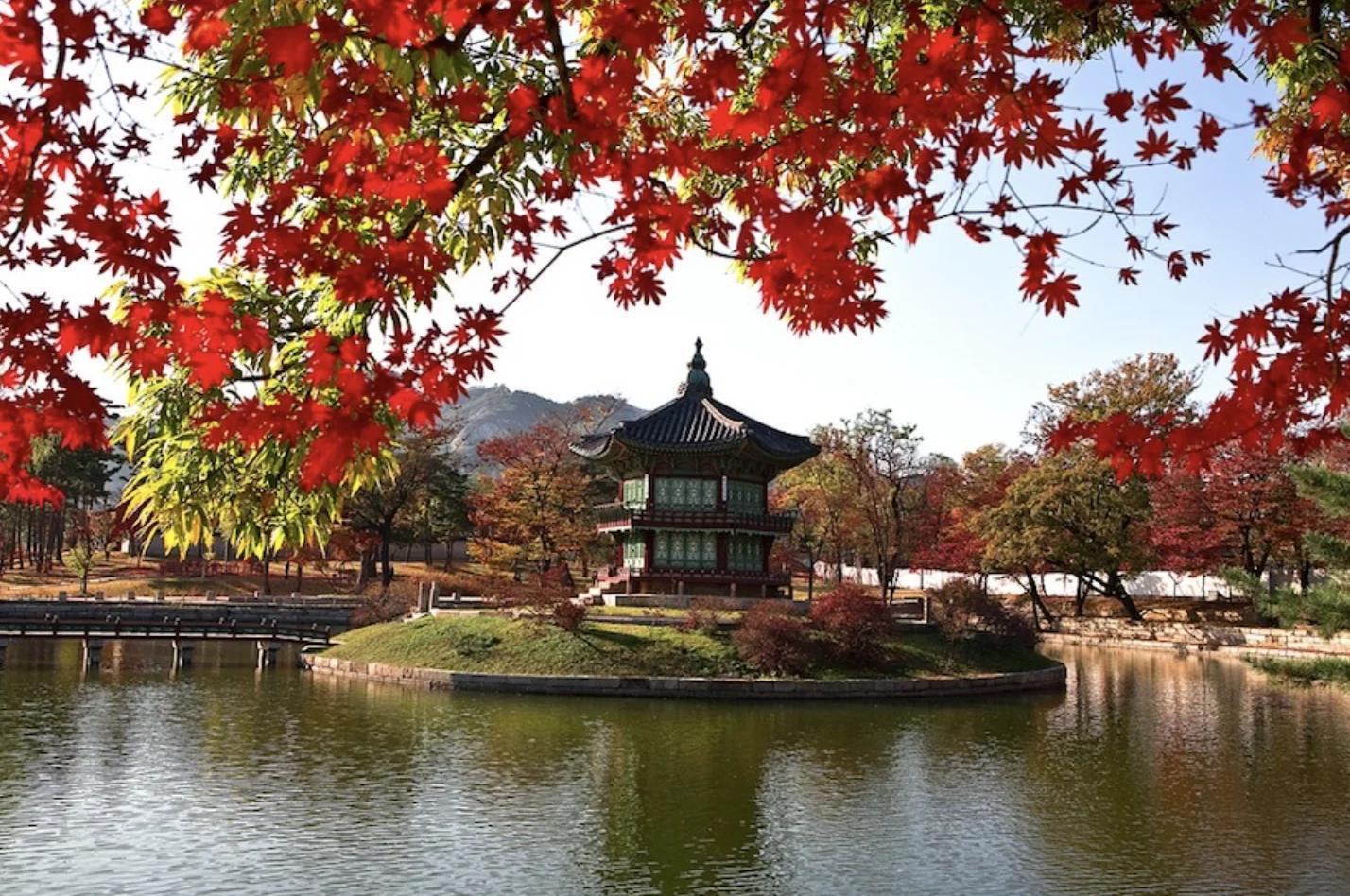
Check out our tips to having your best cherry blossom or autumn experience in Korea:
- Muslim-Friendly Guide To Korea's Cherry Blossom Season
- Ultimate Guide To Autumn Foliage In Seoul
Verdict: Japan may be the ideal destination for spring and autumn, but if you have a budget to care about, the equally beautiful Korea is your best bet.
With manageable flight tickets and accommodation rates, experiencing spring in Korea will be lighter on your pocket compared to Japan. Remember to research and reserve early because the cherry blossom months also remain as everyone’s favourite time to visit Korea. Other affordable months to consider include autumn and winter, where hotel rates and airfare are generally lower. Due to the array of local festivals in the summer, expect to fork out high travel expenses during that season that is subsequently a huge no-no for your tight budget.
3. Accommodation costs
Major cities in Japan are generally known for their expensive hotel rates. If you’re in Tokyo, go for areas such as Ikebukuro and Asakusa for hostels (starting from around USD16/SGD21/MYR66 per night) and budget hotels (starting from USD61/SGD83/MYR256 per night). Spending the night in Kyoto won’t cause a dent in your wallet, especially in areas like Central Kyoto and around Kyoto Station where convenient public transportation is also guaranteed. Hostels are normally priced from USD12/SGD16/MYR50 per night and budget hotels starting from USD35/SGD47/MYR143 per night.
P.S. Looking for affordable accommodation in Tokyo? Check out these 9 affordable Tokyo hotels near halal food for your next vacay !
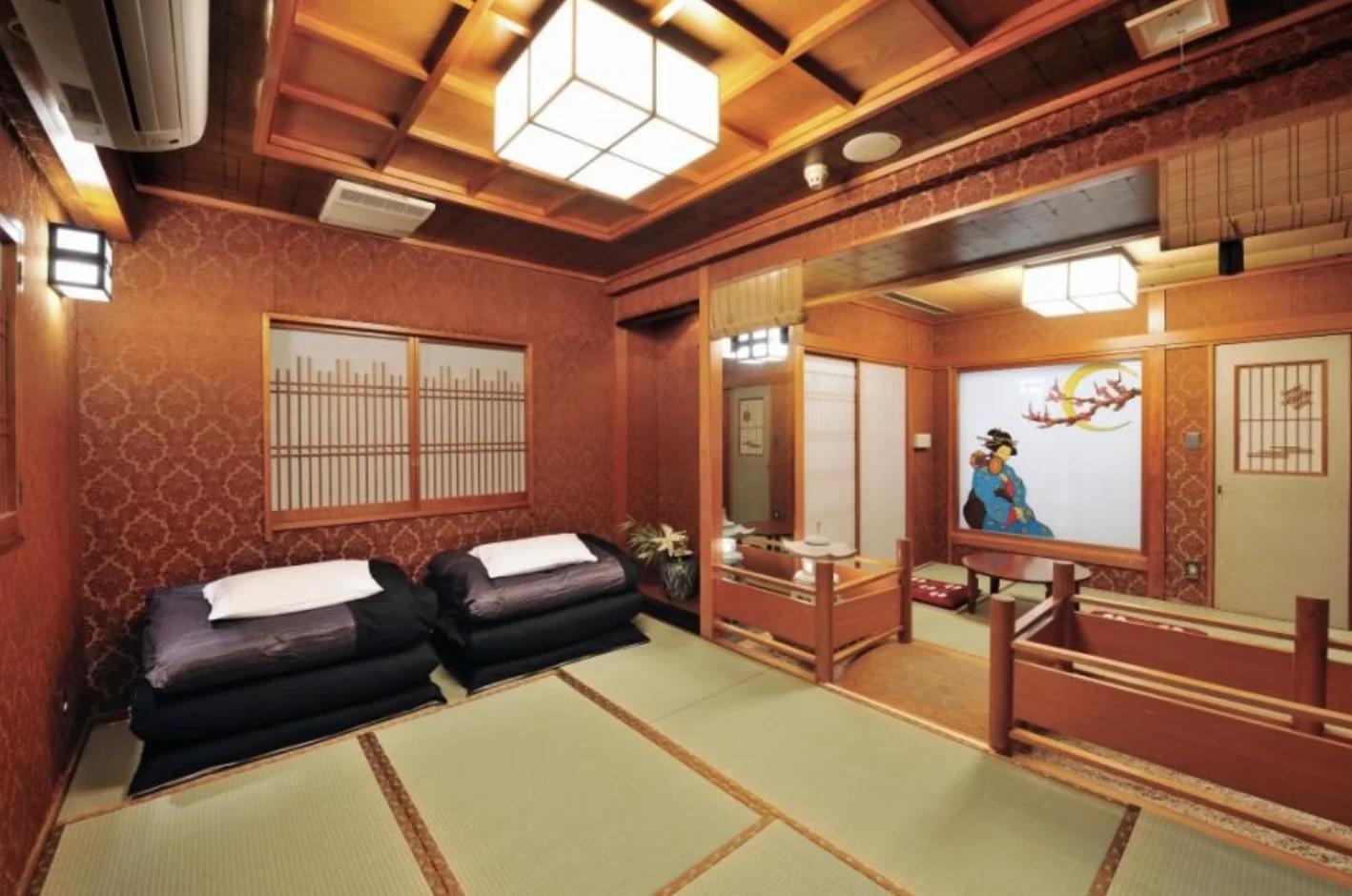
Credit: Khaosan World Asakusa & Ryokan on Facebook
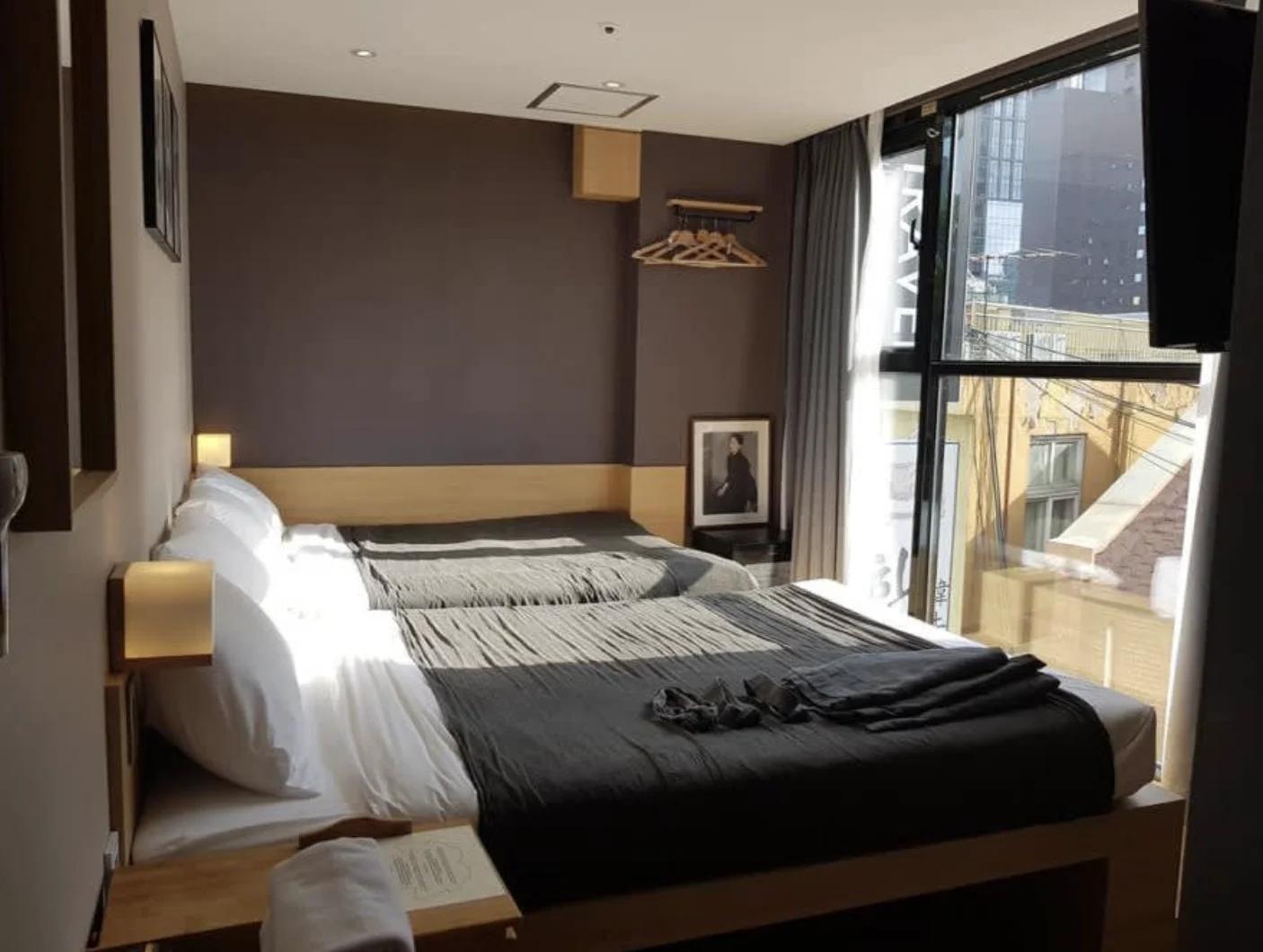
Credit: @artravel.myeongdong on Instagram
Staying the night in a backpackers’ hostel is a true way to keep your accommodation budget to a minimum. When in Seoul, focus on areas such as Dongdaemun, Myeong-dong, Hongdae, and Itaewon for hostels with rates starting from as cheap as USD6/SGD8/MYR25 ? If you’re planning to call it a night in Busan, popular areas such as Jung-gu (starting from USD5/SGD6/RM20 per night) is filled to the brim with affordable hostels, and same goes to Seo-myeon and Sasang-gu for budget hotels (starting from USD7/SGD9/MYR25 per night). Check this link out for 12 affordable accommodations in Seoul near halal food for the perfect stay !
Verdict: It’s a challenge for Japan to shake off their reputation for costly accommodation stays, so it’s pretty easy for Korea to take this category in the bag, in terms of their larger network of budget-friendly stays!
4. Shopping
Never let your tight budget stop you from doing a little shopping on the side. One of the best places to shop cheaply in Japan is the famous Don Quijote (for snacks, electronics, household products, and make-up), Tokyu Hands (for leather goods, packaged food, and cookware), and lastly, Loft (for quirky homewares, stationeries, and accessories). If you have more time on your hands, saunter casually around Tokyo’s Shimokitazawa for a hot cuppa in an indie cafe, as well as window shop in vintage and secondhand shops. Check out our Japan budget shopping guide to get more bang for your buck !
While you're on your shopping spree in Japan, don't forget to drop by one of their many drugstores and get these 16 items!
Korea definitely has the upper hand when it comes to the value-for-money shopping experience, and more so when you’re shopping on a budget. Hit up the flea markets in Seoul such as Seocho Saturday Flea Market (for clothing, books, and household products), Gwangjang Vintage Market (for vintage goods), the Seoul Folk Flea Market (secondhand items, leather goods, hiking/outdoor gear/Korean music CDs) and more. If you want to see what else is in store, check out our guide to 7 shopping hotspots in Seoul near Muslim-friendly eateries !
Similar to most travel destinations in Asia, bargaining is the ultimate rule to stretching your shopping money. Since we have a couple of secrets up our sleeves, here are 11 tips to help you experience the best shopping spree in the shopping area of Myeongdong !
Verdict: This is a tricky round to decide! If you’re a bargain shopper just like us, you will definitely find the utmost pleasure when shopping in both Japan and Korea .
5. Halal Food
Ah, the thought of Japanese food is enough to stir some cravings. Dining shortcuts like Family Mart and Lawson’s Station may offer very little Muslim-friendly meals, but there’s a lot of halal ramen (starting from JPY750/SGD9.50/MYR29), yakiniku (starting from JPY3000/SGD37/MYR114 per set), sushi set (starting from JPY2400/SGD30/MYR92 per set) and udon noodles (starting from JPY400/SGD5/MYR15) waiting out there. Just throw your diet out of the window and fill your tummy with the help of these guides:
- Guide to Halal Japanese food in Tokyo
- Guide to Halal Japanese food in Kyoto
- Guide to Halal Japanese food in Osaka
Rule of thumb: Lunch sets are typically priced lower than the average dinner menu. For instance, some sushi sets can go as low as JPY1300/SGD16/MYR50 Feel free to indulge in your mid-day meals and save up during dinner!
Otherwise, if you're really on a tight budget and don't wish to spend a lot on dining in a restaurant, then check out these 9 Muslim-friendly Japanese convenience store snacks that'll surely fill you up as you travel around Japan!
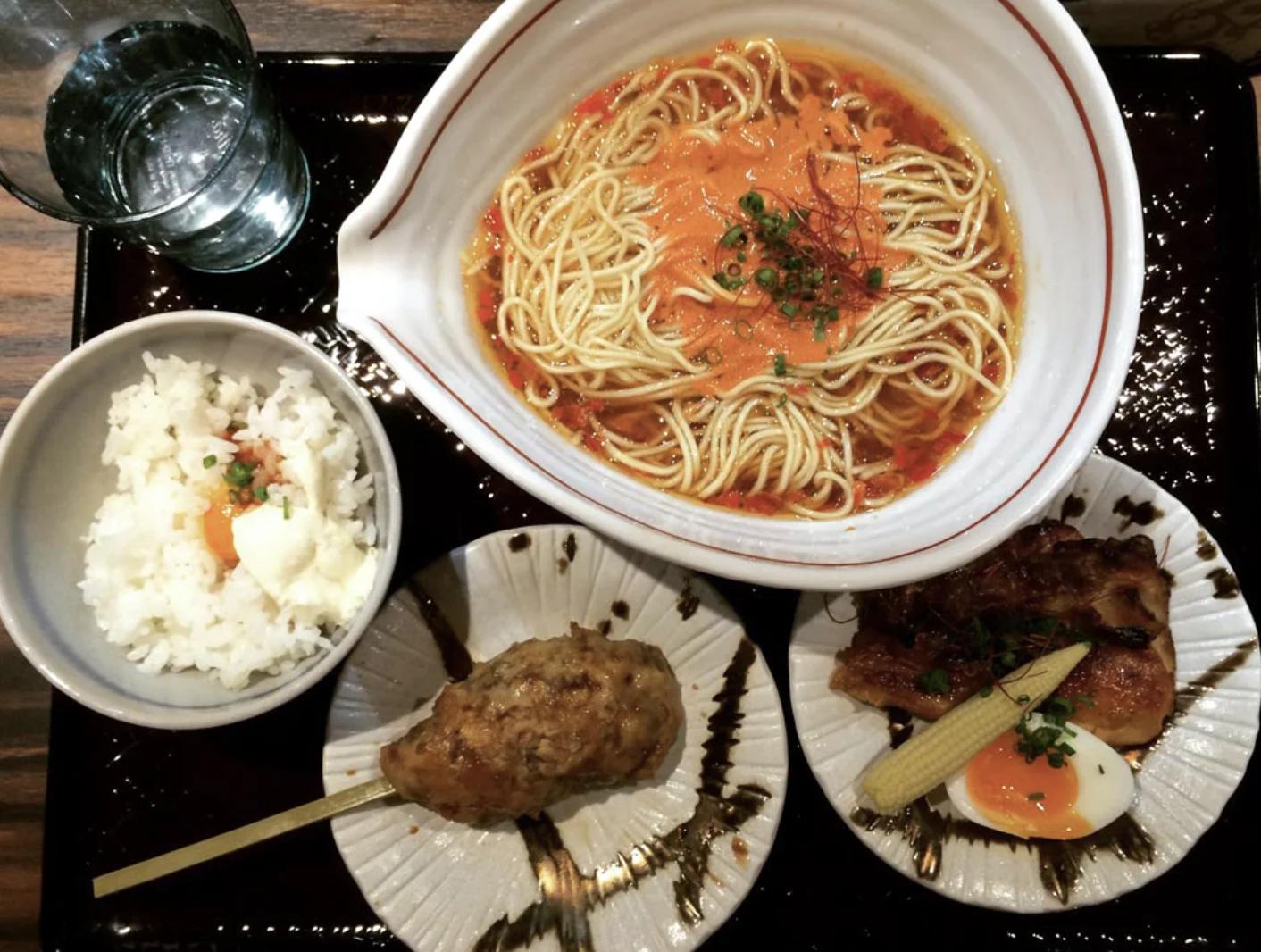
If you’re feeling famished in Korea, always remember that there’s a halal yeoipbap (lotus leaf rice), tteobbokki (soft rice cakes), and patbingsu (shaved ice dessert) lurking around the corner. The Muslim-friendly meal options may not be as many as Japan’s and if you're in Seoul, halal food options are mostly concentrated around the Itaewon area. Check out these halal food guides in major Korean cities before your visit:
- Guide to Halal Korean food in Seoul
- Guide to Muslim-friendly eateries in Jeju
- Guide to Muslim-friendly eateries in Busan
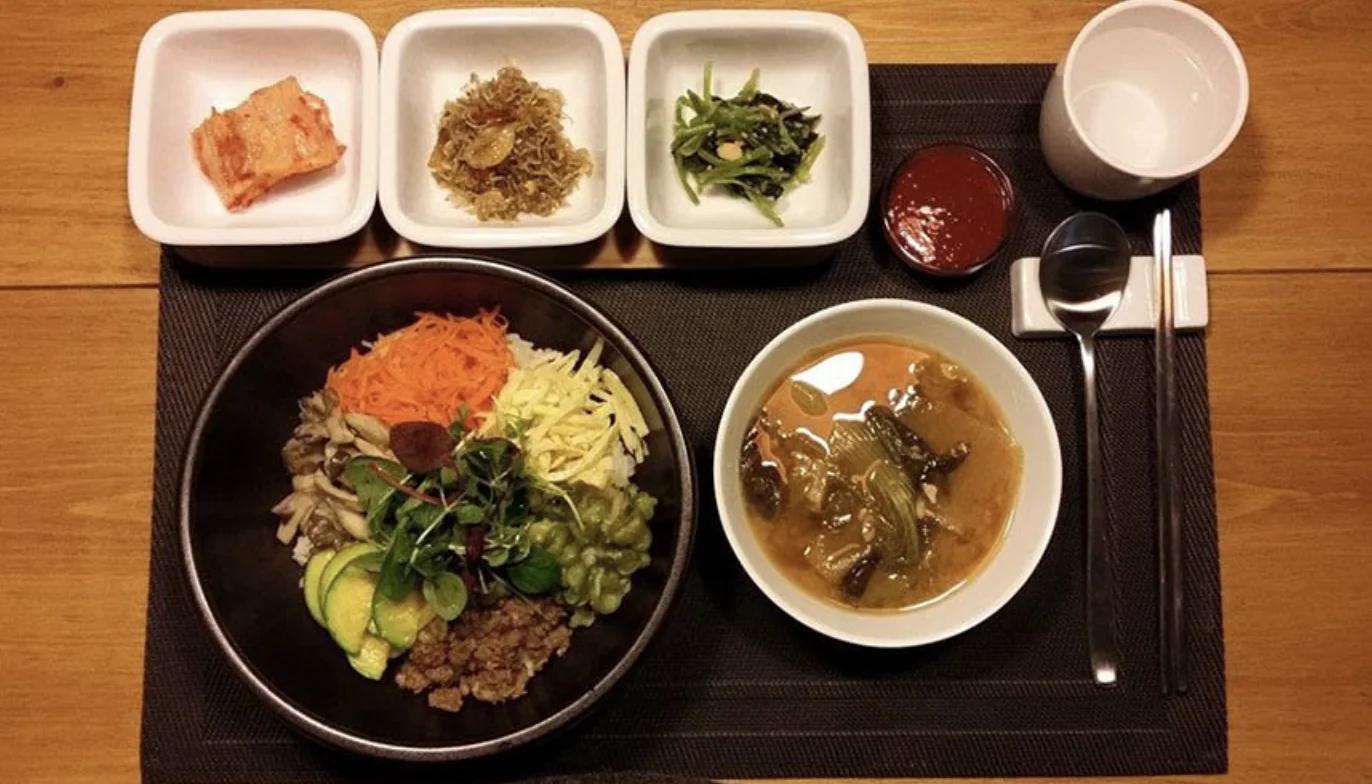
Credit: Eid Halal Korean Food on Facebook
For those of you who still think that dining in a restaurant can be pretty expensive, fret not! Spend your moolahs on one of these 15 Muslim-friendly Korean street snacks which are not only cheap but filling too. Or else, you can also pop by any of the many convenience stores around Korea to fill your tummy with these Muslim-friendly convenience store snacks !
Verdict: Considering the variety of Muslim-friendly local dishes and its affordability, Japan definitely takes the lead on this one.
Scoring an affordable flight ticket to Japan and Korea can be tricky because they aren’t generally cheap. However, with the right tools and a bit of luck, you can maximise your chances of snagging a good deal. Look out for mobile apps like Google Flights, Kayak or Skyscanner for trusty flight promotions. Of course, we have more secret hacks to uncover right here .
While a flight ticket to Japan in 2023, can be really pricey, If you have Tokyo in mind for your Japan trip and are travelling from Kuala Lumpur, July (starting MYR504/one way) has lower airfare prices on average while December and Mar/Apr can be rather expensive with one-way tickets costing MYR600-800+. For those travelling from Singapore to Tokyo, September seems to be the cheapest month with one-way tickets selling from just around SGD200. June, March and April can be quite expensive with one-way tickets costing at least SGD270 or even more.
Planning to go Osaka instead? The flight fares from Kuala Lumpur are known to be the cheapest in September , starting from MYR399 one-way. December and April seem to be the most expensive months, with prices hovering around MYR700-800 one-way.
If you're travelling from Singapore to Osaka, October seems to be the cheapest month with one-way flight prices starting from SGD172. March to June (spring to summer) seems to be a more expensive season as prices for one-way tickets start from SGD240 and can go as high as SGD300-400.
Travelling from Kuala Lumpur to Seoul, the months of July-August and October are the cheapest (around MYR364/one-way) while Dec and April-June are the more expensive months where flight prices can go for at least MYR600/one-way. If you’re travelling from Singapore to Seoul, September is the cheapest month with prices starting from SGD179/one-way. This is great because the heat of summer would be winding down so the weather will be pretty cooling before autumn kicks in. Try to avoid the months of December, Mar/Apr and June as prices are more than SGD230 one-way.
If you're from Kuala Lumpur and travelling to Busan, we recommend picking April as prices are the cheapest around MYR460/one-way while in May and June, prices tend to be from MYR580-700/one-way. Flight prices from Singapore to Busan are the cheapest in September, around SGD200/one-way while prices in June are the most expensive, starting from around SGD250/one-way.
For those heading to only Jeju, there's a direct flight from Kuala Lumpur to Jeju and the cheapest month is July with prices starting from MYR326/one-way while prices in December can be as high as MYR800/one-way.
Verdict: If you would like to maximise your chances of experiencing spring and autumn, the steady flight rates to Korea will keep your holiday affordable.
Japan and Korea may have a reputation for being one of the most expensive travel destinations, but vacationing on a budget is certainly doable with helpful research. It’s a tight comparison and judging from the verdicts alone, Korea leads only by a slight margin with affordable seasonal rates, accommodation costs, budget shopping, and yearly flight fares on their side. However, if you’re a traveller who can’t resist the temptation of local cuisine and free sightseeing tours, Japan may be the one for you.
Save to Bucket List

South Korea & Japan
Plus osaka world expo.
- INFORMATION
- Dates May 6 - 22, 2025
- Price From $ 8,995
- Deposit $ 600
- Trip Type History , Land , Nature
- Operator AHI Travel

- Contact Us [email protected]
- View Brochure Details
Experience the allure of South Korea and Japan on a first-class, 14-night adventure that features the highlights of Seoul, Busan, Kyoto and Tokyo!
- Included South Korea & Japan
FROM OUR GALLERY
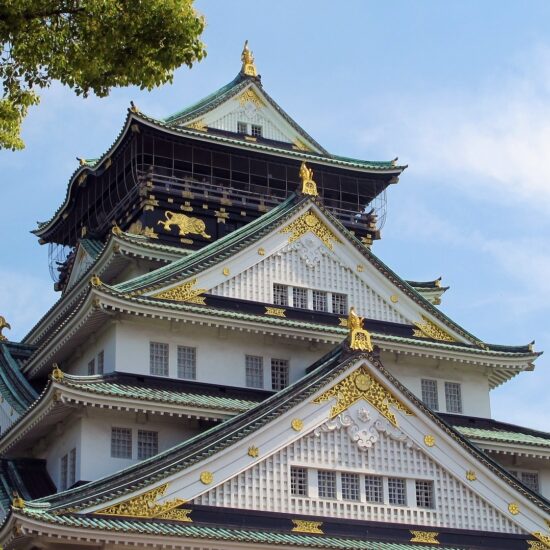
- Foreign Affairs
- Multicultural Community
- Environment & Animals
- Law & Crime
- Health & Science
- Cryptocurrency
- Thoughts of the Times
- Today in History
- Tribune Service
- Blondie & Garfield
- Letter to the Editor
- Travel & Food
- People & Events
- Around Town
- Fortune Telling
- Shows & Dramas
- Theater & Others
- Korean Storytellers

Japan's defender Riku Handa, second from left, heads the ball during the AFC U23 Asian Cup Qatar 2024 Group B match between Korea and Japan at Jassim Bin Hamad Stadium in Doha on April 22. AFP-Yonhap
Korea defeated Japan 1-0 in their final group stage match at the Olympic men's football qualifiers in Qatar on Monday, extending their winning streak to three as they gear up for the knockout phase.
Substitute Kim Min-woo headed home the match's lone goal in the 75th minute of the final Group B match at the Asian Football Confederation (AFC) U-23 Asian Cup at Jassim bin Hamad Stadium in Al Rayyan, just west of Doha, and sent Korea into the quarterfinals with an unblemished record.
Both teams had already secured their quarterfinals berths as the top two teams of Group B by winning their first two matches. They were fighting for the top seed Monday. As the winner of Group B, Korea will face Indonesia, the Group A runner-up, in the quarterfinals at Abdullah bin Khalifa Stadium in Doha. The kickoff is 8:30 p.m. Thursday local time, or 2:30 a.m. Friday in Korea.
Coached by Hwang Sun-hong, Korea earlier defeated the United Arab Emirates 1-0 and then China 2-0.
It will be the first must-win match of the competition for Korea as they try to extend their Olympic appearance streak to 10. This AFC tournament doubles as the qualifying event for the Paris Olympics. The top three teams -- the two finalists and the winner of the third-place match -- will grab tickets to France, with the fourth-place team taking on Guinea in an intercontinental playoff later. This means Korea will have to reach at least the semifinals to have a shot at earning an Olympic spot.
Indonesia, coached by former Korea boss Shin Tae-yong, lost to Qatar 2-0, but later defeated Australia 1-0 and Jordan 4-1 to advance to the quarterfinals.
The Korea-Japan showdown was scoreless after an uneventful first half, with neither team registering a shot on target despite some dangerous-looking forays into the opposing boxes.
Korea had one close call in the 44th minute, when Hong Yun-sang took a right-footed shot inside the six-yard box as he fell down but missed the net to the right.

Japan's midfielder Satoshi Tanaka, center, vies against Korea's midfielder Kim Dong-Jin, right, and defender Hong Yun-sang for the ball during the AFC U23 Asian Cup Qatar 2024 Group B match between Korea and Japan at Jassim Bin Hamad Stadium in Doha on April 22. AFP-Yonhap
The teams picked up pace in the second half, and Kim broke the deadlock in the 75th minute with his first goal of the tournament.
Lee Tae-seok took the corner kick from the right side, and Kim soared above defender Riku Handa to meet the ball with his head and put it past goalkeeper Taishi Brandon Nozawa.
Japan ratcheted up their offensive pressure in search of the equalizer. In a hectic sequence during the 83rd minute, Korean defender Lee Jae-won threw his body around in the box to block multiple shot attempts by Japan and keep his team ahead.
Moments later, Joel Fujita had an open look from the center of the box, but Jang Si-young deflected the ball out of harm's way.
And about seven minutes into added time, Japanese sub Kein Sato struck the left post with a header for his team's closest call in late moments. (Yonhap)

Japan's defender Riku Handa, right, and Korea's midfielder Hong Yun-sang vie for a header during the AFC U23 Asian Cup Qatar 2024 Group B match between Korea and Japan at Jassim Bin Hamad Stadium in Doha on April 22. AFP-Yonhap

World Water Day 2024
Busan World Team Table Tennis Championships Finals
Super Bowl 2024
Welcoming Lunar New Year around world
Daily life in Afghanistan under Taliban rule
Are you lost? See if these links help.
Other popular searches
Social Channels
- Tottenham Hotspur on Facebook
- Tottenham Hotspur on X (formally Twitter)
- Tottenham Hotspur on Instagram
- Tottenham Hotspur on YouTube
- Tottenham Hotspur on Tiktok
- Tottenham Hotspur on Threads
- Tottenham Hotspur on WhatsApp
- Tottenham Hotspur on Snapchat
- Tottenham Hotspur on Naver
- Tottenham Hotspur on Weibo
- Tottenham Hotspur on Bilibili
- Find Tottenham Hotspur on WeChat
Sites & Languages

#ClubAnnouncement #Men'sFirstTeam #PreSeason #VisselKobe
Club to visit Japan this summer as part of pre-season tour
The Club is delighted to announce it will be returning to Japan for the first time in 33 years this summer.
We will play reigning J1 League champions Vissel Kobe at the Japan National Stadium on Saturday 27 July as part of our preparations for the 2024/25 season.

• Tottenham Hotspur will play reigning J1 League champions Vissel Kobe at the Japan National Stadium on Saturday 27 July • The visit will be the Club’s first to Japan in 33 years, during which it will engage with its fanbase, support good causes, deliver grassroots football programmes and celebrate local culture • Further pre-season tour details and ticketing information will be announced in due course
The Club first visited Japan in 1971, when we embarked on a post-season tour to play three matches against an All Japan XI in our first visit to Asia. The last visit came in 1991 after having won the FA Cup when we took part in the Kirin Cup.
As is Club tradition, players and staff will be engaging with our fans, supporting good causes, and celebrating local culture throughout our time in Tokyo. This will include meeting with our three Official Supporters’ Clubs representing Japan: Japan Spurs, Osaka Spurs & Kobe Spurs.
Alongside this, the Club’s Global Football Development coaches will deliver our renowned technical programme for local young players and coach education workshops, showcasing the authentic training methods developed within the Club’s Academy, helping young players to reach their full potential.
The visit will also see Head Coach Ange Postecoglou return to the country where he achieved enormous success during his spell in charge of Yokohama F. Marinos, whom he led to the J1 League title in 2019.
Ange said: “I’m delighted to be taking Tottenham Hotspur to Japan this summer for an exciting fixture against Vissel Kobe. This friendly will be another step in our preparations for the 2024/25 season.
“Japan is a country I know well from my time managing there. It is full of passionate football fans and I’m looking forward to the players not only sampling the atmosphere of the Japan National Stadium but also experiencing some local culture and supporting good causes while we are there.”
Fans can keep up to date with the latest news about our 2024 pre-season tour on our dedicated tour hub.
Further details regarding fixtures, additional tour locations and ticket on-sales will be announced in due course, along with information about how fans can watch matches and tour content.

Stay up to date

US envoy to the UN vows support for families of Japanese who were abducted and taken to North Korea
T OKYO (AP) — The United States ambassador to the United Nations said Thursday that America will stand with Japan until all the Japanese abducted by North Korea decades ago return home to end their painful separation.
Linda Thomas-Greenfield made the comments on Thursday as she began her visit to Tokyo by meeting with the families of those kidnapped.
Japan says North Korea abducted at least 17 Japanese citizens, possibly many more, to train them as agents during the 1970s and 1980s. After admitting in 2002 it had abducted 13 Japanese, North Korea apologized and allowed five to return home for a visit. They have since stayed in Japan. Pyongyang said eight others had died and denied that the other four entered its territory and never provided a reinvestigation it has promised.
The twelve who are still missing include teenage students and others living along Japan’s coasts. Many were bundled into small boats and taken across the sea to North Korea.
“The United Stats stands with all the families, with all of Japan and with the international community in pressing for a resolution that will allow all families separated by the regime’s policies to be reunited,” Thomas-Greenfield said at the outset of her meeting with five relatives of the abductees and a representative from their support group at the Prime Minister’s Office.
“I’m all too familiar with the pain and the loss and the suffering that you family members here are experiencing,” she said. “I know how painful it is for you, and then how long you have had to endure this pain.”
Thomas-Greenfield said she has worked on North Korea-related issues throughout her career.
U.S. President Joe Biden’s administration is committed to raising the abduction issue “at every opportunity and calling for the return of abducted Japanese citizens to their family,” the ambassador said, adding that America sticks to that policy regardless of the leadership.
Japanese Prime Minister Fumio Kishida has repeatedly stated his determination to hold a summit with North Korean leader Kim Jong Un to achieve the return of the abductees.
Experts say Kim wants improved ties with Japan to drive a wedge between the United States and its allies, while Kishida, stung by a major corruption scandal in his governing party, wants to use possible progress in the abduction issue to turn around his dwindling support ratings at home. They say a summit, however, would be difficult because Japan cannot accept the preconditions set by Pyongyang in order to resolve the abduction issues.
Sakie Yokota, 88, whose then-13-year-old daughter, Megumi, was abducted in 1977 from Japan’s northern coast on her way home from school, told Thomas-Greenfield that she, her husband and Megumi’s brothers searched for her for 20 years until they found out she was abducted. They are still waiting to reunite with her, she said.
“All I want is to see her, while I’m still well,” Yokota said, beseeching the ambassador for continued support toward resolving the problem.
Thomas-Greenfield arrived in Tokyo after her earlier visit to Seoul, where she and South Korean officials discussed a new mechanism for monitoring North Korea’s nuclear weapons program . Russia and China have thwarted U.S.-led efforts to step up U.N. sanctions on North Korea over its ballistic missile testing since 2022, underscoring a deepening divide between permanent Security Council members over Russia’s war on Ukraine.
The United States, South Korea and Japan have been deepening security ties amid growing tensions in the region from North Korea and China. The three countries have expanded their combined military exercises and their deterrence strategies built around U.S. strategic assets.
Associated Press writer Kim Tong-hyung in Seoul, South Korea, contributed to this report.


IMAGES
VIDEO
COMMENTS
Japan is almost four times bigger than South Korea. And while there's arguably more to see in Japan overall, that's part of the problem. Itinerary planning is a headache, and getting around is expensive. No such worries apply in South Korea, however. You can travel the length of the country - from the electric capital Seoul to the ...
Knowledge Base. Deciding between a trip to Japan or Korea can be quite a pickle! Both countries offer rich cultural experiences, delicious cuisine, and unique attractions. It's like choosing between two equally tempting dishes on a menu. Japan, known for its blend of tradition and tech, offers a journey into the future and the past all at once.
During this time, crowds, hotel accommodation, and temperatures are at an all-time high. The best time to visit South Korea is in spring and fall. Crowds are much lower than the peak season and weather is overall quite pleasant. Hotel rates are also much more reasonable. Spring: March, April and May.
May 25, 2023. With the rise of the Hallyu wave and the sustained popularity of Japanese culture globally, it's no wonder that you're torn between choosing South Korea or Japan for your next travel destination. Both countries offer unique experiences, brimming with rich history, diverse cuisines, stunning landscapes, and vibrant modern culture.
Visit traditional villages in both countries, interact with locals, and see the World Natural Heritage on Jeju Island. Here is a hand-picked itinerary summary with more detail following: Days 1-3: Tokyo, Japan. Days 4-6: Takayama, Shirakawa-go, Kanazawa. Days 7-9: Kyoto. Day 10: Osaka, fly to Seoul in South Korea.
Here is the handpicked itinerary, for inspiration: Days 1-3: Seoul in South Korea. Day 4: Gyeongju. Days 5-7: Fly to Osaka in Japan and then take the Shinkansen to Kyoto. Days 8-9: Hakone. Days 10-12: Tokyo. Start your wonderful trip in the energetic capital city of Seoul, South Korea.
The verdict. Japan and South Korea might be similarly located in Asia, but they couldn't be more different, and to be honest, choosing between the two is pretty much impossible. Both countries offer incredible experiences thanks to their respective cultures, cuisines, and attractions - in fact, you can't really go wrong with either of them.
10 days, two weeks, or even one month of travel to South Korea or Japan can really add to your travel budget. Accommodation is often cheaper in South Korea compared to Japan ($48 vs. $58). Budget travelers usually stay in less expensive hostels and guest houses, while nicer hotels often appeal to families and upscale travelers.
East Asia, a region renowned for its rich cultural tapestry and stunning landscapes, presents two of its most distinguished travel gems: Japan and Korea. The 'Japan vs Korea' debate is more than just a comparison; it's a celebration of what each country uniquely brings to the table for travelers seeking diverse experiences.
The travel time takes about 21 hours, and the ports are between Busan, South Korea to Hakata/Fukuoka, Japan. You can choose from two companies: Kampu Ferries and Camellia Line Ferries. However, in 2019, Kampu Ferries limited their services to Japanese nationals. You can read more information here.
Overall, Japan is a more popular and iconic adventure destination, as it includes the impressive Mount Fuji, the tall Japanese Alps, and offers a greater range of winter sports activities. However, South Korea still has plenty of amazing national parks, with beautiful protected mountains, and it tends to be cheaper to visit.
the japanese subway system is not the most straight forward in the world (pretty convoluted imo) though not impossible to figure out. korea is a lot easier to get around especially in bigger cities like seoul or busan. from my experience, it is a lot less common for people in japan to be able to help you out in english than it is in korea ...
Japan and Korea are two of the hottest travel destinations lately, and for good reasons. Despite being geographically close to each other, they offer very different tourist experiences, calling for a visit to both the countries at least once in your lifetime. However, when you only have so little time and so little money, you've got to choose.
In general, I would say that the shortest itinerary you can get away with for your first trip is 3 weeks in Japan vs about a 10 days in Korea itinerary. Naturally, this element of Japan vs Korea travel becomes less important if you've already visited either country, or if you're 100% sure you'll be able to return to either (or both) in ...
Tourism Japan vs Korea. Japan has many more tourists than Korea, even with the recent Korean wave (Hallyu) and its recent popularity. Tourism to Japan is also increasing because it is more affordable. In the last pre-Covid Year, 2019, South Korea received 17.5 M visitors while Japan had almost 33M
This is because South Korea experiences a cool effect by being attached to the Asian continent while Japan doesn't as it's an island. If you're planning to visit either Tokyo or Japan between November and March you can expect Seoul to be between 3 and minus 6 Celsius while Tokyo will be between 4 and 10 Celsius. Seoul vs Tokyo - The Verdict
For some great organized tour ideas, see The Best Family-Friendly Tours to South Korea, The Best Adventure Tours to South Korea, The Best 2-Week Tours in Japan, and The Best Bicycle Tours in Japan. Which place is cheaper, Tokyo or Seoul?
South Korea is relatively less expensive than Japan for a similar type of travel experience. You can travel on the cheap in Japan, but IMHO it's easier to do it in South Korea. The street food scene is also far more developed in South Korea. In Japan, there are excellent food markets in most major cities. But in South Korea, food stands are ...
After spending over two weeks in South Korea, I noticed these 5 major differences between Japan and Korea, two countries that I previously believed to be more similar than different. 1. Cultural Norms. Perhaps some may debate this point, but I truly feel Japan is a country of "law abiders" and "rule lovers" more so than anywhere in the ...
The reason why I would choose Japan first is because there is a lot of traditional culture and customs for Japanese people that cannot be experienced in Korea. From what you have written about yourself, travelling style and interests, I think should go with Japan first. Japan: Plan a 2-week trip to Osaka and Himeji.
Final Verdict: Korea. Gyeongbukgung ( Thomas Park) While it's clear that Korea is the final winner for budget travellers, Japan and Korea are both beautiful countires to visit regardless of season. If you're still having troubles on picking which country to visit, take a look at some of the travel activities available in Japan and Korea.
Japan and Korea may have a reputation for being one of the most expensive travel destinations, but vacationing on a budget is certainly doable with helpful research. It's a tight comparison and judging from the verdicts alone, Korea leads only by a slight margin with affordable seasonal rates, accommodation costs, budget shopping, and yearly ...
Vibrant South Korea & Japan beckon for this 1st-class, 14-night adventure! See the top highlights of Seoul, Busan, Kyoto & Tokyo. Travel via high-speed bullet train, explore the Osaka World Expo 2025 & visit amazing palaces, shrines, temples & pagodas!
584 Likes, TikTok video from Sonsern Lin (APPA) (@hungryoc): "Japan vs Korea, which country you want to visit? #hungryfam #tastetest #foodreview #eatwithme #conveniencestore #conveniencestorefood #foodvlog #foodadventure". foodtiktok. original sound - Sonsern Lin (APPA).
FULL TIME ⏱️ 90+10' Japan U23 0-1 Korea Republic U23. 90+8' Hwang Jae-Won (Korea Republic U23) wins a free kick in the defensive half. 90+7' Kein Sato (Japan U23) hits the left post with a ...
In November 2023, when the foreign ministers of China, Japan, and South Korea finally met after a four-year hiatus in trilateral cooperation, hopes were high for the long-awaited Northeast Asia ...
Japan shines Seven of Skytrax's top 20 airports are in Asia. Both of Tokyo's hubs, Haneda (HND) and Narita (NRT), landed in the top 10, with Haneda one spot ahead of its sibling airport in fourth.
Korea defeated Japan 1-0 in their final group stage match at the Olympic men's football qualifiers in Qatar on Monday, extending their winning streak to three as they gear up for the knockout phase.
The Club first visited Japan in 1971, when we embarked on a post-season tour to play three matches against an All Japan XI in our first visit to Asia. The last visit came in 1991 after having won the FA Cup when we took part in the Kirin Cup. As is Club tradition, players and staff will be engaging with our fans, supporting good causes, and ...
Japan says North Korea abducted at least 17 Japanese citizens, possibly many more, to train them as agents during the 1970s and 1980s. ... Thomas-Greenfield began her Japan visit by meeting with ...